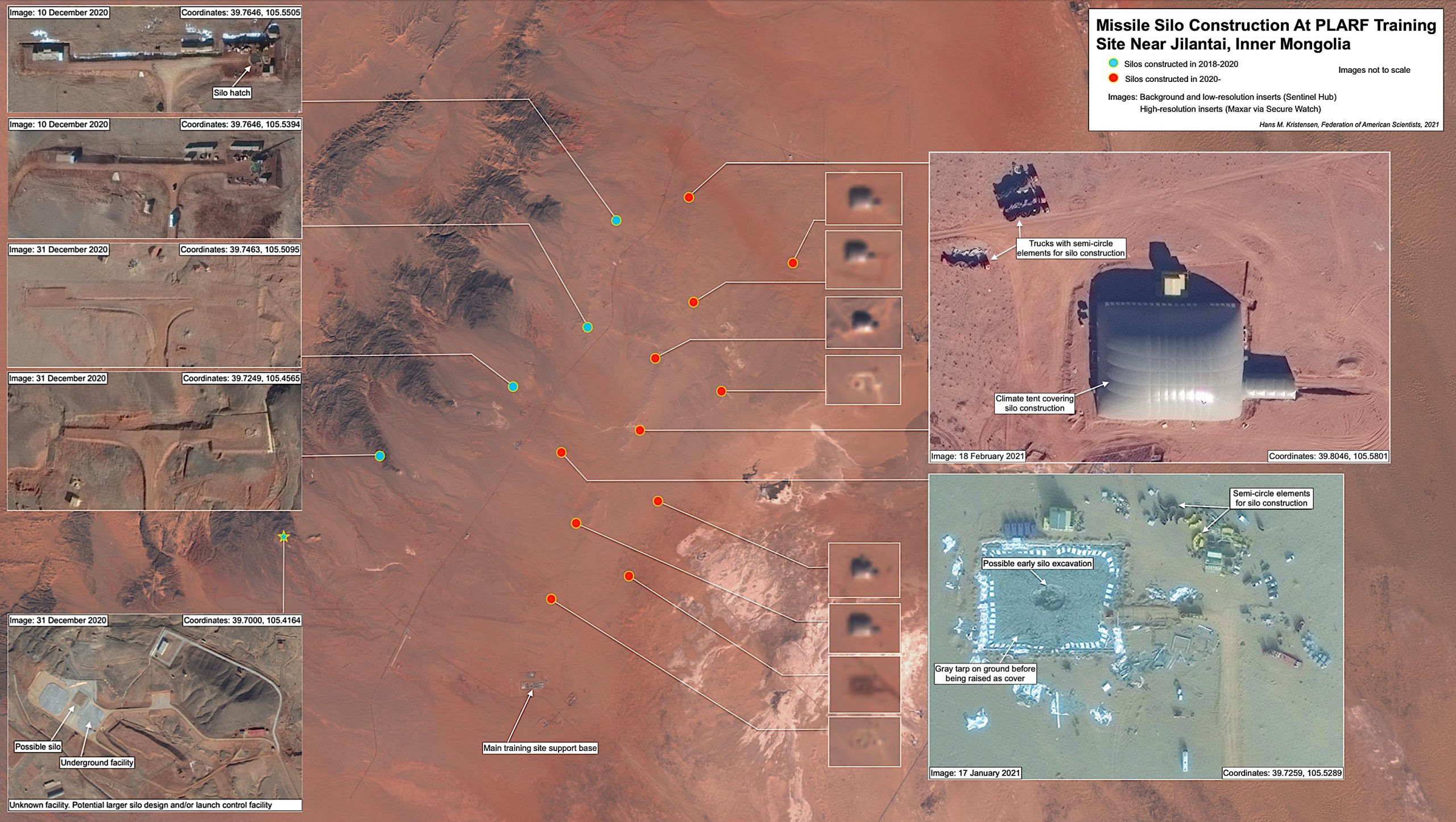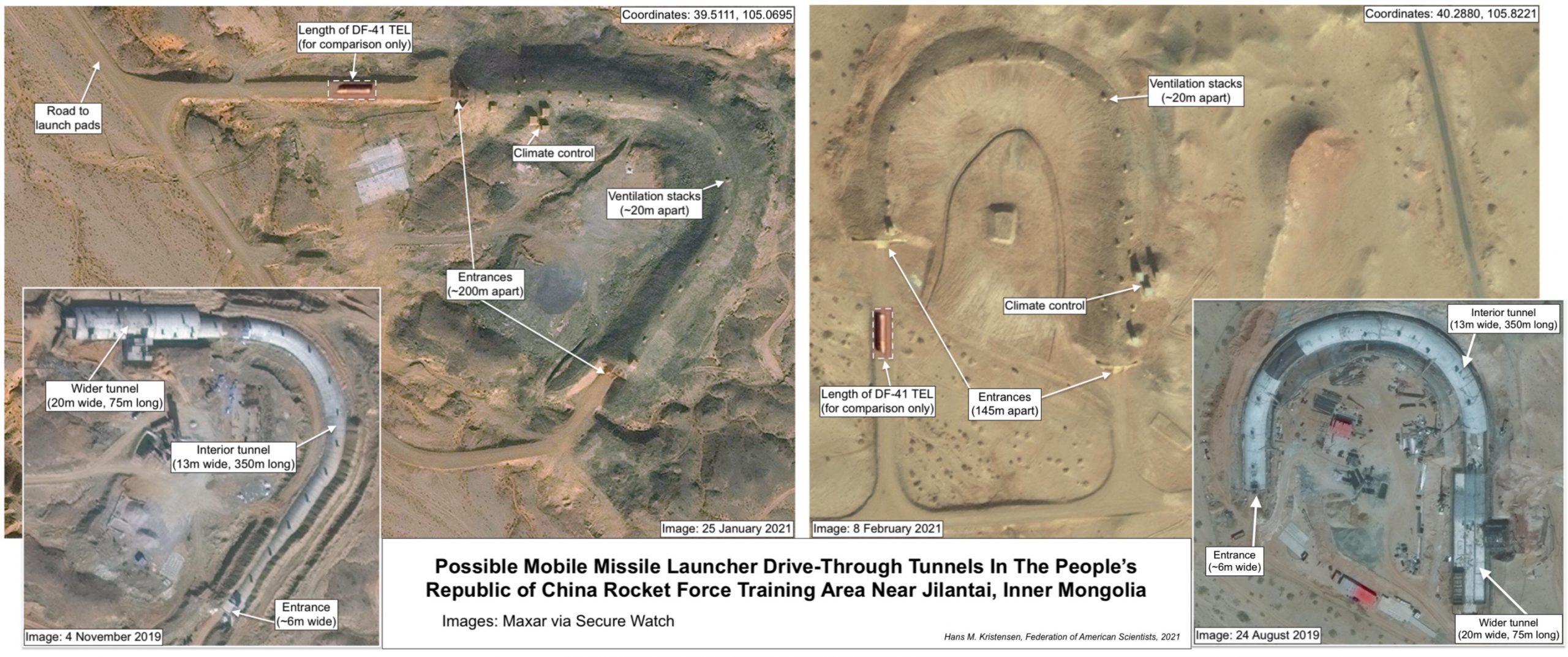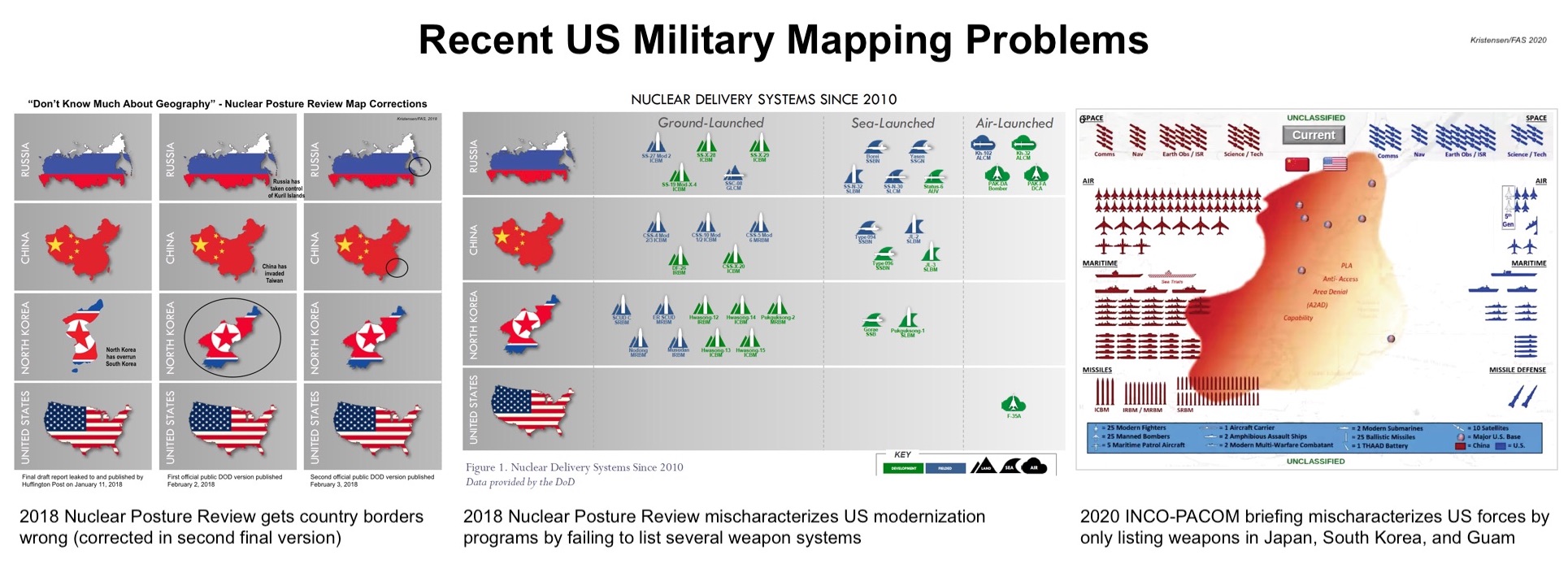Chinese Nuclear Forces, 2024: A “Significant Expansion”
The Federation of American Scientists’ Nuclear Information Project, a component of the Federation’s Global Risk program, today released its latest assessment of China’s growing nuclear arsenal: the 2024 Nuclear Notebook on Chinese Nuclear Forces. The 24-page report, published in the Bulletin of Atomic Scientists, includes details on China’s nuclear weapons arsenal, including types of weapons, delivery vehicles, operations, and, importantly, questions that can help determine the reliability and accuracy of projections about the future growth of China’s nuclear capabilities.
The Notebook comes at a critical time for U.S. analysis and policy debates regarding China’s nuclear forces and the appropriate U.S. and allied response. In October 2023, the Pentagon released its annual report to Congress on Military and Security Developments Involving the People’s Republic of China. This report preceded the release of both the Strategic Posture Commission report and the State Department’s International Security Advisory Board report on Nuclear Deterrence in a World of Nuclear Multipolarity. Within the U.S. government, military, and national security community, analysts are evaluating the implications of China’s growing nuclear force for nuclear deterrence, global stability, and U.S. security commitments in East Asia, Europe, and beyond.
What about the DOD’s numbers?
Meanwhile, the 2024 Nuclear Notebook on Chinese nuclear forces comes on the heels of a news report from Bloomberg that suggest corruption in China’s military procurement program may have resulted in the production or delivery of nuclear-tipped missiles and missile silos that do not operate properly. Reports about China’s corruption are not new, but the potential impact on the unprecedentedly rapid projected growth of China’s nuclear forces has not been previously reported, nor has it been reflected in reports, testimony, or statements by top Administration, defense, or intelligence officials.
Given the potential implications of the Bloomberg report, FAS sent a letter to Secretary of Defense Lloyd Austin asking whether the reported intelligence about the reliability of China’s missile force was known to the authors of DOD reports on China’s nuclear program and, if so, why they were not reflected in reports sent to Congress. As one of the most authoritative non-governmental sources on global nuclear forces, FAS has a unique interest in ensuring that its reports are objective and reflect the full extent of government and non-governmental expert understanding of nuclear arsenals worldwide.
2024 Nuclear Notebook: Key findings on China’s nuclear forces
Analyzing and estimating China’s nuclear forces is challenging, particularly given the relative lack of state-originating data and the tight control of messaging surrounding the country’s nuclear arsenal and doctrine. Like most other nuclear-armed states, China has never publicly disclosed the size of its nuclear arsenal or much of the infrastructure that supports it. The analyses and estimates made in the Nuclear Notebook are derived from a combination of open sources, including (1) state-originating data (e.g. government statements, declassified documents, budgetary information, military parades, and treaty disclosure data), (2) non-state-originating data (e.g. media reports, think tank analyses, and industry publications), and (3) commercial satellite imagery. From this information, FAS has tracked the significant expansion of China’s ongoing nuclear modernization program. Key findings from the 2024 FAS assessment on Chinese nuclear forces include:
- China’s nuclear expansion is among the largest and most rapid modernization campaigns of the nine nuclear-armed states.
- FAS estimates that China has produced a stockpile of approximately 500 nuclear warheads, with 440 warheads available for delivery by land-based ballistic missiles, sea-based ballistic missiles, and bombers.
- The latest Pentagon projection appears to apply the same growth rate of new warheads added to the stockpile between 2019 and 2021 to the subsequent years until 2035. FAS assesses that this projected growth trajectory is feasible but depends significantly upon many uncertain factors and assumptions.
- China has continued to develop its three new missile silo fields for solid-fuel intercontinental ballistic missiles (ICBMs), expand the construction of new silos for its liquid-fuel DF-5 ICBMs, and has been developing new variants of ICBMs and advanced strategic delivery systems.
- China has further expanded its dual-capable DF-26 intermediate-range ballistic missile (IRBM) force, which appears to have completely replaced the medium-range DF-21 in the nuclear role.
- China has been refitting its Type 094 ballistic missile submarines with the longer-range JL-3 submarine-launched ballistic missile (SLBM).
- China has recently reassigned an operational nuclear mission to its bombers and is developing an air-launched ballistic missile (ALBM) that might have nuclear capability.
This research was carried out with generous contributions from the New-Land Foundation, Ploughshares Fund, the Prospect Hill Foundation, Longview Philanthropy, and individual donors.
What Did the DOD Know About Chinese Missiles in the Latest PRC Nuclear Capabilities Report?
The Federation of American Scientists (FAS) sent a letter on January 9, 2024, to Secretary of Defense Lloyd Austin regarding the Department of Defense’s recent publications on China’s nuclear arsenal. These publications are a primary source of information for the public and are widely referenced by the U.S. government, military, and national security community when discussing the scope and implications of China’s nuclear modernization.
In early January 2024, Bloomberg published a press report suggesting U.S. intelligence assessments have evidence that the reliability of China’s new nuclear missiles may be undermined by corruption within China’s People’s Liberation Army Rocket Forces. These assessments cited examples of significant flaws in China’s missile program, including missile silo lids that may not be fully operational and missile silo fields – some of which were originally discovered by FAS researchers – that may have stages or components filled with water instead of fuel. If true, these flaws would compromise missile operations, calling into question China’s nuclear force readiness and overall capabilities.
FAS noted that “For over 70 years, FAS has worked to ensure there is a vigorous and informed public debate over nuclear weapons and security. As the world’s leading non-governmental source of information about global nuclear arsenals, ensuring the public has reliable and accurate information about the scale, role and capabilities of nuclear forces in other countries is critical to that debate.”
The letter sent by FAS asks whether these assessments were known to the authors of DOD reports to Congress who expressed concern about the record pace of China’s nuclear deployments and production. If so, the letter asks why such assessments were not included in those DOD reports or in other testimony and statements by DOD officials and military officers.
Finally, the letter notes FAS’ historical interest in ensuring U.S. government assessments about nuclear forces are complete and unbiased.
We have reproduced the text of the letter below. You can also download it as a PDF using the button on the top left of this post.
Secretary Lloyd Austin
The Department of Defense
Dear Mr. Secretary:
On January 6th, 2024, Bloomberg News reported that U.S. intelligence assessments called into question the reliability and functionality of China’s growing arsenal of long-range nuclear-armed missiles. The article mentioned that some silo doors on ICBMs may function properly, and ICBM stages or components may have been filled with water. None of this information has been included or publicly cited in reports or speeches by U.S. Defense Department officials or military officers, even as public concern about the pace of China’s reported nuclear buildup has increasingly influenced U.S. thinking about both deterrence, alliance management, and nuclear weapons procurement.
We would not expect, or want the USG Government to comment on sensitive intelligence. However, the Federation of American Scientists (FAS) would like to know if such assessments exist and, if so, whether you and the authors of the U.S. Department of Defense report, “Military and Security Developments Involving the People’s Republic of China,” published on October 19th, 2023, were aware of these assessments prior to its publication. If such assessments exist, and if the authors of the report were aware of their existence, we would also ask why some reference to these indicators were not included in the report and testimony related to China’s reported nuclear build-up.
The growth of China’s nuclear weapons capabilities has become a serious question and concern for the United States, both within the Government and the public, and among U.S. allies in East Asia and Europe. The growth and reported capabilities of China’s nuclear arsenal are being used increasingly to justify current and potentially additional increases in U.S. nuclear capabilities and spending, and to support expanding military and even nuclear collaboration with U.S. allies in East Asia. The accuracy of Department of Defense documents with regard to China’s nuclear capabilities are central to informing these debates in Congress as well as among security experts and the broader public, and thus, ensuring they are accurate and complete is essential. As you are no doubt aware, the Soviet Military Report series produced by the Department of Defense during the Cold War was found after the fact to have systematically overinflated Soviet capabilities. It would be appropriate for the Defense Department to remember past trends and ensure lessons learned are incorporated into ongoing public documents about countries that threaten U.S. and U.S. allied security.
FAS also has a direct interest in ensuring that U.S. Government reports on nuclear capabilities are as accurate and balanced as possible, given that FAS experts remain a central resource for the global public about nuclear capabilities throughout the world. While the FAS does not take U.S. estimates verbatim, we do use them as source material and believe the statements of the U.S. should be as accurate and reliable as possible. As such, FAS has a particular interest in ensuring that its work is not mistakenly or deliberately biassed by government sources that include worst-case estimates or that fail to provide important assessments about the reliability, pace, and operational status of key systems. Having engaged in key debates on nuclear policy for over 70 years, FAS has a strong institutional basis for wanting to use reliable information from governments, but at the same time, keenly remembers periods between the 1960-1980s when the Department of Defense produced annual assessments of Soviet military capabilities that widely overinflated conventional and nuclear capabilities, which may have ultimately contributed to unnecessary arms investments in the United States.
As such, FAS would kindly request that your department make clear:
- Was the Department of Defense aware of intelligence before the publication of Military and Security Developments Involving the People’s Republic of China that Chinese procurement flaws may have led to missile silo doors that are not operational, or that missiles that were filled with water and not fuel?
- Does the Department intend to either amend or withdraw the current report to Congress and update it with a broader reliance on information––not only about the growth of China’s nuclear capabilities but also information that may acknowledge the possible unreliability of such systems so that it may be factored into the public debate in Congress and elsewhere?
- Were US Strategic Command or US Indo-Pacific Command aware in 2023 of the information reported on January 6th, 2024 that China’s siloed ICBMs may be less than fully reliable? If so, why was that information not included in speeches and publications?
- Lastly, is the Department considering changes to how its reports are produced, reviewed, and promoted to ensure not only that China’s growing capabilities are included but that they also information that might inform a more complete assessment of the nature, scale, and pace of China’s nuclear capabilities might pose to the U.S. and our allies?
For over 70 years, the Federation of American Scientists has played a key role in supporting public debate over issues related to security, technology, and nuclear weapons. We appreciate your interest in ensuring the public engages in a sustained discourse over appropriate defense investments and strategy to secure American and allied security in the coming decades. Your attention to this matter is greatly appreciated.
Sincerely,
Jon Wolfsthal
Director, Global Risk
This research was carried out with generous contributions from the New-Land Foundation, Ploughshares Fund, the Prospect Hill Foundation, Longview Philanthropy, and individual donors.
Strategic Posture Commission Report Calls for Broad Nuclear Buildup
On October 12th, the Strategic Posture Commission released its long-awaited report on U.S. nuclear policy and strategic stability. The 12-member Commission was hand-picked by Congress in 2022 to conduct a threat assessment, consider alterations to U.S. force posture, and provide recommendations.
In contrast to the Biden administration’s Nuclear Posture Review, the Congressionally-mandated Strategic Posture Commission report is a full-throated embrace of a U.S. nuclear build-up.
It includes recommendations for the United States to prepare to increase its number of deployed warheads, as well as increasing its production of bombers, air-launched cruise missiles, ballistic missile submarines, non-strategic nuclear forces, and warhead production capacity. It also calls for the United States to deploy multiple warheads on land-based intercontinental ballistic missiles (ICBMs) and consider adding road-mobile ICBMs to its arsenal.
The only thing that appears to have prevented the Commission from recommending an immediate increase of the U.S. nuclear weapons stockpile is that the weapons production complex currently does not have the capacity to do so.
The Commission’s embrace of a U.S. nuclear buildup ignores the consequences of a likely arms race with Russia and China (in fact, the Commission doesn’t even consider this or suggest other steps than a buildup to try to address the problem). If the United States responds to the Chinese buildup by increasing its own deployed warheads and launchers, Russia would most likely respond by increasing its deployed warheads and launchers. That would increase the nuclear threat against the United States and its allies. China, who has already decided that it needs more nuclear weapons to stand up to the existing U.S. force level (and those of Russia and India), might well respond to the U.S and Russian increases by increasing its own arsenal even further. That would put the United States back to where it started, feeling insufficient and facing increased nuclear threats.
Framing and context
The Commission’s report is generally framed around the prospect of Russian and Chinese strategic military cooperation against the United States. The Commission cautions against “dismissing the possibility of opportunistic or simultaneous two-peer aggression because it may seem improbable,” and notes that “not addressing it in U.S. strategy and strategic posture, could have the perverse effect of making such aggression more likely.” The Commission does not acknowledge, however, that building up new capabilities to address this highly remote possibility would likely kick the arms race into an even higher gear.
The report acknowledges that Russia and China are in the midst of large-scale modernization programs, and in the case of China, significant increases to its nuclear stockpile. This accords with our own assessments of both countries’ nuclear programs. However, the report’s authors suggest that these changes fundamentally call into question the United States’ assured retaliatory capabilities, and state that “the current U.S. strategic posture will be insufficient to achieve the objectives of U.S. defense strategy in the future….”
The Commission appears to base this conclusion, as well as its nuclear strategy and force structure recommendations, squarely on numerically-focused counterforce thinking: if China increases its posture by fielding more weapons, that automatically means the United States needs more weapons to “[a]ddress the larger number of targets….” However, the survivability of the US ballistic missile submarines should insulate the United States against needing to subscribe to this kind of thinking.
In 2012, a joint DOD/DNI report acknowledged that because of the US submarine force, Russia would not achieve any military advantage against the United States by significantly increasing the size of its deployed nuclear forces. In that 2012 study, both departments concluded that the “Russian Federation…would not be able to achieve a militarily significant advantage by any plausible expansion of its strategic nuclear forces, even in a cheating or breakout scenario under the New START Treaty, primarily because of the inherent survivability of the planned U.S. Strategic force structure, particularly the OHIO-class ballistic missile submarines, a number of which are at sea at any given time.” [Emphasis added.] Why would this logic not apply to China as well? Although China’s nuclear arsenal is undoubtedly growing, why would it fundamentally alter the nature of the United States’ assured retaliatory capability while the United States is confident in the survivability of its SSBNs?
In this context, it is worth reiterating the words of Secretary of Defense Lloyd Austin at the U.S. Strategic Command Change of Command Ceremony: “We all understand that nuclear deterrence isn’t just a numbers game. In fact, that sort of thinking can spur a dangerous arms race…deterrence has never been just about the numbers, the weapons, or the platforms.”
Force structure
Although the report says the Commission “avoided making specific force structure recommendations” in order to “leave specific material solution decisions to the Executive Branch and Congress,” the list of “identified capabilities beyond the existing program of record (POR) that will be needed” leaves little doubt about what the Commission believes those force structure decisions should be.
Strategic posture alterations
The Commission concludes that the United States “must act now to pursue additional measures and programs…beyond the planned modernization of strategic delivery vehicles and warheads may include either or both qualitative and quantitative adjustments in the U.S. strategic posture.”
Specifically, the Commission recommends that the United States should pursue the following modifications to its strategic nuclear force posture “with urgency:” [our context and commentary added below]
- Prepare to upload some or all of the nation’s hedge warheads; [these warheads are currently in storage; increasing deployed warheads above 1,550 is prohibited by the New START treaty (which expires in early-2026) and would likely cause Russia to also increase its deployed warheads.]
- Plan to deploy the Sentinel ICBM in a MIRVed configuration; [the Sentinel appears to be capable of carrying two MIRV but current plan calls for each missile to be deployed with just a single warhead]
- Increase the planned number of deployed Long-Range Standoff Weapons; [the Air Force currently has just over 500 ALCMs and plans to build 1,087 LRSOs (including test-flight missiles), each of which costs approximately $13 million]
- Increase the planned number of B-21 bombers and the tankers an expanded force would require; [the Air Force has said that it plans to purchase at least 100 B-21s]
- Increase the planned production of Columbia SSBNs and their Trident ballistic missile systems, and accelerate development and deployment of D5LE2; [the Navy currently plans to build 12 Columbia-class SSBNs and an increase would not happen until after the 12th SSBN is completed in the 2040s]
- Pursue the feasibility of fielding some portion of the future ICBM force in a road mobile configuration; [historically, any efforts to deploy road-mobile ICBMs in the United States have been unsuccessful]
- Accelerate efforts to develop advanced countermeasures to adversary IAMD; and
- Initiate planning and preparations for a portion of the future bomber fleet to be on continuous alert status, in time for the B-21 Full Operational Capability (FOC) date.” [Bombers currently regularly practice loading nuclear weapons as part of rapid-takeoff exercises. Returning bombers to alert would revert the decision by President H.W. Bush in 1991 to take bombers off alert. In 2021, the Air Force’s Deputy Chief of Staff for Strategic Deterrence and Nuclear Integration stated that keeping the bomber fleet on continuous alert would exhaust the force and could not be done indefinitely]
Nonstrategic posture alterations
The Commission appears to want the United States to bolster its non-strategic nuclear forces in Europe, and begin to deploy non-strategic nuclear weapons in the Indo-Pacific theater: “Additional U.S. theater nuclear capabilities will be necessary in both Europe and the Indo-Pacific regions to deter adversary nuclear use and offset local conventional superiority. These additional theater capabilities will need to be deployable, survivable, and variable in their available yield options.” Although the Commission does not explicitly recommend fielding either ground-launched theater nuclear capabilities or a nuclear sea-launched cruise missile for the Navy, it seems clear that these capabilities would be part of the Commission’s logic.
The United States used to deploy large numbers of non-strategic nuclear weapons in the Indo-Pacific region during the Cold War, but those weapons were withdrawn in the early 1990s and later dismantled as U.S. military planning shifted to rely more on advanced conventional weapons for limited theater options. Despite the removal of certain types of theater nuclear weapons after the Cold War, today the President maintains a wide range of nuclear response options designed to deter Russian and Chinese limited nuclear use in both regions––including capabilities with low or variable yields. In addition to ballistic missile submarines and nuclear-capable bombers operating in both regions, the U.S. Air Force has non-strategic B61 nuclear bombs for dual-capable aircraft that are intended for operations in both regions if it becomes necessary. The Navy now also has a low-yield warhead on its SSBNs––the W76-2––that was fielded specifically to provide the President with more options to deter limited scenarios in those regions. It is unclear why these existing options, as well as several additional capabilities already under development––including the incoming Long-Range Stand-Off Weapon––would be insufficient for maintaining regional deterrence.
The Commission specifically recommends that the United States should “urgently” modify its nuclear posture to “[p]rovide the President a range of militarily effective nuclear response options to deter or counter Russian or Chinese limited nuclear use in theater.” Although current plans already provide the President with such options, the Commission “recommends the following U.S. theater nuclear force posture modifications:
Develop and deploy theater nuclear delivery systems that have some or all of the following attributes: [our context and commentary added below]
- Forward-deployed or deployable in the European and Asia-Pacific theaters [The United States already has dual-capable fighters and B61 bombs earmarked for operations in the Asia-Pacific theaters, backed up by bombers with long-range cruise missiles];
- Survivable against preemptive attack without force generation day-to-day;
- A range of explosive yield options, including low yield [US nuclear forces earmarked for regional options already have a wide range of low-yield options];
- Capable of penetrating advanced IAMD with high confidence [F-35A dual-capable aircraft, the B-21 bomber, and air-launched cruise missiles are already being developed with enhanced penetration capabilities]; and
- Operationally relevant weapon delivery timeline (promptness) [the US recently fielded the W76-2 warhead on SSBNs to provide prompt theater capability in limited scenarios and is developing new prompt conventional missiles].”
Unlike U.S. low-yield theater nuclear weapons, the Commission warns that China’s development of “theater-range low-yield weapons may reduce China’s threshold for using nuclear weapons.” Presumably, the same would be true for the United States threshold if it followed the Commission’s recommendation to increase deployed (or deployable) non-strategic nuclear weapons with low-yield capabilities in the Indo-Pacific theater.
Strategy
Overall, the Commission suggests that current U.S. nuclear strategy is basically sound, but just needs to be backed up with additional weapons and industrial capacity. However, by not including recommendations to modify presidential nuclear employment guidance –– or even considering such an adjustment, which could reshape U.S. force posture to allow for decreased emphasis on counterforce targeting –– the Commission has limited its own flexibility to recommend any options other than simply adding more weapons.
Three scholars recently proposed a revised nuclear strategy that they concluded would reduce weapons requirements yet still be sufficient to adequately deter Russia and China. The central premise of reducing the counterforce focus is similar to a study that we published in 2009. In contrast, the Commission appears to have assumed an unchanged nuclear strategy and instead focused intensely on weapons and numbers.
The Commission report does not explain how it gets to the specific nuclear arms additions it says are needed. It only provides generic descriptions of nuclear strategy and lists of Chinese and Russian increases. The reason this translates into a recommendation to increase the US nuclear arsenal appears to be that the list of target categories that the Commission believes need to be targeted is very broad: “this means holding at risk key elements of their leadership, the security structure maintaining the leadership in power, their nuclear and conventional forces, and their war supporting industry.”
This numerical focus also ignores years of adjustments made to nuclear planning intended to avoid excessive nuclear force levels and increase flexibility. When asked in 2017 whether the US needed new nuclear capabilities for limited scenarios, then STRATCOM commander General John Hyten responded:
“[W]e actually have very flexible options in our plans. So if something bad happens in the world and there’s a response and I’m on the phone with the Secretary of Defense and the President and the entire staff, …I actually have a series of very flexible options from conventional all the way up to large-scale nuke that I can advise the President on to give him options on what he would want to do… So I’m very comfortable today with the flexibility of our response options… And the reason I was surprised when I got to STRATCOM about the flexibility, is because the last time I executed or was involved in the execution of the nuclear plan was about 20 years ago and there was no flexibility in the plan. It was big, it was huge, it was massively destructive, and that’s all there. We now have conventional responses all the way up to the nuclear responses, and I think that’s a very healthy thing.”
While advocating integrated deterrence and a “whole of government” approach, the Commission nonetheless sets up an artificial dichotomy between conventional and nuclear capabilities: “The objectives of U.S. strategy must include effective deterrence and defeat of simultaneous Russian and Chinese aggression in Europe and Asia using conventional forces. If the United States and its Allies and partners do not field sufficient conventional forces to achieve this objective, U.S. strategy would need to be altered to increase reliance on nuclear weapons to deter or counter opportunistic or collaborative aggression in the other theater.”
Arms control
The Commission recommends subjugating nuclear arms control to the nuclear build-up: “The Commission recommends that a strategy to address the two-nuclear-peer threat environment be a prerequisite for developing U.S. nuclear arms control limits for the 2027-2035 timeframe. The Commission recommends that once a strategy and its related force requirements are established, the U.S. government determine whether and how nuclear arms control limits continue to enhance U.S. security.”
Put another way, this constitutes a recommendation to participate in an arms race, and then figure out how to control those same arms later.
The Commission report does acknowledge the importance of arms control, and notes that “[t]he ideal scenario for the United States would be a trilateral agreement that could effectively verify and limit all Russian, Chinese, and U.S. nuclear warheads and delivery systems, while retaining sufficient U.S. nuclear forces to meet security objectives and hedge against potential violations of the agreement.” (p.85) However, the prospect of this “ideal scenario” coming true would become increasingly unlikely if the United States significantly built up its nuclear forces as the Commission recommends.
Capacity and budget
The Commission recommends an overhaul and expansion of the nuclear weapons design and production capacity. That includes full funding of all NNSA recapitalization efforts, including pit production plans, even though the Government Accountability Office has warned that the program faces serious challenges and budget uncertainties. The Commission appears to brush aside concerns about the proposed pit production program.
Overall, the report does not seem to acknowledge any limits to defense spending. Amid all of the Commission’s recommendations to increase the number of strategic and tactical nuclear systems, there is almost no mention of cost in the entire report. Fulfilling all of these recommendations would require a significant amount of money, and that money would have to come from somewhere.
For example, the Congressional Budget Office estimates that developing the SLCM-N alone would cost an estimated $10 billion until 2030, not to mention another $7 billion for other tactical nuclear weapons and delivery systems. The amount of money it would take to field new systems, in addition to addressing other vital concerns such as IAMD, means funding would necessarily be cut from other budget priorities.
The true costs of these systems are not only the significant funds spent to acquire them, but also the fact that prioritizing these systems necessarily means deprioritizing other domestic or foreign policy initiatives that could do more to increase US security.
Implications for U.S. Nuclear Posture
The Strategic Posture Commission report is, in effect, a congressionally-mandated rebuttal to the Biden administration’s Nuclear Posture Review, which many in Congress have critiqued for not being hawkish enough. The report does not describe in detail its methodology for how it arrives at its force buildup recommendations, and includes several claims and assumptions about nuclear strategy that have been critiqued and called into question by recent scholarship. In some respects, it reads more like an industry report than a Congressionally-mandated study.
While the timing of the report means that it is unlikely to have a significant impact on this year’s budget cycle, it will certainly play a critical role in justifying increases to the nuclear budget for years to come.
From our perspective, the recommendations included in the Commission report are likely to exacerbate the arms race, further constrict the window for engaging with Russia and China on arms control, and redirect funding away from more proximate priorities. At the very least, before embarking on this overambitious wish list the United States must address any outstanding recommendations from the Government Accountability Office to fix its planning and budgeting processes, otherwise it risks overloading the assembly line even more.
In addition, the United States could consider how modified presidential employment guidance might enable a posture that relies on fewer nuclear weapons, and adjust accordingly.
This research was carried out with generous contributions from the New-Land Foundation, Ploughshares Fund, the Prospect Hill Foundation, Longview Philanthropy, and individual donors.
STRATCOM Says China Has More ICBM Launchers Than The United States – We Have Questions
In early-February 2023, the Wall Street Journal reported that U.S. Strategic Command (STRATCOM) had informed Congress that China now has more launchers for Intercontinental Ballistic Missiles (ICBMs) than the United States. The report is the latest in a serious of revelations over the past four years about China’s growing nuclear weapons arsenal and the deepening strategic competition between the world’s nuclear weapon states. It is important to monitor China’s developments to understand what it means for Chinese nuclear strategy and intensions, but it is also important to avoid overreactions and exaggerations.
First, a reminder about what the STRATCOM letter says and does not say. It does not say that China has more ICBMs or warheads on them than the United States, or that the United States is at an overall disadvantage. The letter has three findings (in that order):
- The number of ICBMs in the active inventory of China has not exceeded the number of ICBMs in the active inventory of the United States.
- The number of nuclear warheads equipped on such missiles of China has not exceeded the number of nuclear warheads equipped on such missiles of the United States.
- The number of land-based fixed and mobile ICBM launchers in China exceeds the number of ICBM launchers in the United States.
It is already well-known that China is building several hundred new missile silos. We documented many of them (see here, here and here), as did other analysts (here and here). It was expected that sooner or later some of them would be completed and bring China’s total number of ICBM launchers (silo and road-mobile) above the number of US ICBM launchers. That is what STRATCOM says has now happened.
STRATCOM ICBM Counting
The number of Chinese ICBM launchers included in the STRATCOM report to Congress was counted at a cut-off date of October 2022. It is unclear precisely how STRATCOM counts the Chinese silos, but the number appears to include hundreds of silos that were not yet operational with missiles at the time. So, at what point in its construction process did STRATCOM include a silo as part of the count? Does it have to be completely finished with everything ready except a loaded missile?
We have examined satellite photos of every single silo under construction in the three new large missile silo fields (Hami, Julin, and Yumen). It is impossible to determine with certainty from a satellite photo if a silo is completely finished, much less whether it is loaded with a missile. However, the available images indicate it is possible that most of the silos at Hami might have been complete by October 2022, that many of the silos at the Yumen field were still under construction, and that none of the silos at the Julin (Ordos) fields had been completed at the time of STRATCOM’s cutoff date (see image below).
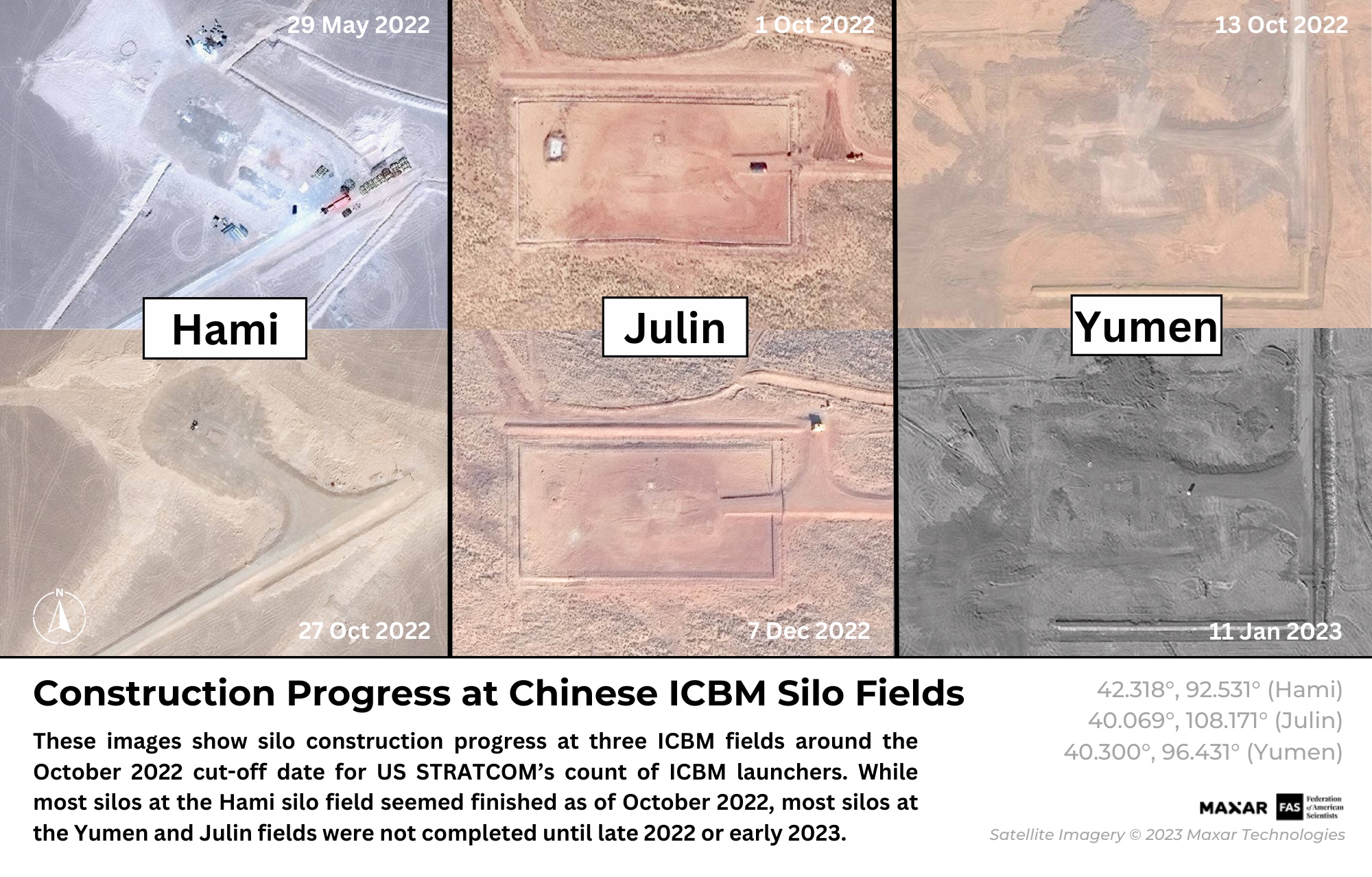
Commercial satellite images help assess STRATCOM claim about China’s missile silos.
The number of Chinese ICBM launchers reported by the Pentagon over the past three years has increased significantly from 100 launchers at the end of 2020, to 300 launchers at the end of 2021, to now more than 450 launchers as of October 2022. That is an increase of 350 launchers in only three years.
To exceed the number of US ICBM launchers as most recently reported by STRATCOM, China would have to have more than 450 launchers (mobile and silo) – the US Air Force has 400 silos with missiles and another 50 empty silos that could be loaded as well if necessary. Without counting the new silos under construction, we estimate that China has approximately 140 operational ICBM launchers with as many missiles. To get to 300 launchers with as many missiles, as the 2022 China Military Power Report (CMPR) estimated, the Pentagon would have to include about 160 launchers from the new silo fields – half of all the silos – as not only finished but with missiles loaded in them. We have not yet seen a missile loading – training or otherwise – on any of the satellite photos. To reach 450 launchers as of October 2022, STRATCOM would have to count nearly all the silos in the three new missile silo fields (see graph below).
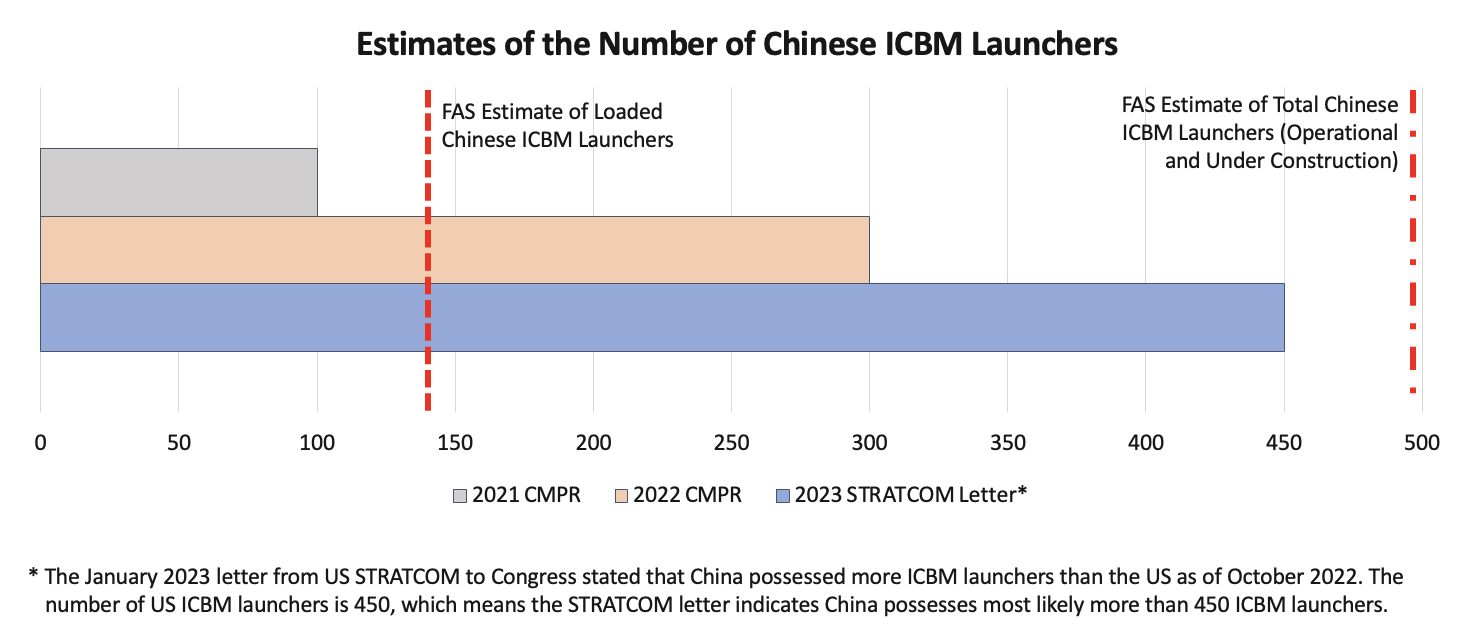
Pentagon estimates of Chinese completed ICBM launchers appear to include hundreds of new silos at three missile silo fields.
The point at which a silo is loaded with a missile depends not only on the silo itself but also on the operational status of support facilities, command and control systems, and security perimeters. Construction of that infrastructure is still ongoing at all the three missile silo fields.
It is also possible that the number of launchers and missiles in the Pentagon estimate is less directly linked. The number could potentially refer to the number of missiles for operational launchers plus missiles produced for launchers that have been more or less completed but not yet loaded with missiles.
All of that to underscore that there is considerable uncertainty about the operational status of the Chinese ICBM force.
However – in time for the Congressional debate on the FY2024 defense budget – some appear to be using the STRATCOM letter to suggest the United States also needs to increase its nuclear arsenal.
Comparing The Full Arsenals
The rapid increase of the Chinese ICBM force is important and unprecedented. Yet, it is also crucial to keep things in perspective. In his response to the STRATCOM letter, Rep. Mike Rogers – the new conservative chairman of the House Armed Services Committee – claimed that China is “rapidly approaching parity with the United States” in nuclear forces. That is not accurate.
Even if China ends up with more ICBMs than the United States and increases its nuclear stockpile to 1,500 warheads by 2035, as projected by the Pentagon, that does not give China parity. The United States has 800 launchers for strategic nuclear weapons and a stockpile of 3,700 warheads (see graph below).
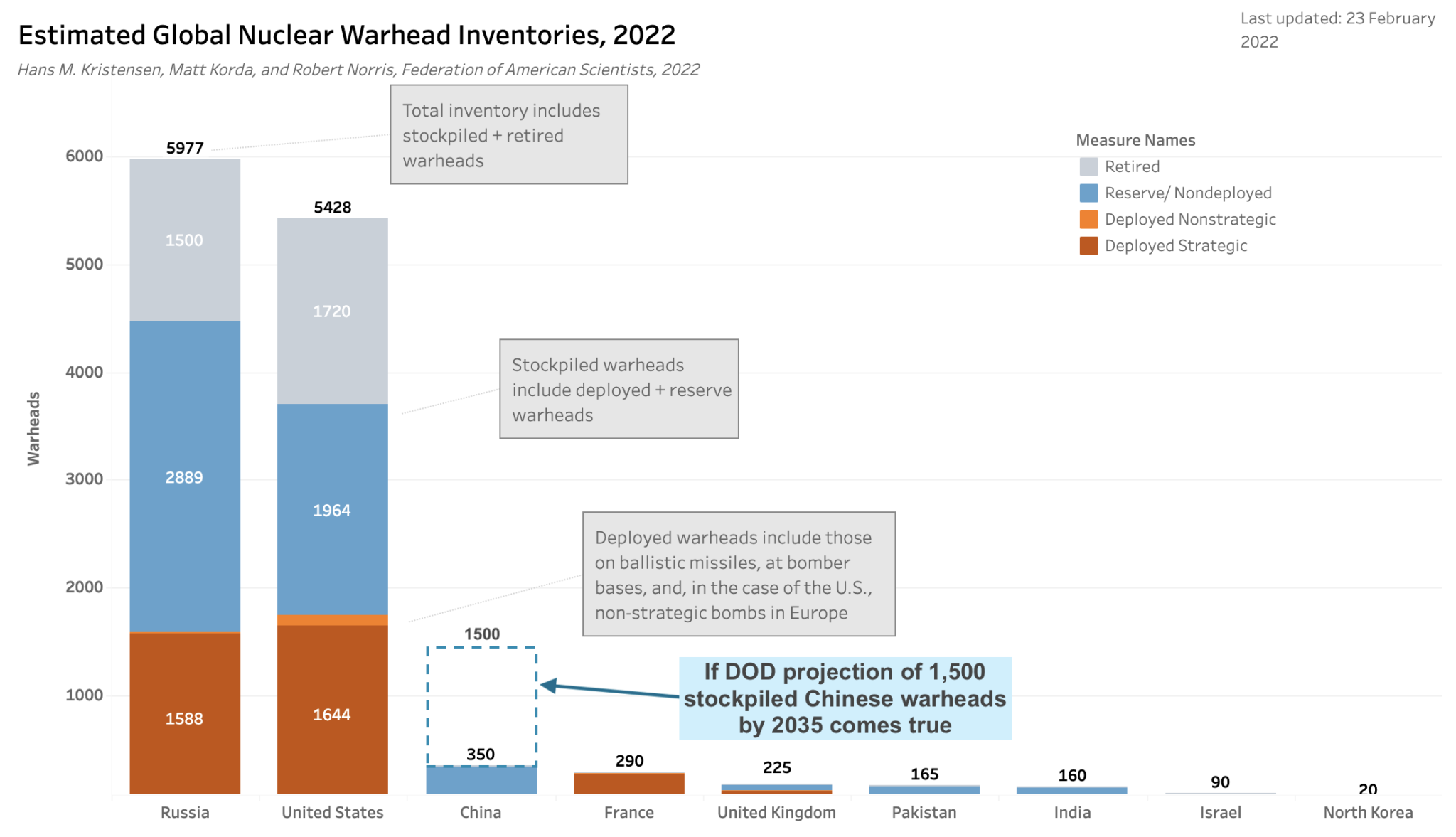
Even if China increases it nuclear weapons stockpile to 1,500 by 2035, it will only make up a fraction of the much larger US and Russian stockpiles.
The worst-case projection about China’s nuclear expansion assumes that it will fill everything with missiles with multiple warheads. In reality, it is unknown how many of the new silos will be filled with missiles, how many warheads each missile will carry, and how many warheads China can actually produce over the next decade.
The nuclear arsenals do not exist in a vacuum but are linked to the overall military capabilities and the policies and strategies of the owners.
The Political Dimension
STRATCOM initially informed Congress about its assessment that the number of Chinese ICBM launchers exceeded that of the United States back in November 2022. But the letter was classified, so four conservative members of the Senate and House armed services committees reminded STRATCOM that it was required to also release an unclassified version. They then used the unclassified letter to argue for more nuclear weapons stating (see screen shot of Committee web page below):
“We have no time to waste in adjusting our nuclear force posture to deter both Russia and China. This will have to mean higher numbers and new capabilities.” (Emphasis added.)
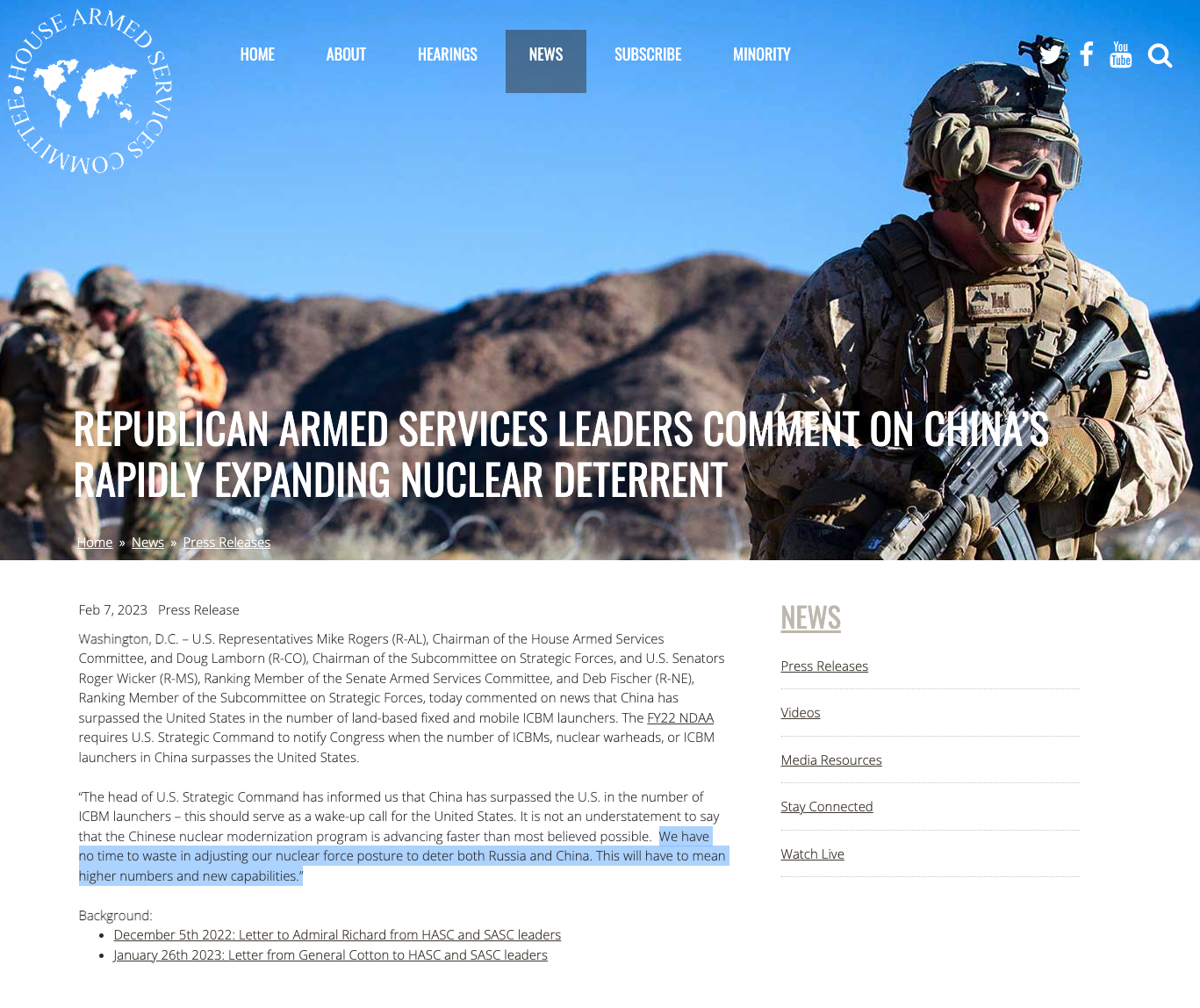
Lawmakers immediately used STRATCOM assessment of Chinese ICBM launchers to call for more US nuclear weapons.
Although defense contractors probably would be happy about that response, it is less clear why ‘higher numbers’ are necessary for US nuclear strategy. Increasing US nuclear weapons could in fact end up worsening the problem by causing China and Russia to increase their arsenals even further. And as we have already seen, that would likely cause a heightened demand for more US nuclear weapons.
We have seen this playbook before during the Cold War nuclear arms race. Only this time, it’s not just between the United States and the Soviet Union, but with Russia and a growing China.
Even before China will reach the force levels projected by the Pentagon, the last remaining arms control treaty with Russia – the New START Treaty – will expire in February 2026. Without a follow-on agreement, Russia could potentially double the number of warheads it deploys on its strategic launchers.
Even if the defense hawks in Congress have their way, the United States does not seem to be in a position to compete in a nuclear arms race with both Russia and China. The modernization program is already overwhelmed with little room for expansion, and the warhead production capacity will not be able to produce large numbers of additional nuclear weapons for the foreseeable future.
What the Chinese nuclear buildup means for Chinese nuclear policy and how the United States should respond to it (as well as to Russia) is much more complicated and important to address than a rush to get more nuclear weapons. It would be more constructive for the United States to focus on engaging with Russia and China on nuclear risk reduction and arms control rather than engage in a build-up of its nuclear forces.
Additional Information:
Status of World Nuclear Forces
This research was carried out with generous contributions from the John D. and Catherine T. MacArthur Foundation, the New-Land Foundation, Ploughshares Fund, the Prospect Hill Foundation, Longview Philanthropy, the Stewart R. Mott Foundation, the Future of Life Institute, Open Philanthropy, and individual donors.
The 2022 Nuclear Posture Review: Arms Control Subdued By Military Rivalry
On 27 October 2022, the Biden administration finally released an unclassified version of its long-delayed Nuclear Posture Review (NPR). The classified NPR was released to Congress in March 2022, but its publication was substantially delayed––likely due to Russia’s invasion of Ukraine.
Compared with previous NPRs, the tone and content come closest to the Obama administration’s NPR from 2010. However, it contains significant adjustments because of the developments in Russia and China. (See also our global overview of nuclear arsenals)
Despite the challenges presented by Russia and China, the NPR correctly resists efforts by defense hawks and nuclear lobbyists to add nuclear weapons to the U.S. arsenal and delay the retirement of older types. Instead, the NPR seeks to respond with adjustments in the existing force posture and increase integration of conventional and nuclear planning.
Although Joe Biden during his presidential election campaign spoke strongly in favor of adopting no-first-use and sole-purpose policies, the NPR explicitly rejects both for now.
From an arms control and risk reduction perspective, the NPR is a disappointment. Previous efforts to reduce nuclear arsenals and the role that nuclear weapons play have been subdued by renewed strategic competition abroad and opposition from defense hawks at home.
Even so, the NPR concludes it may still be possible to reduce the role that nuclear weapons play in scenarios where nuclear use may not be credible.
Unlike previous NPRs, the 2022 version is embedded into the National Defense Strategy document alongside the Missile Defense Review.
Below is our summary and analysis of the major portions of the NPR:
The Nuclear Adversaries
The NPR identifies four potential adversaries for U.S. nuclear weapons planning: Russia, China, North Korea, and Iran. Of these, Russia and China are obviously the focus because of Russia’s large arsenal and aggressive behavior and because of China’s rapidly increasing arsenal. The NPR projects that “[b]y the 2030s the United States will, for the first time in its history, face two major nuclear powers as strategic competitors and potential adversaries.” This echoes previous statements from high-ranking US military leaders, including the former and incoming Commanders of US Strategic Command although the NPR appears less “the sky is falling.”
China: Given that the National Defense Strategy is largely focused on China, it is unsurprising that the NPR declares China to be “the overall pacing challenge for U.S. defense planning and a growing factor in evaluating our nuclear deterrent.”
Echoing the findings of the previous year’s China Military Power Report, the NPR suggests that “[t]he PRC likely intends to possess at least 1,000 deliverable warheads by the end of the decade.” According to the NPR, China’s more diverse nuclear arsenal “could provide the PRC with new options before and during a crisis or conflict to leverage nuclear weapons for coercive purposes, including military provocations against U.S. Allies and partners in the region.”
See also our Nuclear Notebook on Chinese nuclear forces.
Russia: The NPR presents harsh language about Russia, in particular surrounding its behavior around the invasion of Ukraine. In contrast to the Trump administration’s NPR, the assumptions surrounding a potential low-yield “escalate-to-deescalate” policy have been toned down; instead the NPR simply states that Russia is diversifying its arsenal and that it views its nuclear weapons as “a shield behind which to wage unjustified aggression against [its] neighbors.”
The review’s estimate of Russian non-strategic nuclear weapons –– “up to 2,000 –– matches those of previous military statements. In 2021, the Defense Intelligence Agency concluded that Russia “probably possesses 1,000 to 2,000 nonstrategic nuclear warheads.” The State Department said in April 2022 that the estimate includes retired weapons awaiting dismantlement. The subtle language differences reflect a variance in estimates between the different US military departments and agencies.
The NPR also suggests that “Russia is pursuing several novel nuclear-capable systems designed to hold the U.S. homeland or Allies and partners at risk, some of which are also not accountable under New START.” Given that both sides appear to agree that Russia’s new Sarmat ICBM and Avangard hypersonic glide vehicle fit smoothly into the treaty, this statement is likely referring to Russia’s development of its Burevestnik nuclear-powered cruise missile, its Kinzhal air-launched ballistic missile, and its Status-6 Poseidon nuclear torpedo.
It appears that Russia and the United States are at odds over whether these three systems are treaty-accountable weapons. In 2019, then-Under Secretary Andrea Thompson noted during congressional testimony that all three “meet the US criteria for what constitutes a “new kind of strategic offensive arms’ for purposes of New START.” However, Russian officials had previously sent a notice to the United States stating that they “find it inappropriate to characterize new weapons being developed by Russia that do not use ballistic trajectories of flight moving to a target as ‘potential new kinds of Russian strategic offensive arms.’ The arms presented by the President of the Russian Federation on March 1, 2018, have nothing to do with the strategic offensive arms categories covered by the Treaty.”
See also our Nuclear Notebook on Russian nuclear forces.
North Korea: In recent years, North Korea has been overshadowed by China and Russia in the U.S. defense debate. Nonetheless this NPR describes North Korea as a target for U.S. nuclear weapons planning. The NPR bluntly states: “Any nuclear attack by North Korea against the United States or its Allies and partners is unacceptable and will result in the end of that regime. There is no scenario in which the Kim regime could employ nuclear weapons and survive.”
See also our Nuclear Notebook on North Korean nuclear forces.
Iran: The NPR also describes Iran even though it does not have nuclear weapons. Interestingly, although Iran is not in compliance with its NPT obligations and therefore does not qualify for the U.S. negative security assurances, the NPR declares that the United States “relies on non-nuclear overmatch to deter regional aggression by Iran as long as Iran does not possess nuclear weapons.”
Nuclear Declaratory Policy
The NPR reaffirms long-standing U.S. policy about the role of nuclear weapons but with slightly modified language. The role is: 1) Deter strategic attacks, 2) Assure allies and partners, and 3) Achieve U.S. objectives if deterrence fails.
The NPR reiterates the language from the 2010 NPR that the “fundamental role” of U.S. nuclear weapons “is to deter nuclear attacks” and only in “extreme circumstances.” The strategy seeks to “maintain a very high bar for nuclear employment” and, if employment of nuclear weapons is necessary, “seek to end conflict at the lowest level of damage possible on the best achievable terms for the United States and its Allies and partners.”
Deterring “strategic” attacks is a different formulation than the “deterrence of nuclear and non-nuclear attack” language in the 2018 NPR, but the new NPR makes it clear that “strategic” also accounts for existing and emerging non-nuclear attacks: “nuclear weapons are required to deter not only nuclear attack, but also a narrow range of other high consequence, strategic-level attacks.”
Indeed, the NPR makes clear that U.S. nuclear weapons can be used against the full spectrum of threats: “While the United States maintains a very high bar for the employment of nuclear weapons, our nuclear posture is intended to complicate an adversary’s entire decision calculus, including whether to instigate a crisis, initiate armed conflict, conduct strategic attacks using non-nuclear capabilities, or escalate to the use of nuclear weapons on any scale.”
During his presidential campaign, Joe Biden spoke repeatedly in favor of a no-first-use and sole-purpose policy for U.S. nuclear weapons. But the NPR explicitly rejects both under current conditions. The public version of the NPR doesn’t explain why a no-first-use policy against nuclear attack is not possible, but it appears to trim somewhat the 2018 NPR language about an enhanced role of nuclear weapons against non-nuclear strategic attacks. And the stated goal is still “moving toward a sole purpose declaration” when possible in consultation with Allies and partners.
In that context the NPR reiterates previous “negative security assurances” that the United States “will not use or threaten to use nuclear weapons against non-nuclear weapon states that are party to the NPT [Nuclear Non-Proliferation Treaty] and in compliance with their nuclear non-proliferation obligations.”
“For all other states” the NPR warns, “there remains a narrow range of contingencies in which U.S. nuclear weapons may still play a role in deterring attacks that have strategic effect against the United States or its Allies and partners.” That potentially includes Iran, North Korea, and Pakistan.
Interestingly, the NPR states that “hedging against an uncertain future” is no longer a stated (formal) role of nuclear weapons. Hedging has been part of a strategy to be able to react to changes in the threat environment, for example by deploying more weapons or modifying capabilities. The change does not mean that the United States is no longer hedging, but that hedging is part of managing the arsenal, rather than acting as a role for nuclear weapons within US military strategy writ large.
The NPR reaffirms, consistent with the 2013 Nuclear Employment Strategy, that U.S. use of nuclear weapons must comply with the Law of Armed Conflict (LOAC) and that it is U.S. policy “not to purposely threaten civilian populations or objects, and the United States will not intentionally target civilian populations or objects in violation of LOAC.” That means that U.S. nuclear forces cannot attack cities per se (unless they contain military targets).
Nuclear Force Structure
The NPR reaffirms a commitment to the modernization of its nuclear forces, nuclear command and control and communication systems (NC3), and production and support infrastructure. This is essentially the same nuclear modernization program that has been supported by the previous two administrations.
But there are some differences. The NPR also identifies “current and planned nuclear capabilities that are no longer required to meet our deterrence needs.” This includes retiring the B83-1 megaton gravity bomb and cancelling the nuclear sea-launched cruise missile (SLCM-N). These decisions were expected and survived opposition from defense hawks and nuclear lobbyists.
Although the NPR has decided to move forward with retirement of the B83-1 bomb due to increasing limitations on its capabilities and rising maintenance costs, the NPR appears to hint at a replacement weapon “for improved defeat” of hard and deeply buried targets. The new weapon is not identified.
The NPR concludes that “SLCM-N was no longer necessary given the deterrence contribution of the W76-2, uncertainty regarding whether SLCM-N on its own would provide leverage to negotiate arms control limits on Russia’s NSNW, and the estimated cost of SLCM-N in light of other nuclear modernization programs and defense priorities.” This language is more subtle than the administration’s recent statement rebutting Congress’ attempt to fund the SLCM-N, which states:
“The Administration strongly opposes continued funding for the nuclear sea-launched cruise missile (SLCM-N) and its associated warhead. The President’s Nuclear PostureReview concluded that the SLCM-N, which would not be delivered before the 2030s, is unnecessary and potentially detrimental to other priorities. […] Further investment in developing SLCM-N would divert resources and focus from higher modernization priorities for the U.S. nuclear enterprise and infrastructure, which is already stretched to capacity after decades of deferred investments. It would also impose operational challenges on the Navy.
In justifying the cancelation of the SLCM-N, the NPR spells out the existing and future capabilities that adequately enable regional deterrence of Russia and China. This includes the W76-2 (the low-yield warhead for the Trident II D5 submarine-launched ballistic missile proposed and deployed under the Trump administration), globally-deployed strategic bombers, air-launched cruise missiles, and dual-capable fighter aircraft such as as the F-35A equipped with the new B61-12 nuclear bomb.
The NPR concludes that the W76-2 “currently provides an important means to deter limited nuclear use.” However, the review leaves the door open for its possible removal from the force structure in the future: “Its deterrence value will be re-evaluated as the F-35A and LRSO are fielded, and in light of the security environment and plausible deterrence scenarios we could face in the future.”
The review also notes that “[t]he United States will work with Allies concerned to ensure that the transition to modern DCA [dual-capable aircraft] and the B61-12 bomb is executed efficiently and with minimal disruption to readiness.” The release of the NPR coincides with the surprise revelation that the United States has sped up the deployment of the B61-12 in Europe. Previously scheduled for spring 2023, the first B61-12 gravity bombs will now be delivered in December 2022, likely due to Russia’s invasion of Ukraine and Putin’s nuclear belligerency. Given that the Biden administration has previously taken care to emphasize that its modernization program and nuclear exercises are scheduled years in advance and are not responses to Russia’s actions, it is odd that the administration would choose to rush the new bombs into Europe at this time.
The NPR appears to link the non-strategic nuclear posture in Europe more explicitly to recent Russian aggression. “Since Russia’s invasion of Ukraine and the occupation of Crimea in 2014, NATO has taken steps to ensure a modern, ready, and credible NATO nuclear deterrent.” While that is true, some of those steps were already underway before 2014 and would have happened even if Russia had not invaded Ukraine. This includes extensive modernizations at the bases and of the weapons and adding the United Kingdom to the nuclear storage upgrades. But the NPR also states that “Further steps are needed to fully adapt these forces to current and emerging security conditions,” including to “enhance the readiness, survivability and effectiveness of the DCA mission across the conflict spectrum, including through enhanced exercises…”
In the Pacific region, the NPR continues and enhances extended deterrence with U.S. capabilities and deepened consultation with Allies and partners. The role of Australia appears to be increasing. An overall goal is to “better synchronize the nuclear and non-nuclear elements of deterrence” and to “leverage Ally and partner non-nuclear capabilities that can support the nuclear nuclear deterrence mission.” The last part sounds similar to the so-called SNOWCAT mission in NATO where Allies support the nuclear strike mission with non-nuclear capabilities.
Nuclear-Conventional Integration
Although the integration of nuclear and conventional capabilities into strategic deterrence planning has been underway for years, the NPR seeks to deepen it further. It “underscores the linkage between the conventional and nuclear elements of collective deterrence and defense” and adopts “an integrated deterrence approach that works to leverage nuclear and non-nuclear capabilities to tailor deterrence under specific circumstances.”
This is not only intended to make deterrence more flexible and less nuclear focused when possible, but it also continues the strategy outlined in the 2010 NPR and 2013 Nuclear Employment Guidance to reduce reliance on nuclear weapons by relying more on new conventional capabilities.
According to the NPR, “Non-nuclear capabilities may be able to complement nuclear forces in strategic deterrence plans and operations in ways that are suited to their attributes and consistent with policy on how they are employed.” Although further integration will take time, the NPR describes “how the Joint Force can combine nuclear and non-nuclear capabilities in complementary ways that leverage the unique attributes of a multi-domain set of forces to enable a range of deterrence options backstopped by a credible nuclear deterrent.” An important part of this integration is to “better synchronize nuclear and non-nuclear planning, exercises, and operations.”
Beyond force structure issues, this effort also appears to be a way to “raise the nuclear threshold” by reducing reliance on nuclear weapons but still endure in regional scenarios where an adversary escalates to limited nuclear use. In contrast, the 2018 NPR sought low-yield non-strategic “nuclear supplements” for such a scenario, and specifically named a Russian so-called “escalate-to-deescalate” scenario as a potentially possibility for nuclear use.
Moreover, conventional integration can also serve to reduce reliance on nuclear weapons in response to non-nuclear strategic attacks, and could therefore pave the way for a sole-purpose policy in the future (see also An Integrated Approach to Deterrence Posture by Adam Mount and Pranay Vaddi).
Finally, increasing conventional capabilities in deterrence planning also allows for deeper and better integration of Allies and partners without having to rely on more controversial nuclear arrangements.
A significant challenge of deeper nuclear-conventional integration in strategic deterrence is to ensure that it doesn’t blur the line between nuclear and conventional war and inadvertently increase nuclear signaling during conventional operations.
Arms Control and Non-Proliferation
The NPR correctly concludes that deterrence alone will not reduce nuclear dangers and reaffirms the U.S. commitment to arms control, risk reduction, and nonproliferation. It does so by stating that the United States will pursue “a comprehensive and balanced approach” that places “renewed emphasis on arms control, non-proliferation, and risk reduction to strengthen stability, head off costly arms races, and signal our desire to reduce the salience of nuclear weapons globally.”
The Biden administration’s review contains significantly more positive language on arms control than can be found in the Trump administration’s NPR. The NPR concludes that “mutual, verifiable nuclear arms control offers the most effective, durable and responsible path to achieving a key goal: reducing the role of nuclear weapons in U.S. strategy.”
In that vein, the review states a willingness to “expeditiously negotiate a new arms control framework to replace New START,” as well as an expansive recommitment to the Non-Proliferation Treaty (NPT), the Comprehensive Nuclear-Test-Ban Treaty” (CTBT), and the Fissile Material Cutoff Treaty (FMCT). However, the authors take a negative view of the Treaty on the Prohibition of Nuclear Weapons (TPNW), stating that the United States does not “consider the TPNW to be an effective tool to resolve the underlying security conflicts that lead states to retain or seek nuclear weapons.”
Although the NPR states that “major changes” in the role of U.S. nuclear weapons against Russia and China will require verifiable reductions and constraints on their nuclear forces, it also concludes that there “is some opportunity to reduce the role of nuclear weapons in our strategies for [China] and Russia in circumstances where the threat of a nuclear response may not be credible and where suitable non-nuclear options may exist or may be developed.” The NPR does not identify what those scenarios are.
Looking Ahead
Many of the activities described in the NPR are already well underway. Now that the NPR has been completed and published, the Pentagon will produce an NPR implementation plan that identifies specific decisions to be carried out.
Flowing from the reviews that were done in preparation of the NPR, the White House will move forward with an update to the nuclear weapons employment guidance. This guidance will potentially include changes to the strike plans and the assumptions and the assumptions and requirements that underpin them.
The Biden administration must use this opportunity to scrutinize more closely the simulations and analysis that U.S. Strategic Command is using to set nuclear force structure requirements.
––
Additional analysis can be found on our FAS Nuclear Posture Review Resource Page.
For an overview of global modernization programs, see our annual contribution to the SIPRI Yearbook and our Status of World Nuclear Forces webpage. Individual country profiles are available in various editions of the FAS Nuclear Notebook, which is published by the Bulletin of Atomic Scientists and is freely available to the public.
This research was carried out with generous contributions from the John D. and Catherine T. MacArthur Foundation, the New-Land Foundation, the Ploughshares Fund, the Prospect Hill Foundation, Longview Philanthropy, the Stewart R. Mott Foundation, the Future of Life Institute, Open Philanthropy, and individual donors.
A Closer Look at China’s Missile Silo Construction
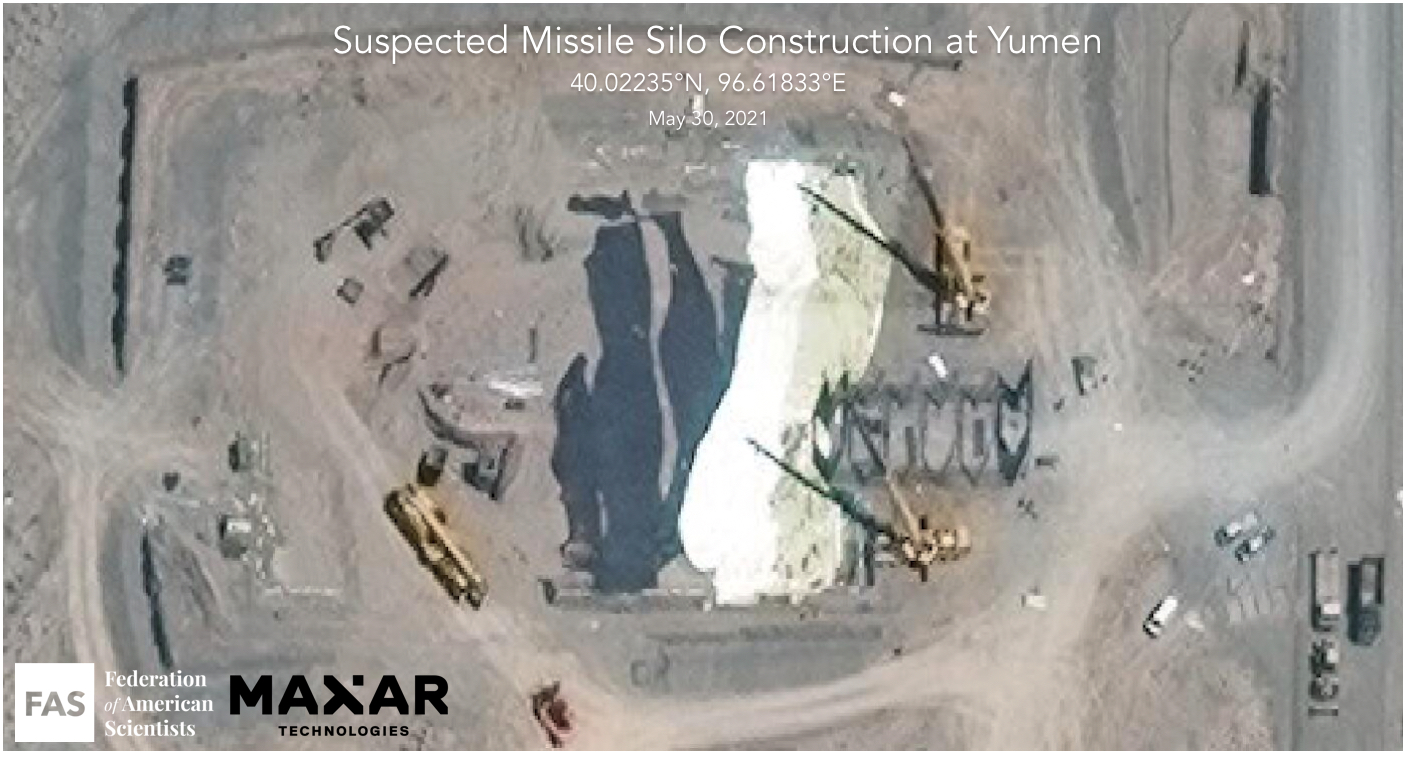
What’s underneath the shelters over China’s suspected silo construction sites? Image © 2021 Maxar Technologies
After the discovery during the summer of what appears to be at least three vast missile silo fields under construction near Yumen, Hami, and Ordos in north-central China, new commercial satellite images show significant progress at the three sites as well as at the People’s Liberation Army Rocket Force (PLARF)’s training site near Jilantai.
The images provide a vivid and rare public look into what is otherwise a top-secret and highly sensitive construction program. The Chinese government has still not officially confirmed or denied that the facilities under construction are silos intended for missiles and there are many uncertainties and unknowns about the nature and role of the facilities. In this article we use words like suspected, apparent, and probable to remind the reader of that fact.
Yet our analysis of hundreds of satellite images over the past three years of the suspected missile silo fields and the different facilities that are under construction at each of them have increased our confidence that they are indeed related to the PLARF’s modernization program. In recent analysis of new satellite images obtained from Planet Labs and Maxar Technologies, we have observed almost weekly progress in construction of suspected silos as well as discovered unique facilities that appear intended to support missile operations once the silo fields become operational.
In this article we describe the progress we have observed. We first describe the shelters, then what we see under the shelters, unique support facilities, and end with overall observations.
Shelter Features and Activities
Some of the most visible features at each of China’s newly-discovered probable missile silo fields are the environmental shelters that cover each suspected silo headworks. It was these structures, first seen at Jilantai, that led to the discovery of the three large suspected missile silo fields. Shelters are not new phenomena in Chinese missile construction; declassified reports from the US National Photographic Interpretation Center suggest that in the 1970s and 1980s China used a mixture of “large rectangular covers,” “camouflage nets,” and other types of shelters to protect its silos from the elements, as well as from spy satellites above.
The construction progression typically goes like this: a space for each silo headworks is cleared, then the shelter is erected before large-scale excavation begins. Occasionally the silo hole – or part of it – is excavated first and the shelter is erected over it before the silo components are installed. Several satellite images show semi-circle structural forms that may be lowered into the hole and assembled to form the silo walls during this phase. Several months later, the shelter is removed, and construction continues in the open-air with less sensitive auxiliary structures.
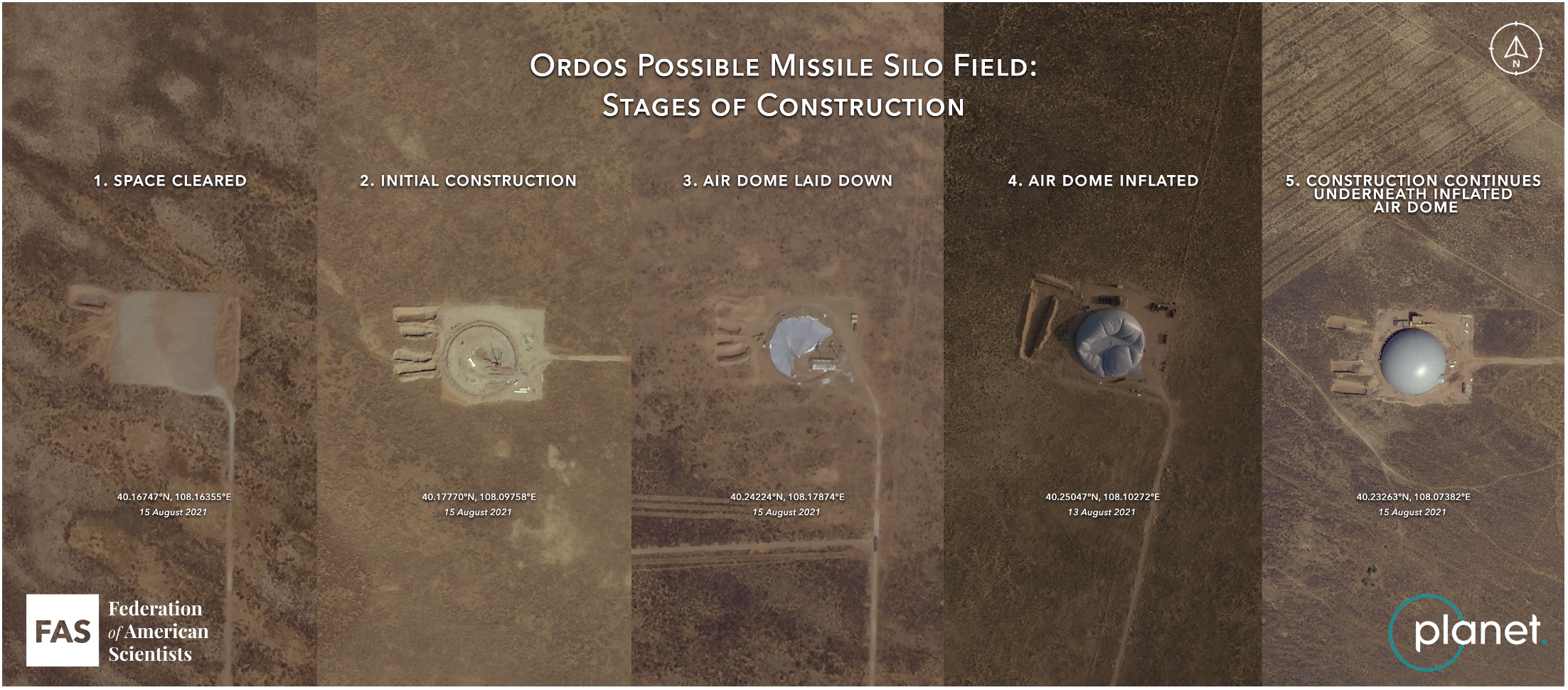
Suspected missile silos near Ordos at different stages of construction. Images © 2021 Planet Labs.
Apart from hiding silo details from satellites, these environmental shelters play an important role in the construction process: winter temperatures in areas like the Jilantai training area can reach below -25 degrees Celsius and pouring concrete in cold temperatures can cause it to freeze and crack. Additionally, many of China’s suspected silo sites are located in desert areas with periodic sandstorms. Spring floods are another challenge, so many silo sites and roads are elevated above the ground level and often with barriers or tunnels to prevent water damage. Environmental shelters, therefore, help keep construction running smoothly and on schedule year round, and they can be erected and dismantled in just a couple of days.
Interestingly, China appears to be experimenting with several different types of shelters for each of its suspected silo fields. The reason for this may have to do with practical construction issues rather than what is being constructed under them.
- Short Rectangular Shelters
The most common shelter visible at China’s suspected silo complexes is a rectangular dome-like structure very similar to those used at indoor tennis courts or soccer pitches. Each structure appears to be air-inflated with an estimated area of 4,125 square meters, and must be accessed through a series of airlocks––one for pedestrians and an extended one for vehicles. The external ventilation system provides climate control and a slight continuous overpressure inside the dome, allowing it to retain its rounded shape. See example of inflatable shelter.
Identical rectangular air domes are visible at the Jilantai missile training area, the suspected Yumen silo site, and the suspected Hami silo site. While this does not necessarily prove that identical construction is taking place underneath each dome, it does imply a connection of the activities at the three sites.
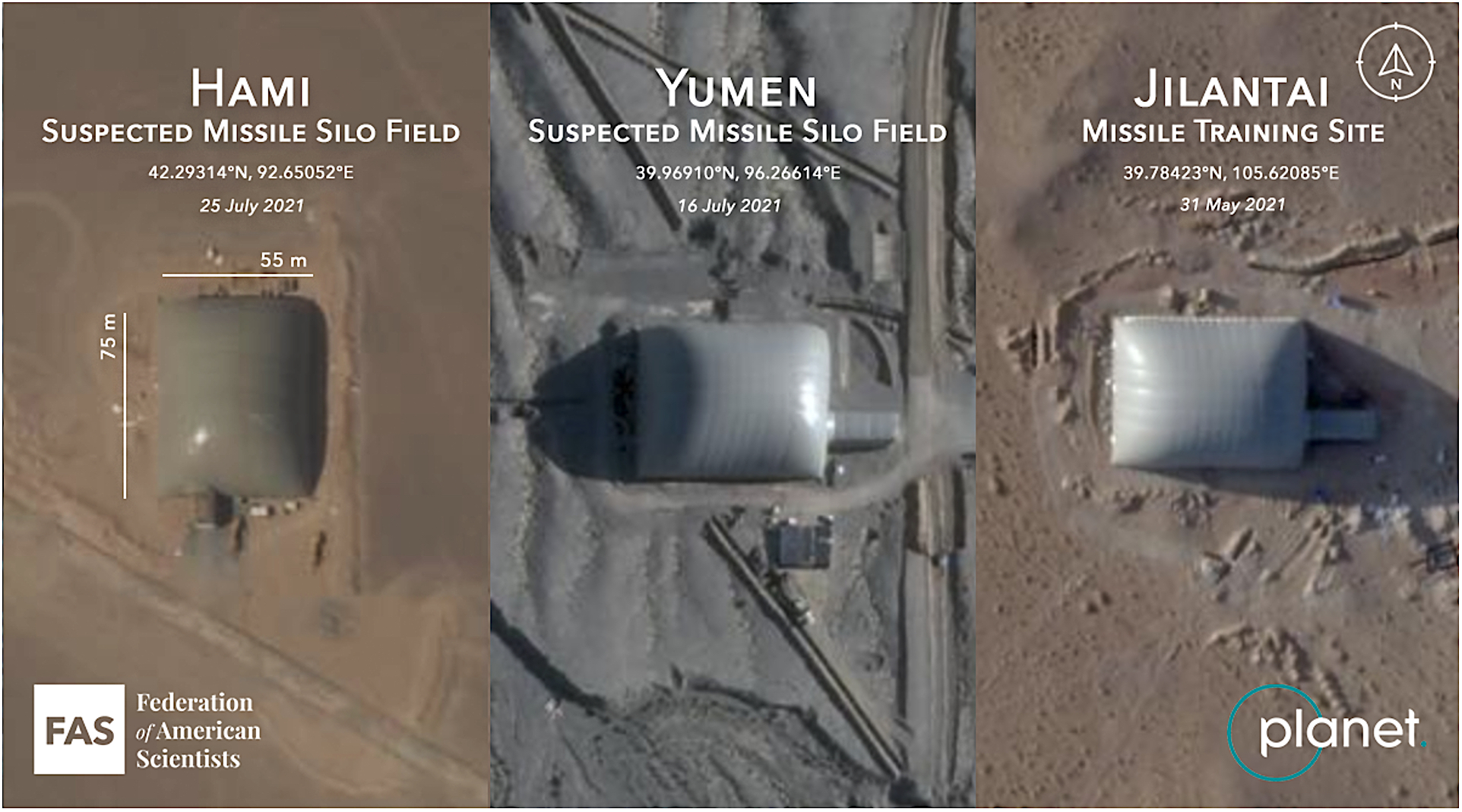
Identical shelter domes seen at Hami, Yumen, and Jilantai. Images © Planet Labs.
In July 2021, Capella Space––a satellite company specializing in synthetic aperture radar––imaged one of the domes at the Yumen site. The SAR image allowed analysts to see the outlines of some structures underneath the dome, although it is difficult to discern much from the image except the clearly-visible framework of the external airlock. There appears to be significant activity directly in the center of the dome, which is where the suspected silo hole appears to be located.
- Long Rectangular Shelters
At the suspected Hami silo field, we see deployment of a slightly longer variant of the regular dome shelter. The Hami site is at a later stage of development than its counterpart at Yumen. The structures measure approximately 20 meters longer than the aforementioned domes erected at Yumen and Jilantai, but otherwise appear to be very similar. One discernible difference between the two is that the vehicle airlock is not extended outside of the dome’s main structure but appears to be embedded within the dome itself.
Although the suspected silo site at Hami contains both types of inflatable domes, there are now more of the longer variant than the shorter version. Given that Hami is a newer site than both Yumen and Jilantai, it is possible that construction has now switched entirely to the longer version and will continue to use this structure for future sites. While Yumen does not appear to have any longer domes on-site, it is notable that some crude extensions to its shorter domes were erected there. This adds approximately 20 meters and expands the short dome to the size of the new longer dome (see image below).
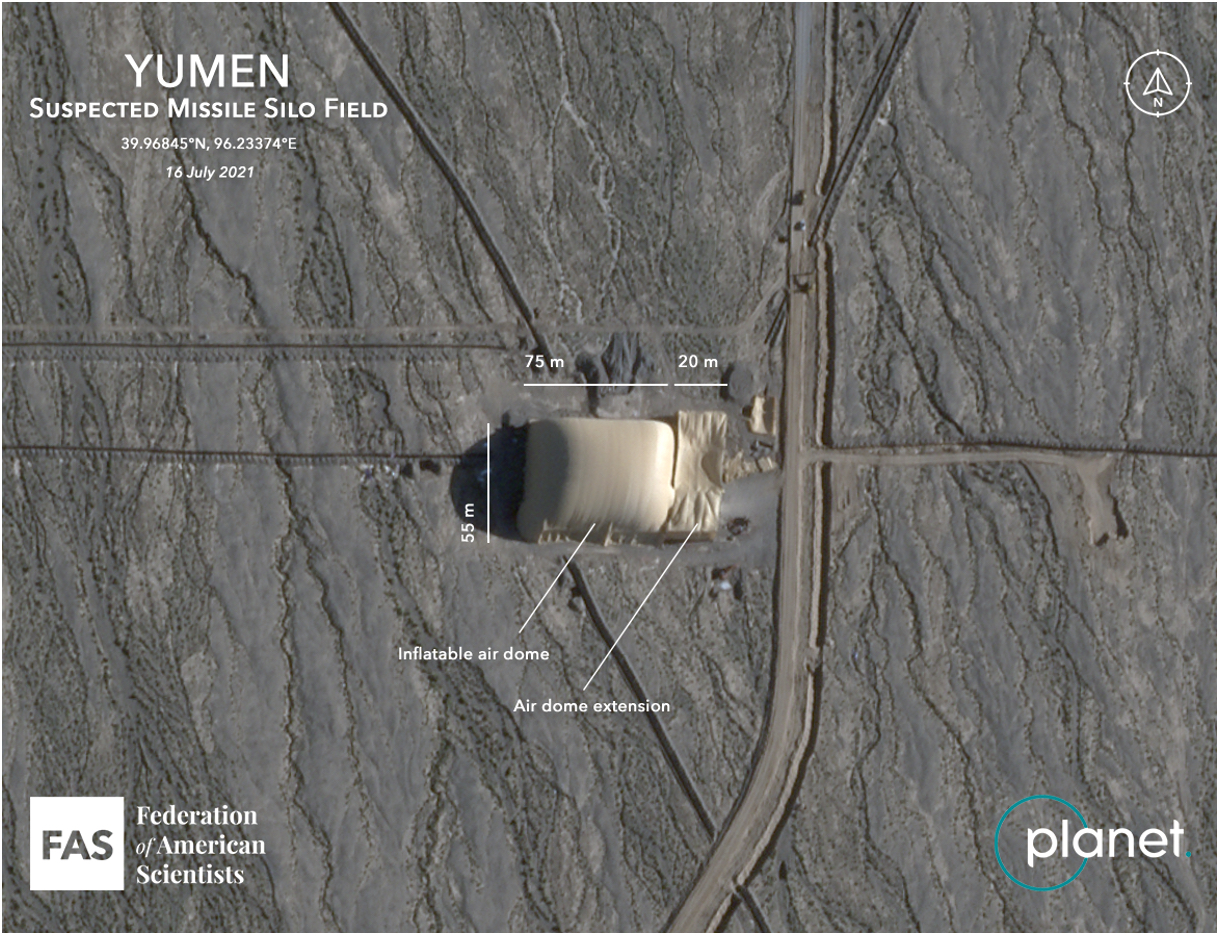
Some short dome shelters were extended. Image: © 2021 Planet Labs.
This reason for building longer dome shelters could indicate that silo excavation and construction activities required more space than the PLARF originally thought, and that they are now having to adjust for their newer sites. The estimated area of the longer domes is 4,925 square meters, excluding the approximately 300 square meters needed for the embedded vehicle airlock; this makes the total area slightly less than that of an NFL football field, which has an area of approximately 5,350 square meters.
- Round Shelters
At a third suspected missile silo field near Ordos is deploying a different type of inflatable air dome. Instead of the shorter and longer rectangular domes, the PLARF has opted to use round domes with circular bases. Interestingly, these circular domes appear to have several different types of patterns (see image below).
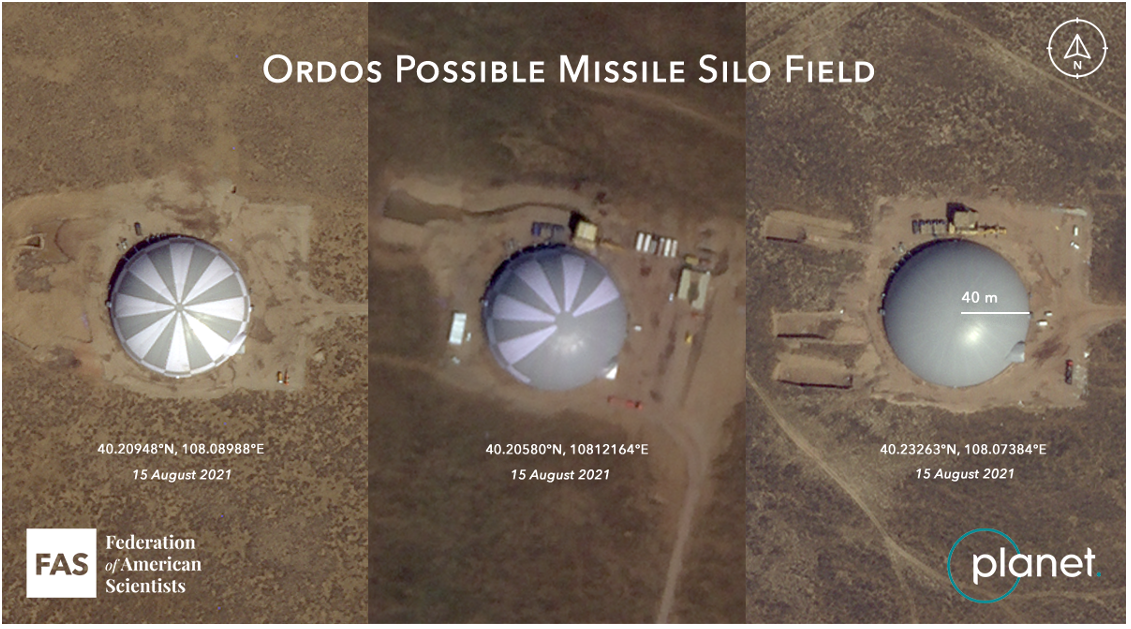
Round dome shelters at the suspected missile silo field near Ordos have more room but appear to serve the same purpose. Images © 2021 Planet Labs.
Other than the differences in shape and pattern, the domes appear to function the same way as the other sites. Similar to the longer rectangular air domes, the vehicle airlock appears to be embedded within the dome itself.
There are some potential advantages to these circular domes, compared to the rectangular domes used at Yumen, Hami, and Jilantai. A rounder shape is stronger than a rectangular one, and offers the maximum amount of internal space with the least amount of surface area. This means that less fabric is needed to create the structure, thus creating a potential cost savings. The estimated area of the round domes is approximately 4,725 square meters, excluding the 300 square meters needed for the embedded vehicle airlock.
- Solid Shelters
The PLARF has also constructed solid, rectangular structures to temporarily cover some of its suspected missile silo sites. In 2018, Catherine Dill noted that a solid 32m x 66m gable-roofed structure had covered a silo at Wuzhai before it was removed in December 2017. In 2019, Hans Kristensen’s discovery of the Jilantai missile training area included a solid structure with similar measurements covering a newly-constructed silo; in total, the first four apparent silos at Jilantai were built under solid shelters. In 2020, Scott LaFoy and Decker Eveleth also noted the presence of four high-bay structures with similar measurements covering previously-identified DF-4 ICBM launch sites at Sundian.
In addition to these sites, 11 identical solid structures have been erected at the suspected Yumen missile silo site (see image below). These structures––which were among the very first structures erected at Yumen between March and October 2020––are outliers for the entire complex, which is subsequently has filled entirely with shorter dome shelters that were deployed later in the complex’s construction period (see image below).
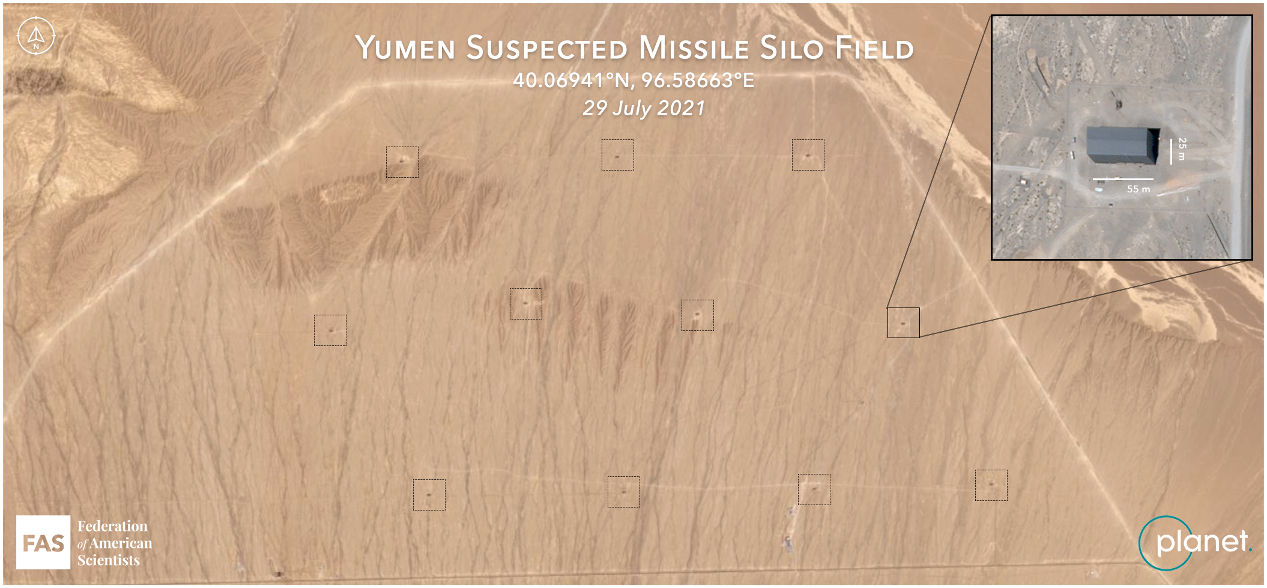
The first 11 shelters erected at Yumen were solid, like the first four at Jilantai. Click on image to full size. Image © 2021 Planet Labs.
What Is Underneath The Shelters?
Several shelters over suspected silo construction sites have now been removed, which allows us to better determine the possible function of the sites. The new satellite images show features that reaffirm that the sites appear to be silos in various stages of construction. A few satellite images taken at sites before the shelters were built already showed features strongly suggesting the sites were missile silos, and the first four sites at Jilantai are clearly silos. But with the growing number of shelters being removed, so far over 40, the evidence pointing to silo construction is in our assessment getting stronger.
Because silo construction at the PLARF training site near Jilantai began before construction at the three large missile silo fields, developments at Jilantai are likely precursors for events that will appear later at the other sites. One of the first four silos (39.76470°N, 105.53952°E) appears to show silo operations. Preparation of this site began in July 2019, and by early-August, satellite images showed excavation of a six-meter-wide deep hole inside a shallower 14–15-meter hole. The following month a shelter was built over the silo apparently to hide technical details from satellites. This was a solid shelter similar to the first 11 later constructed at Yumen. Once silo construction had been completed the shelter was dismantled while construction of access roads and command and control facilities continued. This summer, a Maxar satellite photo showed what appeared to be a missile loading operation at the site, and on October 29, a Planet Labs satellite photographed additional crane operations over the open silo. The silo is probably not yet operational.
The first four silos at Jilantai were covered by garage-like shelters. But in early 2021, dome-like shelters were erected over an additional 10 possible missile silos. These domes, or inflatable shelters, are identical or similar to the shelters over the vast majority of suspected silo sites at Hami, Yumi, and Ordos. In late-October, the dome shelters at Jilantai began to come down. A satellite image of one of these (39.72593°N, 105.52898°E) shows clear signs of a possible silo, first during the early stages immediately before the shelter was erected, and finally immediately after shelter was dismantled. Visible features include what appear to be a silo hatch, small auxiliary buildings, and ground markings from possible buried command and control cables or power lines. The other sites at Jilantai have the same features and dimensions.
The silo features are also clearly visible at Yumen, which began construction earlier than Hami and Ordos. So far, the shelters have been removed from at least 29 suspected silos at Yumen. The structures are very similar: an apparent silo hatch on an elevated dirt mound, with small auxiliary structures, a wide-turn access road presumably for use by missile transport and maintenance trucks. One of the apparent silo sites under construction at Yumen is shown below. Over the next several months, the remaining surface features will be completed.
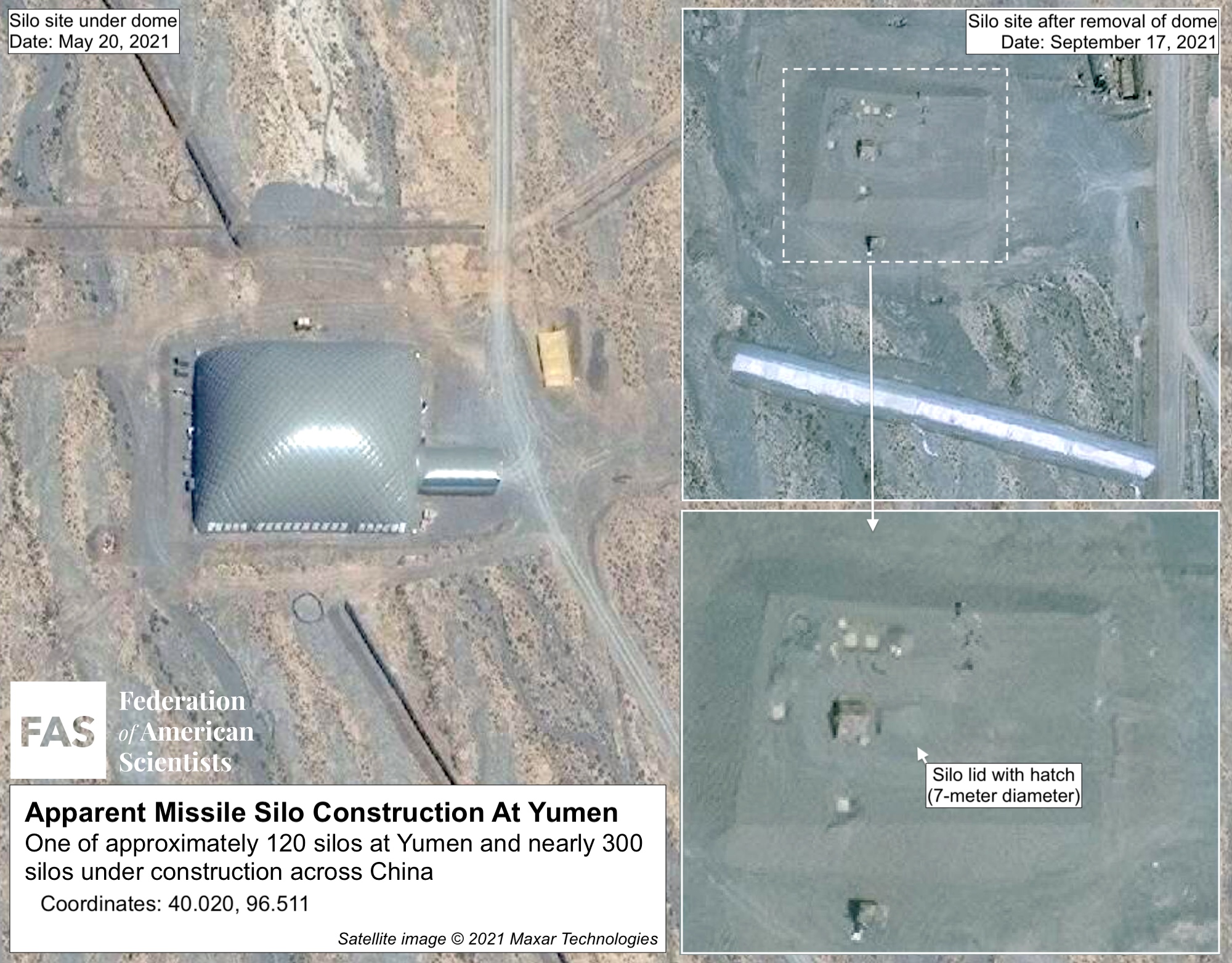
Suspected silos under construction at Yumen show features very similar to those observed at Jilantai. Click on image to view full size. Images © 2021 Maxar Technologies
Support Facilities
Operation of large missile silo fields requires extensive support infrastructure. This includes main base headquarters, technical support bases, missile and warhead support facilities, command and control infrastructure, electrical power supply, and roads. Many of the facilities under construction at the three suspected missile silo fields at Hami, Yumen and Ordos, as well as at the training site near Jilantai, appear intended to support such functions.
One of the most unique facilities under construction is a large complex that includes what appear to be three large parallel tubes embedded in trenches and connected to buildings via smaller tubes. Underground tunnels connect the three tubes, which might eventually be covered with soil. So far, this type of facility has been found at the Hami and Ordos missile silo fields (see image below), but not yet at Yumen. The function of these two facilities is unknown but could potentially be related to climate-controlled storage or handling of fragile missile and/or warhead components, or command bunker function. (Note: there is no evidence this is the case.)
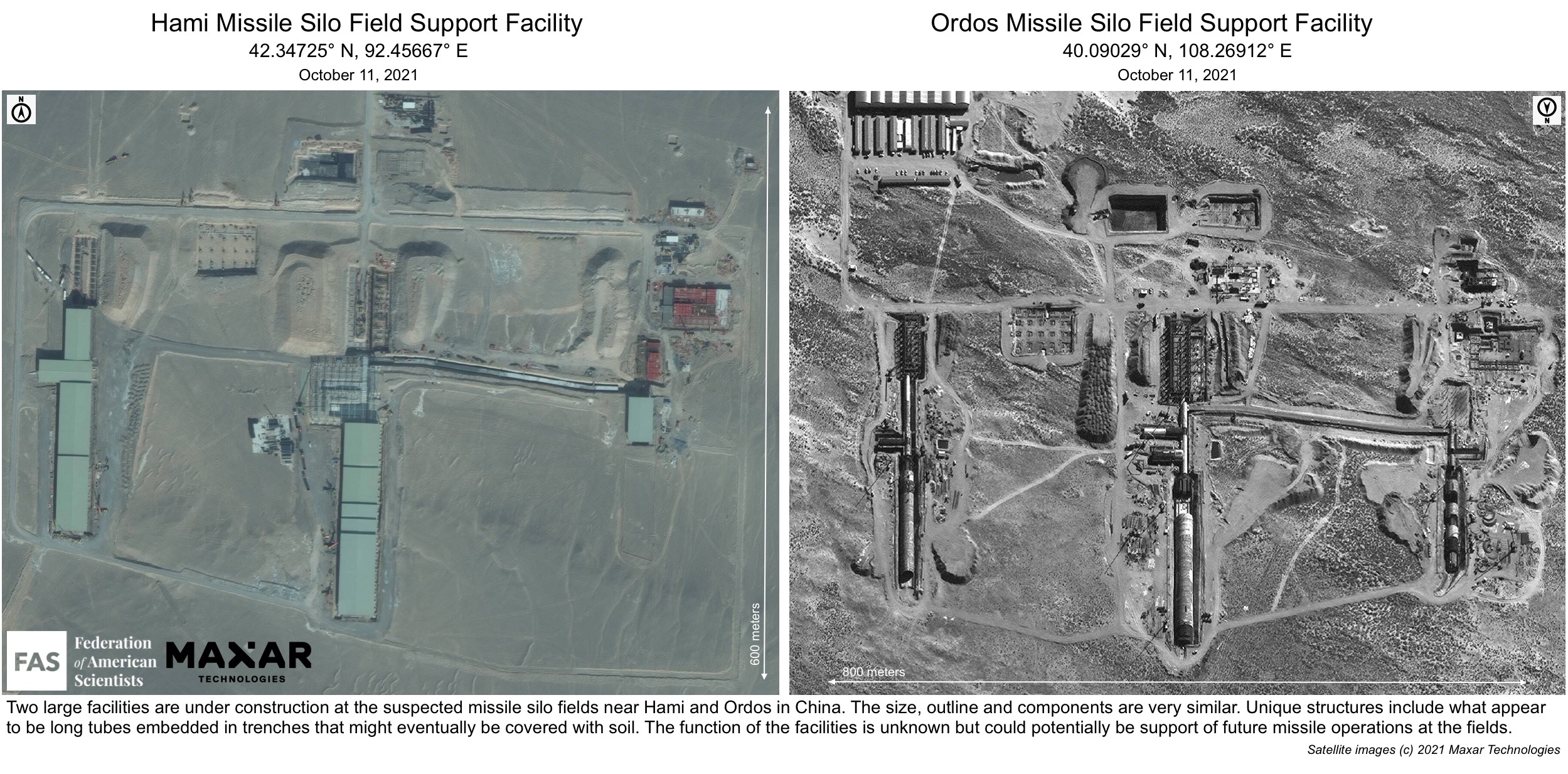
Large and unique support facilities are under construction at the suspected missile silo fields at Hami and Ordos. Click on image to view full size. Images © 2021 Maxar Technologies
Another unique facility so far seen only at Hami (42.2343°N, 92.897°E) includes a growing central complex in the mountains surrounded by what appear to be four tunnels into underground facilities. The tunnels are still under construction and show large amounts of excavation soil dumped nearby (see image below). The function of the facility is unknown but could potentially involve missile and/or warhead storage and management. Again, there is no evidence this is the case and is speculation at this point. The base-tunnel complex appears to be connected to the main missile silo grid via an underground cable. Sixty kilometers (37 miles) to the west (42.32163° N, 92.16282° E), at the other far side of the suspected missile field, is a similar facility with tunnels under construction.
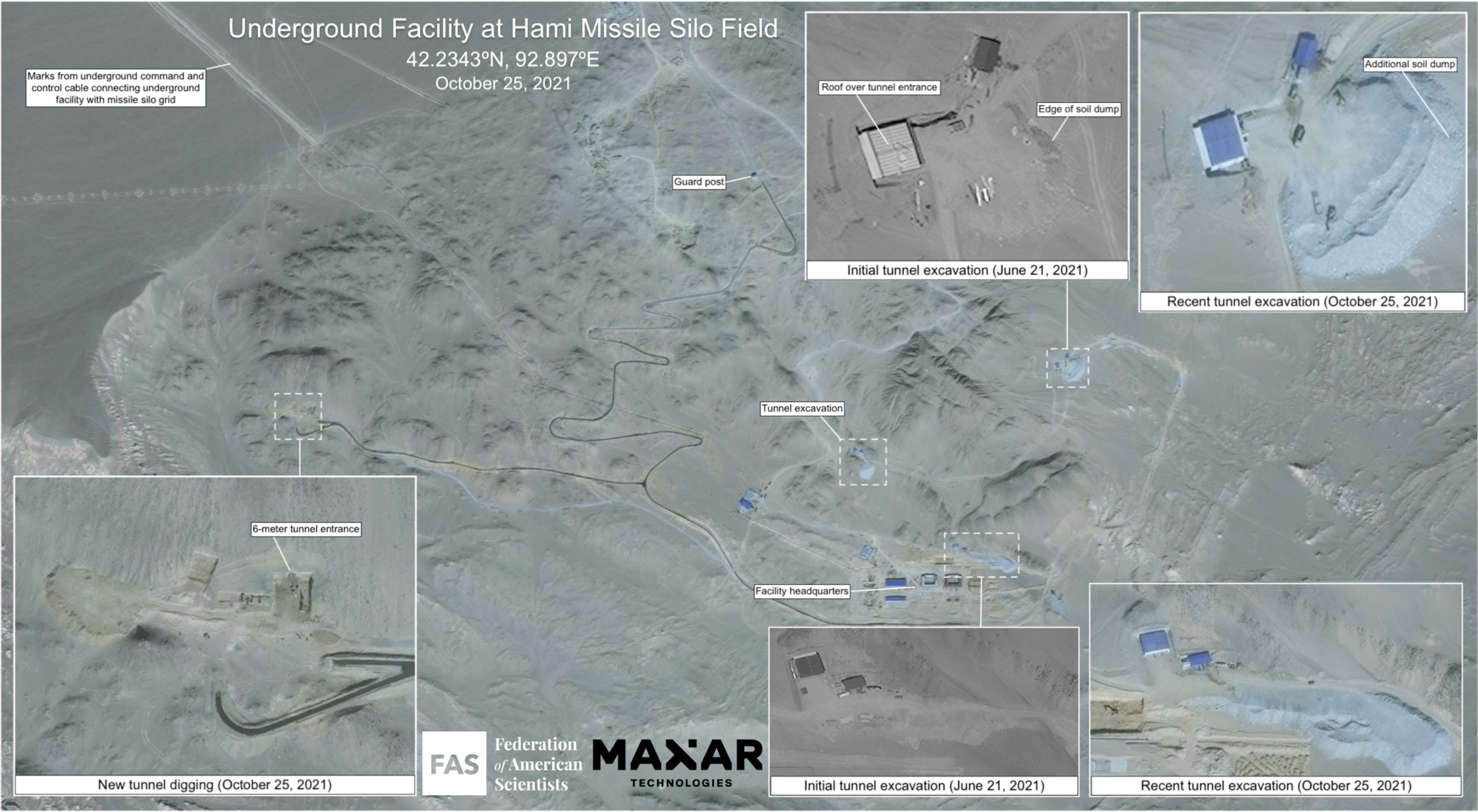
A large complex with several tunnels to underground facilities is under construction next to the suspected missile field at Hami. Click on image to view full size. Satellite images (©) 2021 Maxar Technologies.
There are also many other structures under construction that may be technical service facilities and launch control centers. Especially at Hami, we see construction of long lines of what may be powerlines intended to provide electrical power to the sprawling facilities. Finally, a number of larger and smaller construction camps and soil extraction sites are visible at all the suspected missile fields.
Interactive Maps
In order to help monitor and illustrate the construction of China’s suspected missile silo fields, the Federation of American Scientists has created an interactive map for each of the suspected missile silo fields at Yumen, Hami and Ordos (see example of Yumen below). Each map has a slider that allows the viewer to see how the construction of major facilities has progressed over time. These maps will be updated as construction continues. To access the maps, use these links:
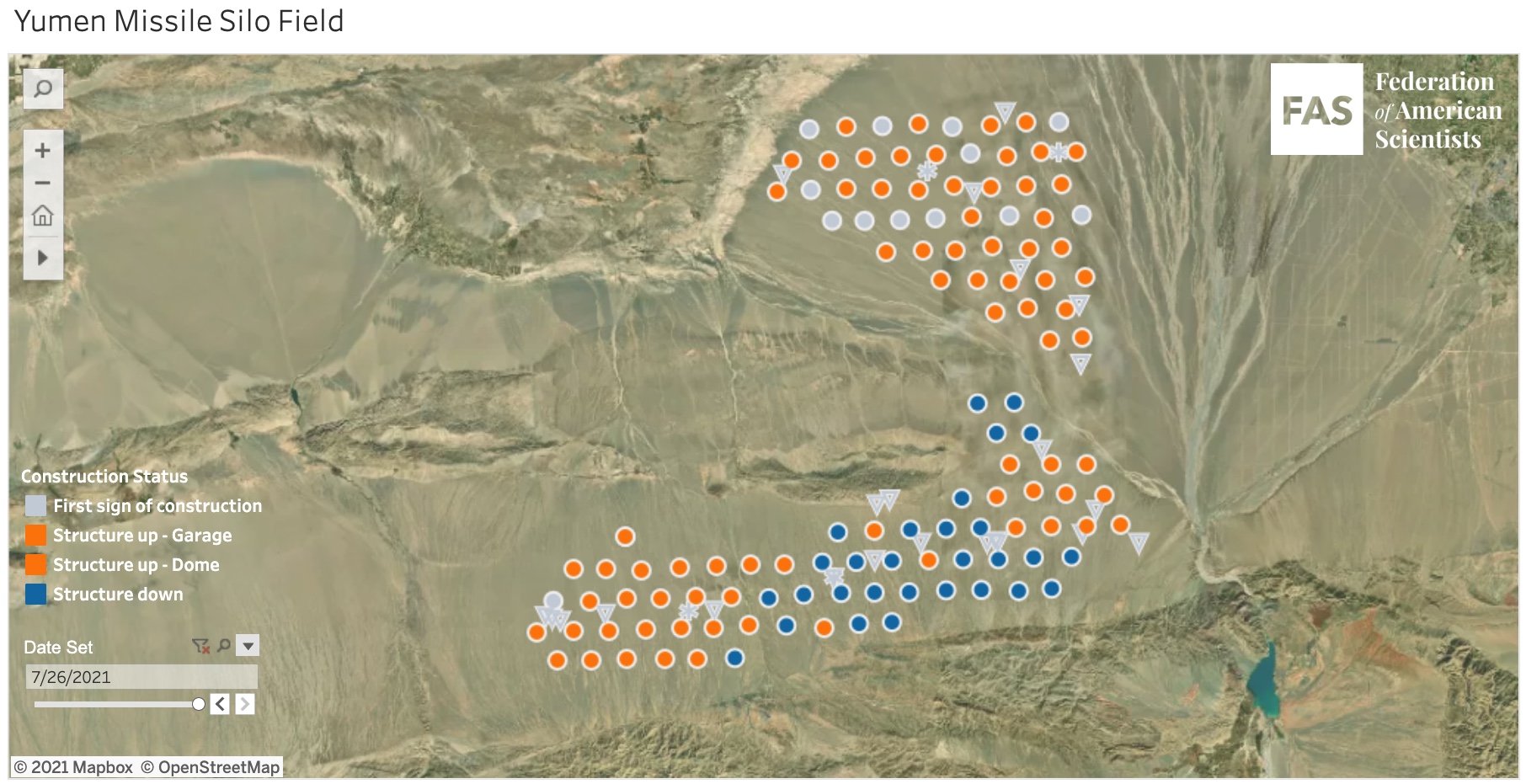
FAS is building three interactive maps to enable the public to monitor the construction of China’s three suspected missile silo fields.
Concluding Thoughts
The similarities of the structures and the construction activities at the Jilantai training area and the three suspected missile silo fields under construction near Yuman, Hami, and Ordos all show what appear to be a clear connection to the PLARF’s missile program. Early on, this connection was most visible at Jilantai, where commercial satellite imagery captured telltale semi-circle silo wall structures, silo hatches, and even a potential missile loading operation. With construction progressing at the larger missile fields at Yumen, Hami and Ordos as described in this article, we see strong indications in the satellite images of what appear to be construction of missile silos and support facilities.
It is notable that at this time, no other inflatable air dome complexes on this scale have been spotted at other sites in China. Some sites (for example: 40.18064° N, 107.53670° E) appear to have similar (but much shorter) spacing patterns to those seen at the suspected silo fields; however, at higher imagery resolutions it becomes clear that those structures are not dome shelters or silos, but are in fact much smaller and very different structures for windmills. It is potentially possible that some windmills will be constructed in between the apparent silos; there is some evidence of that at Yumen. We note that some US ICBM silos are also in close proximity of windmills (for example: 40.8222, -104.0505); this does not appear to interfere with silo operations but can effect helicopter operations in the area.
Although we are increasingly confident that the facilities we describe are related to the PLARF’s missile program, it is also important to exercise caution and avoid confirmation bias––particularly if there are additional relevant sites out there that have not yet been spotted on commercial satellite imagery. Nor do we know what China plans to load into the apparent missile silos or how many of them will eventually be armed. The Chinese government has not yet officially confirmed or denied that the facilities are missile silos. But U.S. military officials appear to have confirmed that the reported missile silo fields are part of China’s nuclear modernization program. And based on the features we can examine on the new satellite images, we are increasingly confident that the facilities are indeed missile silos and support facilities under construction.
For China, this is an unprecedented nuclear buildup. We and others have remarked that it raises questions and uncertainty about China’s minimum nuclear deterrent and policies. On the other hand, even construction of large number of silos may not necessarily reflect a change in the basic role the Chinese leadership attributes to its nuclear forces. For example, China could potentially still retain its no-first-use policy. The apparent missile silo fields are still many years away from becoming fully operational and it remains to be seen how China will arm and operate them.
It is important that the buildup does not further increase nuclear competition and fuel worst-case planning in other nuclear weapon states, although we fear those are likely outcomes. These developments will feature prominently in the Biden administration’s ongoing Nuclear Posture Review and we urge the administration not to overreact but pursue conversations with the Chinese government to develop measures to reduce tension and increase transparency.
The reason is obvious: Although China has so far rejected limits on its nuclear forces by arguing that “Countries with the largest nuclear arsenals [Russia and the United States] have special and primary responsibilities in nuclear disarmament,” the size of the Chinese missile silo program – combined with the other elements of China’s nuclear modernization – could bring China into that category in the not too distant future. With approximately 300 apparent silos under construction – a number that exceeds the number of ICBM silos operated by Russia – and an additional 100-plus road-mobile ICBM launchers, China’s total ICBM force could potentially exceed that of either Russia and the United States in the foreseeable future.
This worrisome development may ironically also create new opportunities for arms control discussions and potential agreements. That is, if there is the political will to pursue them. With the review conference of the nuclear Non-Proliferation Treaty approaching early next year, this would seem to be a good time for the large nuclear powers to demonstrate that will.
Background information:
- China’s nuclear missile silo expansion: From minimum deterrence to medium deterrence (2021)
- China Is Building A Second Nuclear Missile Silo Field (2021)
- SIPRI Yearbook World Nuclear Forces (with China section), 2021
- China’s Expanding Missile Training Area: More Silos, Tunnels, and Support Facilities (2020)
- New Missile Silo And DF-41 Launchers Seen In Chinese Nuclear Missile Training (2019)
- Status of world nuclear forces
This publication was made possible by generous support from the John D. and Catherine T. MacArthur Foundation, the New Land Foundation, the Ploughshares Fund, and the Prospect Hill Foundation. The statements made and views expressed are solely the responsibility of the author.
US Army Views Chinese Military Tactics
How would China fight a war against the US?
A new US Army publication sets out to answer that question, offering a detailed account of the military tactics China could employ. See Chinese Tactics, Army Techniques Publication (ATP) 7-100.3, August 9, 2021.
The 250-page document is mainly intended to help provide a realistic basis for training of US forces. But in doing so it sheds some new light on China’s military forces, at least as they are perceived by US military observers. It is based primarily on open sources.
“This publication presents PLA [People’s Liberation Army] military theory largely as written and prescribed by the PLAA [PLA Army],” the manual says. “Real world practices of PLA units are . . . generally not included as part of the analysis underpinning this document.”
The description of Chinese military tactics is necessarily speculative to some extent. “The PLA has not participated in an active conflict in nearly half a century, so real-world applications are minimal. [But] available information on Chinese military training exercises and the few recent examples of conflict seem to indicate that PLA practices — including those of the PLAA — conform closely to its military theory.”
As for the command structure of the Chinese military, it “is complex and opaque to outsiders. . . . There are no fewer than ten different national-level command organizations in China, organized across at least three different levels of a complex hierarchy.”
“Deception plays a critical role in every part of the Chinese approach to conflict,” according to the document. “Rather than focusing on defeating the opponent in direct conflict — as most Western militaries do — [Chinese military] stratagems consider deception, trickery, and other indirect, perception-based efforts to be the most important elements of an operation.”
* * *
The current volume on China is the second in a new Army series on foreign military tactics. A previous volume on North Korean Tactics (ATP 7-100.2) was published last year. Two more volumes on Russian Tactics (ATP 7-100.1) and Iranian Tactics (ATP 7-100.4) are expected to appear later this year.
While unclassified, “these assessments are based on the most up-to-date information available,” wrote Army intelligence specialist Jennifer Dunn (“Training Today’s Army for Tomorrow’s Threats,” Military Intelligence Professional Bulletin, Oct-Dec 2020). “Subject matter experts within the Department of Defense and intelligence communities have vetted them, ensuring their veracity and applicability to the greater Army training and intelligence community.”
“It is also essential for the Army, especially for the regionally aligned elements, to thoroughly understand the adversary they are most likely to encounter in future conflicts,” she wrote, in an unwitting paraphrase of Sun Tzu’s famous dictum about knowing the enemy.
* * *
The US government can and should do far more to produce such open source materials on national security and foreign policy, say some members of Congress. A bill (HR 4747) sponsored by Rep. Joaquin Castro and several bipartisan colleagues, would create a new “Open Translation and Analysis Center (OTAC).”
“OTAC would be charged with translating into English important open source foreign-language material from the People’s Republic of China, Russia, and other countries of strategic interest,” according to a July 28 news release. “The translated material would be available on a public website, serving as a key resource for the U.S. and allied governments, media outlets, and academics and analysts around the world.”
“Along with translations, OTAC would provide information to help readers understand the meaning and significance of the published material. It would also produce key analyses of translated material to enhance the understanding of the governments and political systems it covers.”
For decades the US intelligence community provided open source materials to the public through the CIA’s Foreign Broadcast Information Service (FBIS). But that mission has been abandoned by US intelligence and the Open Source Enterprise, the successor to FBIS, has gone completely dark as far as the public is concerned.
Countering China’s Monopolization of African Nations’ Digital Broadcasting Infrastructure
Summary
The majority of people living in the African continent access their news and information from broadcasted television and radio. As African countries follow the directive from the International Telecommunication Union (ITU) to migrate from analog to digital broadcasting, there is an urgent need to sequester the continent’s broadcast signal distributors (BSDs).1 BSDs provide the necessary architecture for moving broadcasted content (e.g., television and radio) into the digital sphere.
Most BSDs in Africa are owned and operated by Chinese companies. Of 23 digitally migrated countries, only four BSDs (Burkina Faso, Ghana, Guinea, and Zimbabwe) are officially known to be outside the influence of China-based companies. The implicit capture of the BSD marketplace by the People’s Republic of China (PRC) threatens African democracies and could undermine international partnerships among African nations and with the United States. Excessive Chinese control over African BSDs also raises security concerns and impedes establishment of a robust, competitive, and rules-based global market in communications infrastructure.
The United States should therefore consider the following actions to support African civil society, media regulators, and legislators in securing an information ecosystem that advances democratic values:
- Creating a Program on Traditional and Digital Media Literacy within the Department of State’s Bureau of African Affairs 2021 Africa Regional Democracy Fund.
- Supporting a Regional Digital Broadcasting Coordinator for each of the five African sub-regional groups, via the Digital Ecosystem Fund and the Digital Connectivity and Cybersecurity Partnership.
- Enhancing U.S.-based competitiveness by expanding the Digital Attaché Program to promote alternative BSDs in Africa.
- Leveraging the U.S.-Africa Leaders Summit proposed in the U.S. Innovation and Competition Act to advance a regulatory and liability framework governing the relationships among BSDs, content producers, and constitutional protections.
China Is Building A Second Nuclear Missile Silo Field
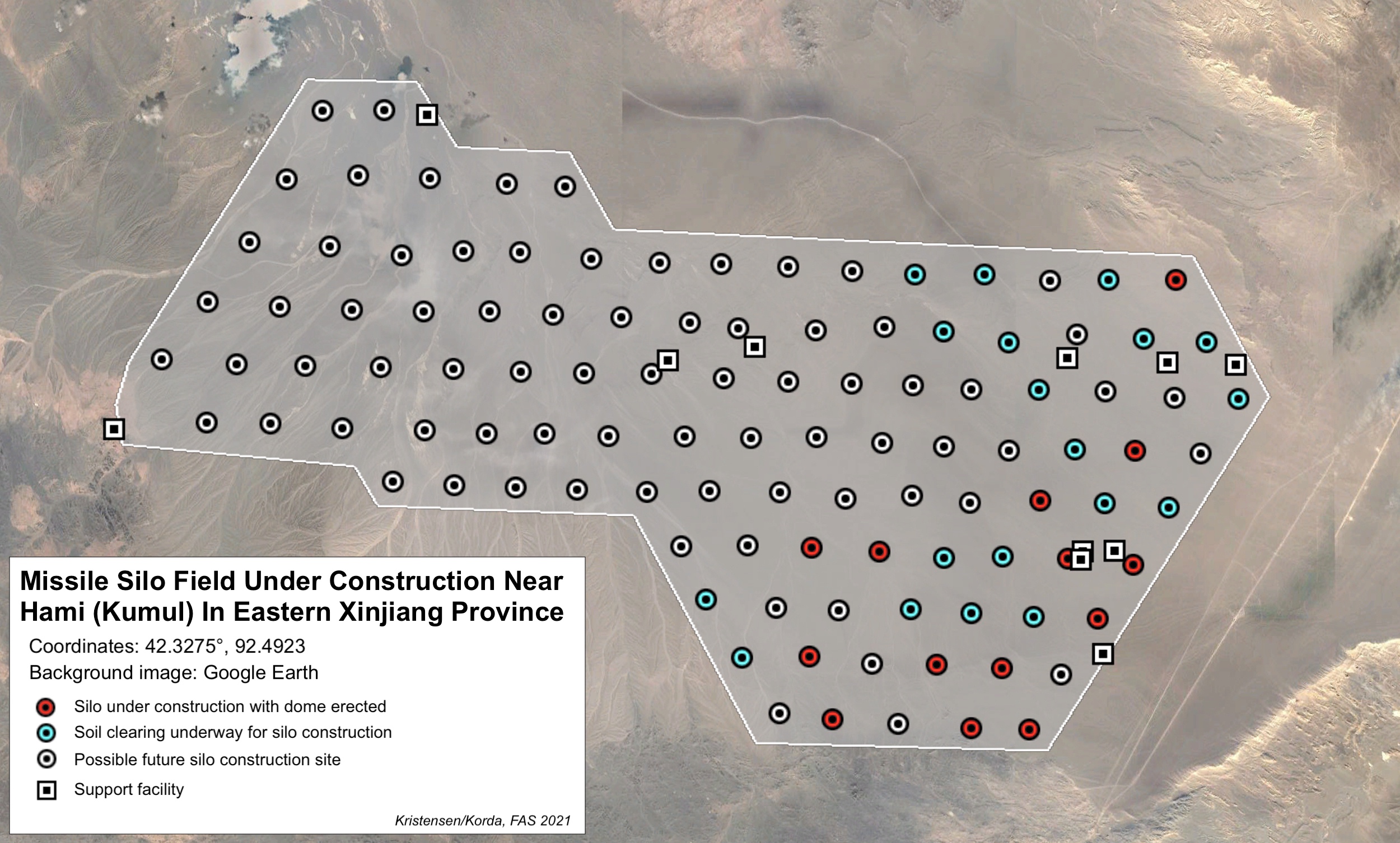
The Hami missile silo field covers an area of about 800 square kilometers and is in the early phases of construction.
Satellite images reveal that China is building a second nuclear missile silo field. The discovery follows the report earlier this month that China appears to be constructing 120 missile silos near Yumen in Gansu province. The second missile silo field is located 380 kilometers (240 miles) northwest of the Yumen field near the prefecture-level city of Hami in Eastern Xinjiang.
The Hami missile silo field is in a much earlier stage of development than the Yumen site. Construction began at the start of March 2021 in the southeastern corner of the complex and continues at a rapid pace. Since then, dome shelters have been erected over at least 14 silos and soil cleared in preparation for construction of another 19 silos. The grid-like outline of the entire complex indicates that it may eventually include approximately 110 silos.
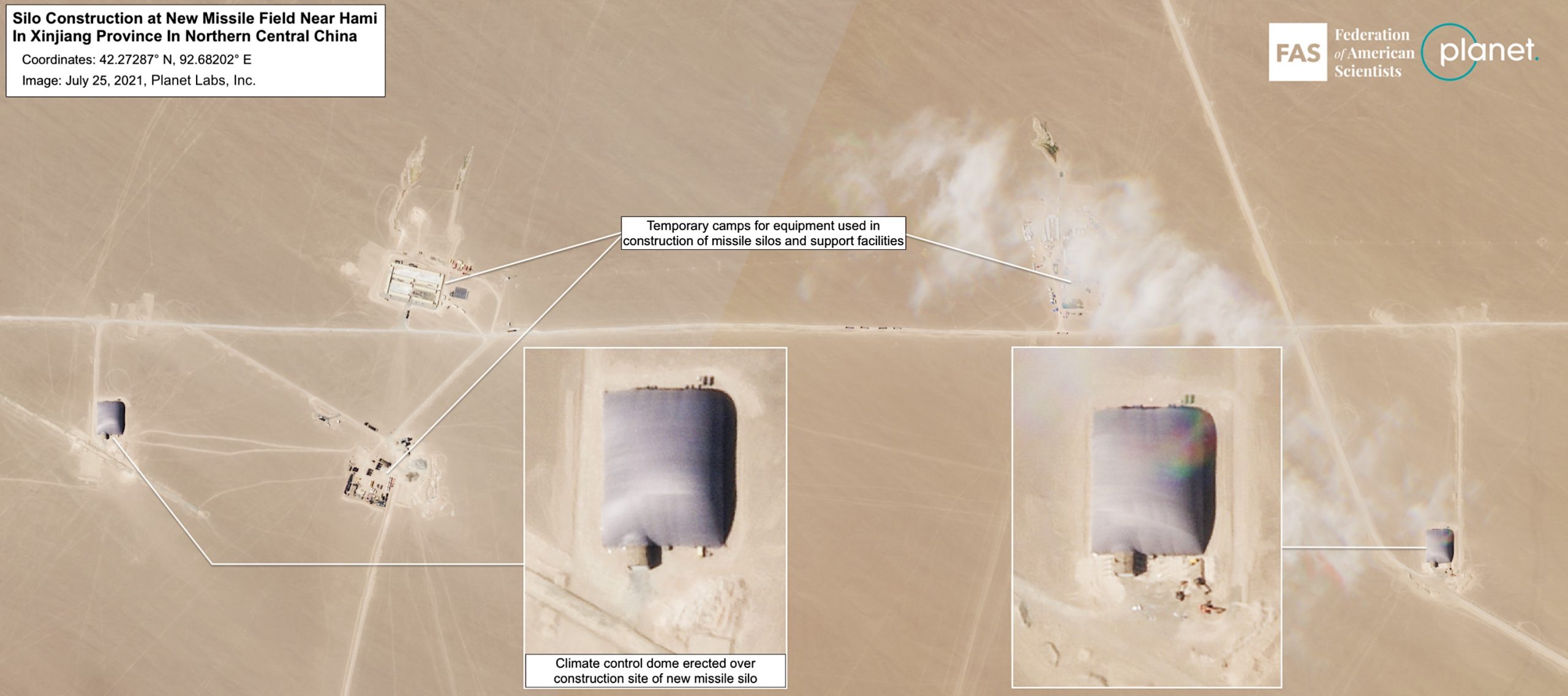
Dome structures have been erected over 14 silo construction sites. Preparation is underway for another 19, and the entire missile field might eventually include 110 silos.
The Hami site was first spotted by Matt Korda, Research Associate for the Nuclear Information Project at the Federation of American Scientists, using commercial satellite imagery. Higher resolution images of the site were subsequently provided by Planet.
The silos at Hami are positioned in an almost perfect grid pattern, roughly three kilometers apart, with adjacent support facilities. Construction and organization of the Hami silos are very similar to the 120 silos at the Yumen site, and are also very similar to the approximately one-dozen silos constructed at the Jilantai training area in Inner Mongolia. These shelters are typically removed only after more sensitive construction underneath is completed. Just like the Yumen site, the Hami site spans an area of approximately 800 square kilometers.
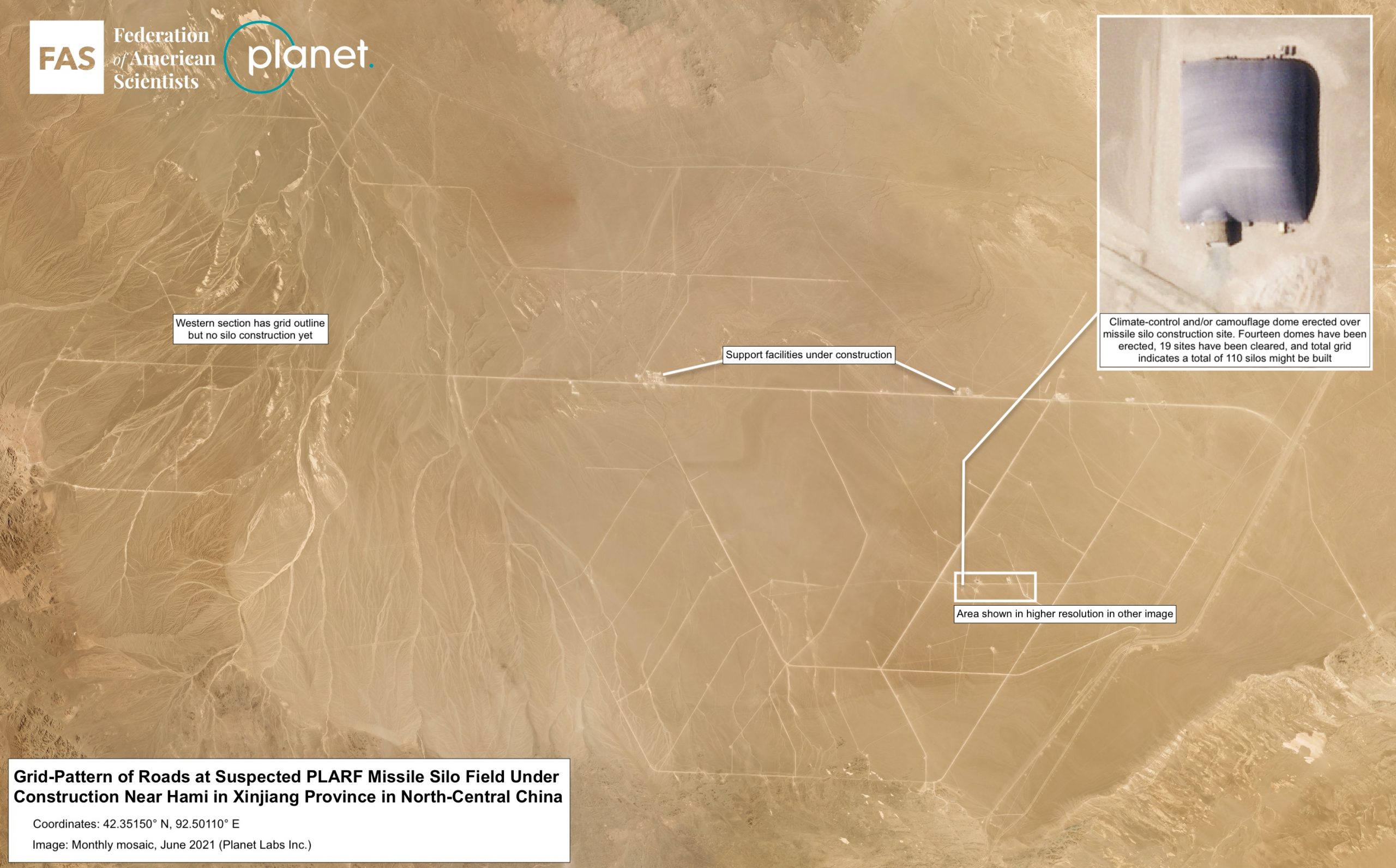
The Hami missile silo field has a grid-pattern where the silos are located approximately 3 kilometers from each other.
Impact on the Chinese nuclear arsenal
The silo construction at Yumen and Hami constitutes the most significant expansion of the Chinese nuclear arsenal ever. China has for decades operated about 20 silos for liquid-fuel DF-5 ICBMs. With 120 silos under construction at Yumen, another 110 silos at Hami, a dozen silos at Jilantai, and possibly more silos being added in existing DF-5 deployment areas, the People’s Liberation Army Rocket Force (PLARF) appears to have approximately 250 silos under construction – more than ten times the number of ICBM silos in operation today.
The number of new Chinese silos under construction exceeds the number of silo-based ICBMs operated by Russia, and constitutes more than half of the size of the entire US ICBM force. The Chinese missile silo program constitutes the most extensive silo construction since the US and Soviet missile silo construction during the Cold War.
The 250 new silos under construction are in addition to the force of approximately 100 road-mobile ICBM launchers that PLARF deploys at more than a dozen bases. It is unclear how China will operate the new silos, whether it will load all of them with missiles or if a portion will be used as empty decoys. If they are all loaded with single-warhead missiles, then the number of warheads on Chinese ICBMs could potentially increase from about 185 warheads today to as many as 415 warheads. If the new silos are loaded with the new MIRVed DF-41 ICBMs, then Chinese ICBMs could potentially carry more than 875 warheads (assuming 3 warheads per missile) when the Yumen and Hami missile silo fields are completed.
It should be emphasized that it is unknown how China will operate the new silos and how many warheads each missile will carry. Regardless, the silo construction represents a significant increase of the Chinese arsenal, which the Federation of American Scientists currently estimates includes approximately 350 nuclear warheads. The Pentagon stated last year that China had “an operational nuclear warhead stockpile in low-200s,” and STRATCOM commander Adm. Charles Richard said early this year that “China’s nuclear weapons stockpile is expected to double (if not triple or quadruple) over the next decade.” The new silos could allow China to accomplish this goal, if it is indeed the goal.
Although significant, even such an expansion would still not give China near-parity with the nuclear stockpiles of Russia and the United States, each of whom operate nuclear warhead stockpiles close to 4,000 warheads.
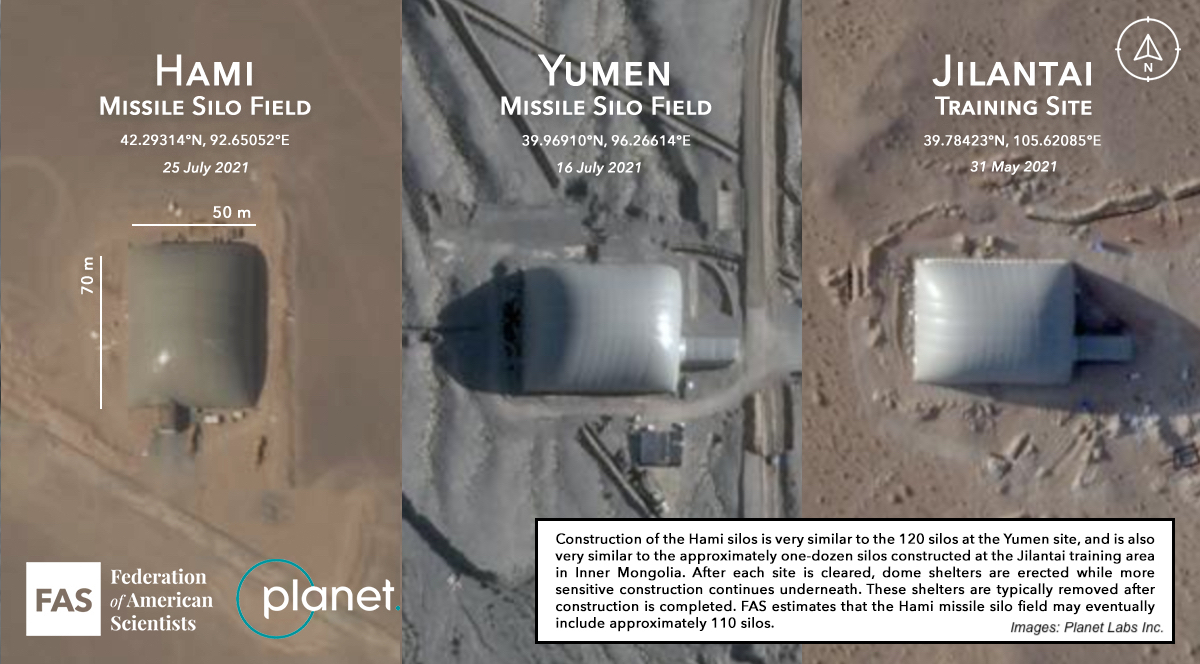
The Hami missile silo field domes are identical to silo domes seen at the Yumen missile silo field and the Jilantai training area.
Chinese motivations
There are several possible reasons why China is building the new silos. Regardless of how many silos China ultimately intends to fill with ICBMs, this new missile complex represents a logical reaction to a dynamic arms competition in which multiple nuclear-armed players––including Russia, India, and the United States––are improving both their nuclear and conventional forces as well as missile defense capabilities. Although China formally remains committed to its posture of “minimum” nuclear deterrence, it is also responding to the competitive relationship with countries adversaries in order to keep its own force survivable and capable of holding adversarial targets at risk. Thus, while it is unlikely that China will renounce this policy anytime soon, the “minimum” threshold for deterrence will likely continue to shift as China expands its nuclear arsenal. The decision to build the large number of new silos has probably not been caused by a single issue but rather by a combination of factors, listed below in random order:
Ensuring survivability of nuclear retaliatory capability: China is concerned that its current ICBM silos are too vulnerable to US (or Russian) attack. By increasing the number of silos, more ICBMs could potentially survive a preemptive strike and be able to launch their missiles in retaliation. China’s development of its current road-mobile solid-fuel ICBM force was, according to the US Central Intelligence Agency, fueled by the US Navy’s deployment of Trident II D5 missiles in the Pacific. This action-reaction dynamic is most likely a factor in China’s current modernization.
Increasing the readiness of the ICBM force: Transitioning from liquid-fuel missiles to solid-fuel missiles in silos will increase the reaction-time of the ICBM force.
Protecting ICBMs against non-nuclear attack: All existing DF-5 silos are within range of US conventional cruise missiles. In contrast, the Yumen and Hami missile silo fields are located deeper inside China than any other Chinese ICBM base (see map below) and out of reach of US conventional missiles.
Overcoming potential effects of US missile defenses: Concerns that missile defenses might undermine China’s retaliatory capability have always been prominent. China has already decided to equip its DF-5B ICBM with multiple warheads (MIRV); each missile can carry up to five. The new DF-41 ICBM is also capable of MIRV and the future JL-3 SLBM will also be capable of carrying multiple warheads. By increasing the number of silos-based solid-fuel missiles and the number of warheads they carry, China would seek to ensure that they can continue to penetrate missile defense systems.
Transitioning to solid-fuel silo missiles: China’s old liquid-fuel DF-5 ICBMs take too long to fuel before they can launch, making them more vulnerable to attack. Handling liquid fuel is also cumbersome and dangerous. By transitioning to solid-fuel missile silos, survivability, operational procedures, and safety of the ICBM force would be improved.
Transitioning to a peacetime missile alert posture: China’s missiles are thought to be deployed without nuclear warheads installed under normal circumstances. US and Russian ICBMs are deployed fully ready and capable of launching on short notice. Because military competition with the United States is increasing, China can no longer be certain it would have time to arm the missiles that will need to be on alert to improve the credibility of China deterrent. The Pentagon in 2020 asserted that the silos at Jilantai “provide further evidence China is moving to a LOW posture.”
Balancing the ICBM force: Eighty percent of China’s roughly 110 ICBMs are mobile and increasing in numbers. The US military projects that number will reach 150 with about 200 warheads by 2025. Adding more than 200 silos would better balance the Chinese ICBM force between mobile and fixed launchers.
Increasing China’s nuclear strike capability: China’s “minimum deterrence” posture has historically kept nuclear launchers at a relatively low level. But the Chinese leadership might have decided that it needs more missiles with more warheads to hold more adversarial facilities at risk. Adding nearly 250 new silos appears to move China out of the “minimum deterrence” category.
National prestige: China is getting richer and more powerful. Big powers have more missiles, so China needs to have more missiles too, in order to underpin its status as a great power.
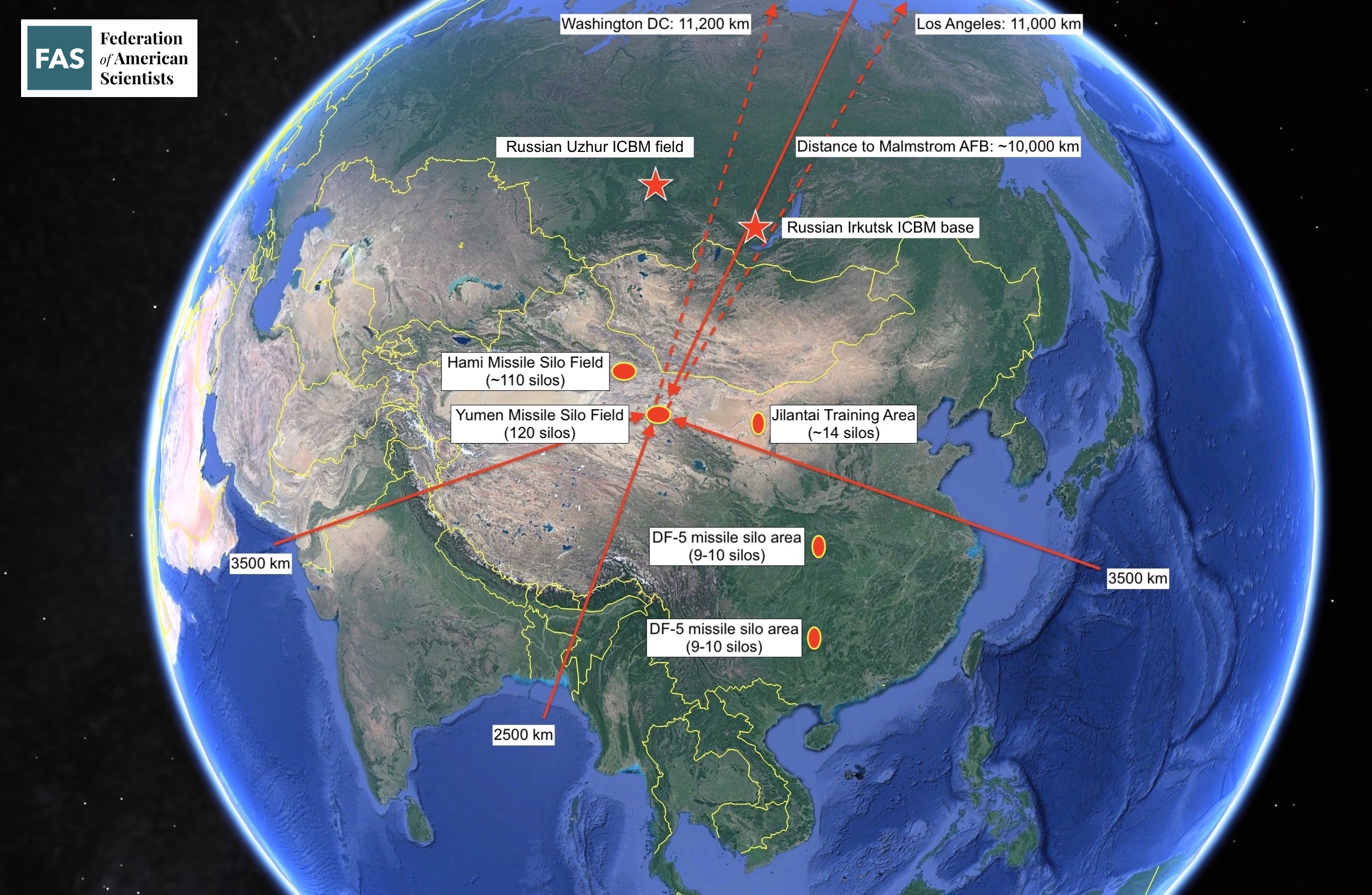
The Hami and Yumen missile silo fields are located deeper inside China than any other ICBM base and beyond the reach of conventional cruise missiles. Click on image to view full size. Image: Google Earth.
What to do about it?
China’s construction of nearly 250 new silos has serious implications for international relations and China’s role in the world. The Chinese government has for decades insisted it has a minimum deterrent and that it is not part of any nuclear arms race. Although it remains unclear how many silos will actually be filled with missiles, the massive silo construction and China’s other nuclear modernization programs are on a scale that appears to contradict these polices: the build-up is anything but “minimum” and appears to be part of a race for more nuclear arms to better compete with China’s adversaries. The silo construction will likely further deepen military tension, fuel fear of China’s intensions, embolden arguments that arms control and constraints are naïve, and that US and Russian nuclear arsenals cannot be reduced further but instead must be adjusted to take into account the Chinese nuclear build-up.
The disclosure of the second Chinese silo missile field comes only days before US and Russian negotiators meet to discuss strategic stability and potential arms control measures. Responding to the Chinese build-up with more nuclear weapons would be unlikely to produce positive results and could cause China build up even more. Moreover, even when the new silos become operational, the Chinese nuclear arsenal will still to be significantly smaller than those of Russia and the United States.
The clearest path to reining in China’s nuclear arsenal is through arms control, but this is challenging. The United States has been trying to engage China on nuclear issues since the late-1990s, but so far with minimal success. Rather than discuss specific limitations on weapon systems, these efforts have been limited to increasing transparency about force structure plans and strategy, and well as discussing nuclear doctrine and intentions.
The Trump administration correctly sought to broaden nuclear arms control to include China, but fumbled the effort by turning it into a public-relations pressure stunt and insisting that China should be part of a New START treaty extension. Beijing not surprisingly rejected the effort, and Chinese officials have plainly stated that “it is unrealistic to expect China to join [the United States and Russia] in a negotiation aimed at nuclear arms reduction,” particularly while China’s arsenal remains a fraction of the size.
Bringing China and other nuclear-armed states into a sustained arms control dialogue will require a good-faith effort that will require the United States to clearly articulate what it is willing to trade in return for limits on Chinese forces. In this regard, it is worth noting that the absence of limits on US missile defenses is of particular and longstanding concern to both China and Russia. When the Bush administration decided to withdraw from the Anti-Ballistic Missile Treaty in 2002, officials from both countries explicitly stated that the treaty’s demise would be highly destabilizing, and implied that they would take steps to offset this perceived US advantage. Nearly 20 years later, the knock-on effects of this decision are clear. Putting US missile defenses on the negotiating table could help clear the path towards enacting a new arms control agreement that ultimately keeps both Chinese and Russian nuclear arsenals in check.
But the Chinese nuclear modernization is driven by more than just missile defenses. This includes the nuclear modernization programs of the United States, India, and Russia, the significant enhancements of the conventional forces of those countries and their allies, as well as China’s own ambitions about world power status.
Later this year (or early next year) the parties to the nuclear Non-Proliferation Treaty (NPT) will meet to review the progress of the treaty. Although the treaty does not explicitly prohibit a country from modernizing or even increasing its nuclear arsenal, reduction and eventually elimination of nuclear weapons are key pillars of the treaty’s goal as reaffirmed by numerous previous NPT conferences. It is difficult to see how adding nearly 250 nuclear missile silos is consistent with China’s obligation to “pursue negotiations in good faith on effective measures relating to cessation of the nuclear arms race at an early date and to nuclear disarmament…”
Background information:
- China Expanding Missile Training Area: More Silos, Tunnels, and Support Facilities
- Chinese nuclear forces, 2021 (SIPRI Yearbook)
- The Pentagon’s 2020 China Report
Our Hami missile silo discovery was first featured in the New York Times on 26 July 2021.
This publication was made possible by generous support from the John D. and Catherine T. MacArthur Foundation, the New Land Foundation, the Ploughshares Fund, and the Prospect Hill Foundation. The statements made and views expressed are solely the responsibility of the author.
China’s Expanding Missile Training Area: More Silos, Tunnels, and Support Facilities
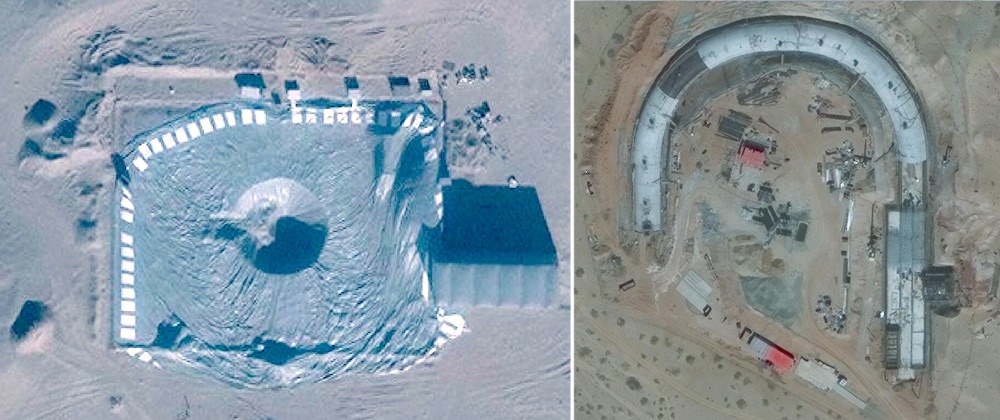
The Chinese military appears to be significantly expanding the number of ballistic missiles silos under construction in a new sprawling training area in the northern part of central China.
Recent satellite images indicate that at least 16 silos are under construction, a significant expansion in just a few years since a silo was first described in the area.
The satellite images also reveal unique tunnels potentially constructed to conceal missile launch units or loading operations.
The training area, located east of the city of Jilantai in the Inner Mongolia province, is used by the People’s Republic of China Rocket Force (PLARF) to train missile crews and fine-tune procedures for operating road-mobile missile launchers and their support vehicles.
The Jilantai PLARF Training Area
The Jilantai training area stretches for 140 kilometers (87 miles) over an area of nearly 2,090 square-kilometers (800 square miles) of desert and mountain ranges. It is a relatively new training area with most facilities added after 2013 and has since expanded to well over 140 missiles launch pads used by launch units to practice launch and loading procedures, more than two dozen campgrounds where launch units stay for a short period before moving on, five high-bay garages servicing launchers and support vehicles operating in the area, and a large supply base with adjacent support facilities (see image).
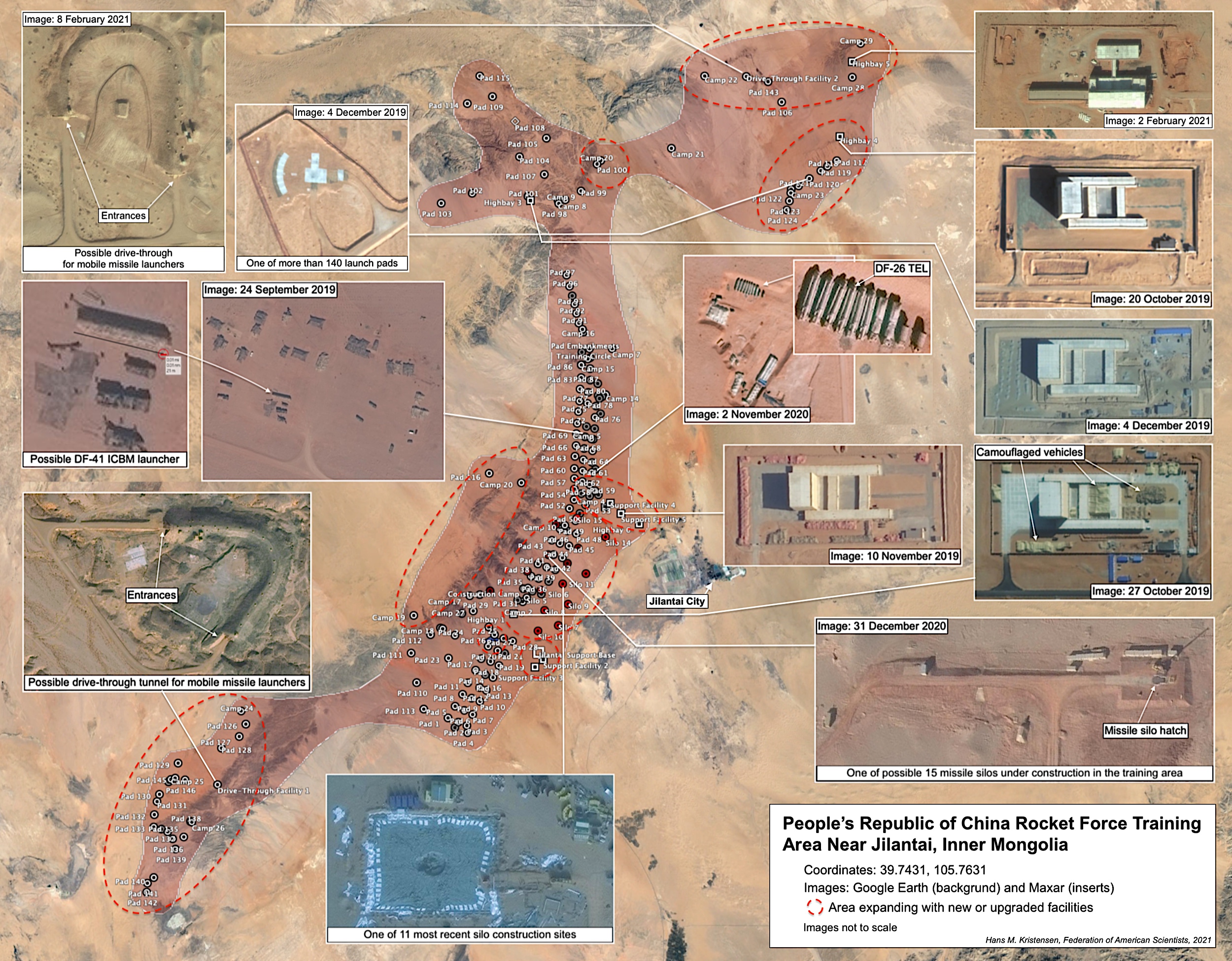
Click on image to view full size. To download an updated Google Earth placemark file with all facilities in the Jilantai training area, click here.
The training area is very active and is currently expanding in several regions, especially to the north and south as well as in the center. The expansion includes new high-bay facilities that handle launchers and missiles, a vast number of pads used by launchers and their support vehicles, missile silos, camping areas used by launch units, and underground facilities to hide and protect launchers.
Mapping the area took quite a lot of work spread out over the past two years. Unfortunately, Google Earth only has very limited and outdated image coverage of the area. Only the north-eastern sector has fairly recent images (2019). The vast majority of the imagery is still from 2013 and 2014. This is a surprise, given how much interest there is in this area. Instead, thanks to funding support from my funders listed at the bottom of this article, I used a subscription to Maxar’s Secure Watch service to get access to updated high-resolution imagery. The service is too expensive to use to search large areas and Planet Labs has a hefty price to even get access to low-resolution imagery. Fortunately, the European Sentinel Hub Playground offers free low-resolution imagery that served as a useful tool to detect new structures (the imagery is updated every five days) that could then be examined more closely with Maxar images.
Monitoring this area provides a wealth of information about how PLARF operates its mobile missiles units, the vehicles that are involved in the operations, and what structures and features to look for in the actual base deployment areas throughout China. It also provides important clues about China’s current and future nuclear modernization and helps assessing claims made by US defense officials about China’s capabilities.
Silo Construction
One of the most important new developments in the Jilantai training area is the construction of a significant number of facilities that appear to be silos intended for ballistic missiles. In the future we might see missile test launches from these silos.
Nearly all of the silos appear to be smaller than the type used for the large DF-5 ICBM in the base areas. The Department of Defense says that Jilantai “is probably being used to at least develop a concept of operations for silo basing” the DF-41.
At least 16 silos appear to be under construction (see image below). They vary in dimensions and construction has so far happened in three phases: the first silo facility started construction in 2016, four “Russia-type” silos followed in 2018-2020, and construction of an additional 11 silos began in late-2020. All of the silos are located in the center of the training area within a 10×20-kilometer (12×7-mile) area. The silos are spaced 2.2-4.4 kilometers (1.4-2.7 miles) apart, enough to ensure, presumably, that no two of them can be destroyed in a single one nuclear attack.
The first silo began construction in 2016 with what appears to include a silo and several underground facilities (39.7000, 105.4164). The outline and features are similar, but not the same, as the new silo constructed at the Wuzhai Test Launch Complex (38.888, 111.5975). It has not been confirmed that the Jilantai facility is a silo and construction was covered by a large building for several years. But equipment visible on satellite photos in 2019 appear to show semi-circle structures potentially used to build the silo walls. If so, it might be intended for a DF-5 size missile.
The second phase of silo construction began in June 2018 and now seems nearly complete. This includes four silos along the western side of the central training area. During construction, the silos were covered by a building similar to the first silo. These four silos look very similar to Russian silos with little surface infrastructure, a turn-road for trucks bringing in a missile, a 30-meter missile loading pad, and a silo lid with a diameter of about 6 meters (20 feet).
This second phase began shortly before the Pentagon’s annual report on Chinese military developments in 2018 reported that “China appears to be considering additional DF-41 launch options, including rail-mobile and silo basing.”
It was this second phase I described in an article in September 2019, a discovery that was later credited in the Defense Department’s 2020 report to Congress on Chinese military and security developments. According to the report, the size of these silos “precludes use by the DF-5 and may support concept development for a silo-based DF-41 or one of China’s smaller ICBMs,” such as the DF-31A.
The third and so far biggest silo construction phase began in late-2020 and has expanded quickly to a total of 11 silos during the first two months of 2021. Construction is still early but satellite images indicate the silos are similar in size to the four constructed in the second phase. However, the construction sites look different. Whereas the previous silos were covered by solid buildings, construction of the new silos appears to involve a climate tent or possibly an inflated bubble structure.
The silo construction at Jilantai coincides with possible construction of silos near Sundian in the Henan province.
Drive-Through Tunnels
Some of the most interesting new facilities found in the training area include two drive-through tunnels that might be intended for use by mobile launchers. The precise function is unknown, but the physical dimensions and locations suggest the tunnels may serve as field hideouts for launchers or missile reload facilities. Mobile launchers are highly vulnerable when operating in the open.
The two tunnels discovered so far are located at each end of the training area that are under expansion with new facilities and additional launch pads (see image below).
The tunnels are approximately 350 meters (1,148 feet) long and could hypothetically hold a dozen DF-41 launchers. More likely it would hold a smaller number plus their support vehicles. The entrances are about six meters wide and tall, more than sufficient for a large launcher.
Each tunnel has two entrances, and one end has a 75-meter section that is wider than the rest of the tunnel (20 meters vs. 13 meters). The wide section could potentially serve as a missile reload area or personnel quarters. Adjacent to the wide section is a square building with three taller structures that might be for surface access or house a climate control system.
These types of tunnels might also potentially be under construction in the operational brigade base area, although I haven’t fund any yet.
Summary and Implications
The PLARF training near Jilantai provides a unique window into China’s nuclear posture. China currently operates 18-20 silos, a number that could nearly double with the construction of the silos in the Jilantai training area. Whereas as the existing silos are large to accommodate the old liquid-fueled DF-5 ICBM, all but one of the new silos at Jilantai are smaller and appear designed to accommodate the newer and slimmer solid-fuel ICBMs, such as the DF-41 (and potentially DF-31A).
The construction of so many silos (16 have been found so far) in a training area is curious (there are only two training silos at the Wuzhai Test Launch Complex). One would imagine that a couple of silos would provide sufficient training. One potential explanation might be that China is experimenting with several different types of silos designs to determine which type(s) eventually will be constructed in the various brigade base areas. The Pentagon asserted in 2020 that Jilantai “is probably being used to at least develop a concept of operations for silo basing” the DF-41. To that end, the silos could potentially even achieve some actual operational capability.
It should be pointed out that even if China doubles or triples the number of ICBM silos, it would only constitute a fraction of the number of ICBM silos operated by the United States and Russia. The US Air Force has 450 silos, of which 400 are loaded. Russia has about 130 operational silos. In comparison, the 16 new silos under construction at Jilantai correspond to less than one-third of a single squadrons in a single US ICBM wing.
Yet for China, given its nuclear policy of “minimum deterrence,” the construction of a relatively large number of silos at Jilantai is important. Once the operational concept is developed, one could potentially see construction of a couple of new silo clusters at a couple of brigade bases elsewhere in China. Since the construction so far is not about achieving parity with the United States (or even near-parity), why is China doing this and what is driving the development? There are several potential explanations (or possibly a combination of them; listed in no particular order):
Increased protection of retaliatory capability: China is concerned that its current ICBM silos are too vulnerable to US (or Russian) attack. By increasing the number of silos, more ICBMs could potentially survive a preemptive strike and be able to launch their missiles in retaliation. China’s development of its current road-mobile solid-fuel ICBM force was, according to the US Central Intelligence Agency, fueled by the US Navy’s deployment of Trident II D5 missiles in the Pacific. This action-reaction dynamic is most likely a factor in China’s current modernization.
Overcoming potential effects of US missile defenses: Concerns that missile defenses might undermine China’s retaliatory capability have always been prominent. China has already decided to equip its DF-5B ICBM with multiple warheads (MIRV); each missile can carry up to five. The new DF-41 ICBM is also capable of MIRV and the future JL-3 SLBM will also be capable of carrying multiple warheads. By increasing the number of silos-based solid-fuel missiles and the number of warheads they carry, China would seek to ensure that they can continue to penetrate missile defense systems.
Transition to solid-fuel silo missiles: China’s old liquid-fuel DF-5 ICBMs take too long to fuel before they can launch, making them more vulnerable to attack. Handling liquid fuel is also cumbersome and dangerous. By transitioning to solid-fuel missile silos, survivability, operational procedures, and safety of the ICBM force would be improved.
Transitioning to a peacetime missile alert posture: China’s missiles are thought to be deployed without nuclear warheads installed under normal circumstances. US and Russian ICBMs are deployed fully ready and capable of launching on short notice. Because military competition with the United States is increasing, China can no longer be certain it would have time to arm the missiles that will need to be on alert to improve the credibility of China deterrent. The Pentagon in 2020 asserted that the silos at Jilantai “provide further evidence China is moving to a LOW posture.”
Balancing the ICBM force: Eighty percent of China’s ICBMs are mobile and increasing in numbers. Since China is increasing its overall ICBM force, the silo-based portion also has to be increased to serve a credible role.
Increasing China’s nuclear strike capability: China’s “minimum deterrence” posture has historically kept nuclear launchers at a relatively low level. But the Chinese leadership might have decided that it needs more missiles with more warheads to hold more adversarial facilities at risk. The United States, India, and Russia are all modernizing their nuclear arsenal and improving or increasing their weapons.
Improving quick-strike conventional capability: Although the silos at Jilantai are thought to be intended for nuclear missiles, one option could potentially also be (I am not suggesting it is) to begin to deploy conventional ballistic missiles in silos. Doing so would provide a very quick strike capability, not at strategic range but for targets at medium- or intermediate-range.
National prestige: China is getting richer and more powerful. Big powers have more missiles, so China needs to have more missiles too to underpin its status as a great power.
The construction of more than a dozen silos for modern solid-fuel missiles at Jilantai indicates that China may be seeking to increase reliance on silo-based missiles in its nuclear posture. Whether that is the result of the overall increase of its arsenal, a sense of increased vulnerability, or a different thinking about the role that quick-strike ICBMs will serve in the future remains to be seen. But it is a clear reminder about the dynamic of deterrence that continues to fuel nuclear modernization, and the Jilantai training area provides a unique window into China’s efforts.
Background information:
• Chinese nuclear forces, 2020
• China’s New DF-26 Missile Shows Up At Base In Eastern China
• New Missile Silo And DF-41 Launchers Seen In Chinese Nuclear Missile Training Area
• Chinese DF-26 Missile Launchers Deploy To New Missile Training Area
This publication was made possible by generous support from the John D. and Catherine T. MacArthur Foundation, the New Land Foundation, the Ploughshares Fund, and the Prospect Hill Foundation. The statements made and views expressed are solely the responsibility of the author.
New NASIC Report Appears Watered Down And Out Of Date
The US Air Force National Air and Space Intelligence Center (NASIC) has published a new version of its widely referenced Ballistic and Cruise Missile Threat report.
The agency normally puts out an updated version of the report every four years. The previous version dates from 2017.
The 2021 report (dated 2020) provides information on developments in many countries but is clearly focused on China, Iran, North Korea, and Russia. Especially the North Korean data is updated because of the significant developments since 2017.
The most interesting new information in the updated report is probably that the new Chinese JL-3 sea-launched ballistic missile (SLBM) is capable of carrying multiple warheads.
Overall, however, the new report may be equally interesting because of what it does not include. There are a number of cases where the report is scaled back compared with previous versions. And throughout the report, much of the data clearly hasn’t been updated since 2018. In some places it is even inconsistent and self-contradicting.
The most significant data reduction is in the cruise missile section where the report no longer lists countries other than Russia, China, and Iran. This is a significant change from previous reports that listed a wide range of other countries, including India and Pakistan and many others that have important cruise missile programs in development. The omission is curious because the report in all ballistic missile categories includes other countries.
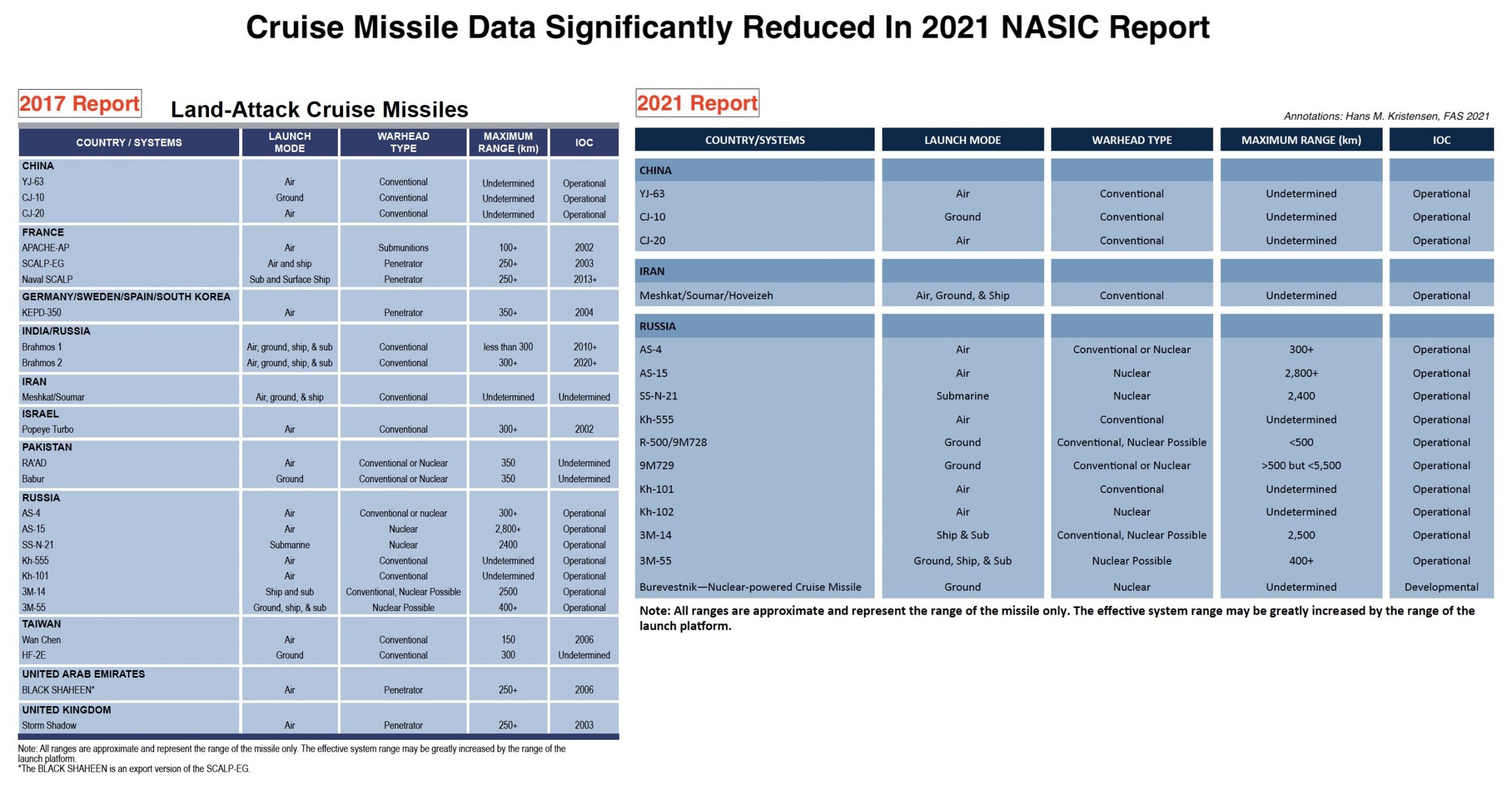
Cruise missile data is significantly reduced in the new NASIC report compared with the previous version from 2017. Click on image to view full size.
Other examples of reduced data include the overview of ballistic missile launches, which for some reason does not show data for 2019 and 2020. Nor is it clear from the table which countries are included.
Also, in some descriptions of missile program developments the report appears to be out of date and not update on recent developments. This includes the Russian SS-X-28 (RS-26 Rubezh) shorter-range ICBM, which the report portrays as an active program but only presents data for 2018. Likewise, the report does not mention the two additional boats being added to the Chinese SSBN fleet. Moreover, the new section with air-launched ballistic missiles only includes Russia but leaves out Chinese developments and only appears to include data up through early 2018.
Whether these omissions reflect changes in classification rules, chaos is the Intelligence Community under the Trump administration, or simply oversight is unknown.
Below follows highlights of some of the main nuclear issues in the new report.
Russian Nuclear Forces
Information about Russian ballistic and cruise missile programs dominate the report, but less so than in previous versions. NASIC says Russia currently has approximately 1,400 nuclear warheads deployed on ICBMs and SLBMs, a reduction from the “over 1,500” reported in 2017. The new number is well known from the release of New START data and is very close to the 1,420 warheads we estimated in our Russian Nuclear Notebook last year.
NASIC repeats the projection from 2017, that “the number of missiles in the Russian ICBM force will continue to decrease because of arms control agreements, aging missiles, and resource constraints….”
The statement that “Russia retains over 1,000 nuclear warheads on ICBMs” is curious, however, because would imply the SLBM force is loaded with fewer warheads than normally assumed. The warhead loading attributed to the SS-N-32 (Bulava) is 6, the number declared by Russia under the START treaty, and less than the 10 warheads that is often claimed by unofficial sources.
The new version describes continued development of the SS-28 (RS-26 (Rubezh) shorter-range ICBM suspected by some to actually be an IRBM. But the report only lists development activities up through 2018 and nothing since. The system is widely thought to have been mothballed due to budget constraints.
The cruise missile section attributes nuclear capability – or possible nuclear capability – to most of the Russian missiles listed. Six systems are positively identified as nuclear, including the Kh-102, which was not listed in the 2017 report. Two of the nuclear systems are dual-capable, including the 9M729 (SSC-8) missile the US said violated the now-abandoned INF treaty, while 3 missiles are listed as “Conventional, Nuclear Possible.” That includes the 9M728 (R-500) cruise missile (SSC-7) launched by the Iskander system, the 3M-14 (Kalibr) cruise missile (SS-N-30), and the 3M-55 (Yakhont, P-800) cruise missile (SS-N-26).
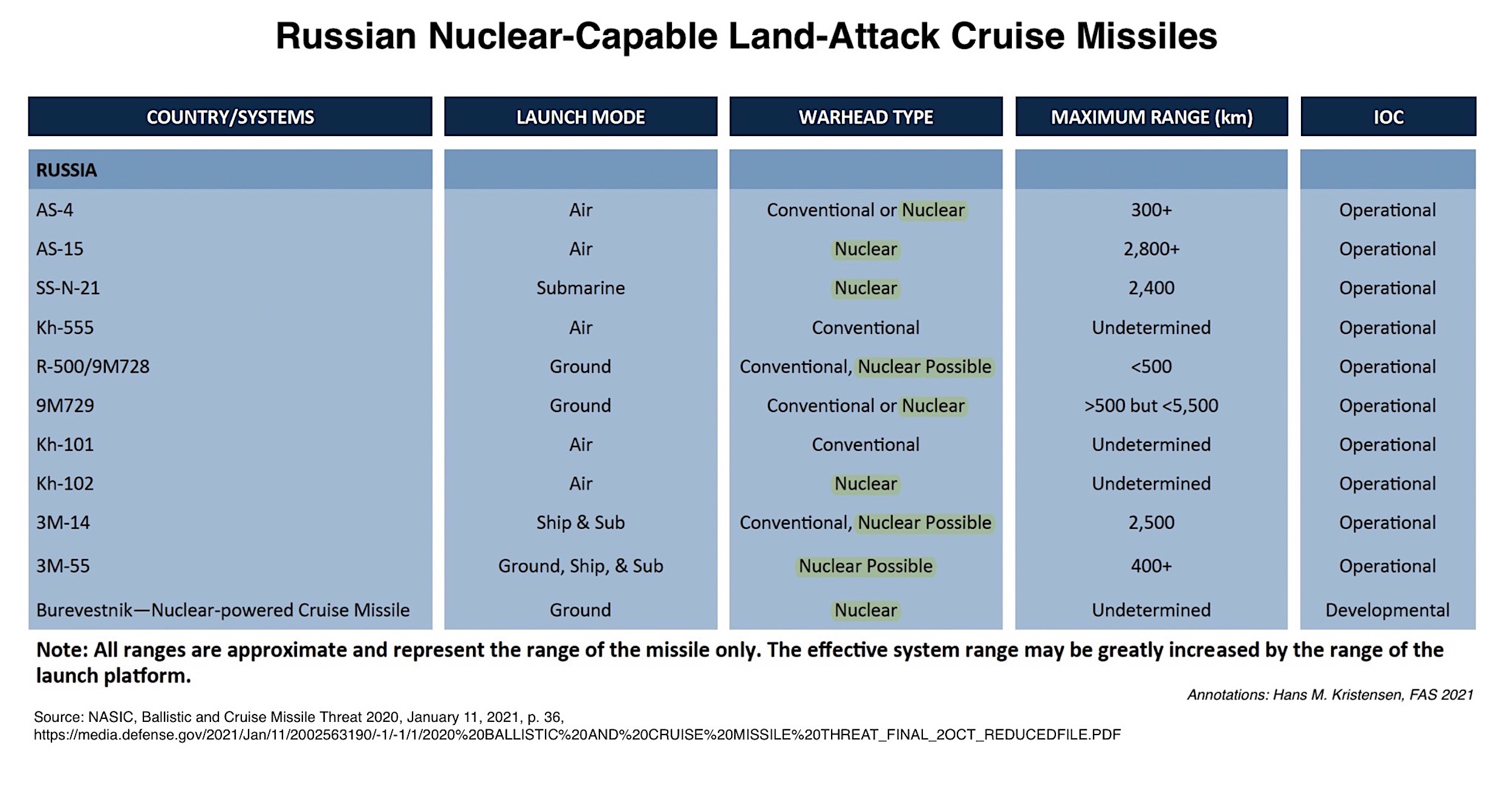
NASIC attributes nuclear capability to nine Russian land-attack cruise missiles, three of them “possible.” Click on image to view full size.
The designation of “nuclear possible” for the SS-N-30 (3M-14, often called the Kalibr even though Kalibr is strictly speaking the name of the launcher system) is curious because the Russian government has clearly stated that the missile is nuclear-capable.
Chinese Nuclear Forces
The biggest news in the China section of the NASIC report is that the new JL-3 SLBM that will arm the next-generation Type 096 SSBN will be capable of delivering “multiple” warheads and have a range of more than 10,000 kilometers. That is a significant increase in capability compared with the JL-2 SLBM currently deployed on the Jin-class SSBNs and is likely part of the reason for the projection that China’s nuclear stockpile might double over the next decade.

NASIC reports that China’s next-generation JL-3 SLBM will be capable of carrying “multiple” warheads. Click on image to view full size.
Despite this increased range, however, a Type 096 operating from the current SSBN base in the South China Sea would not be able to strike targets in the continental United States. To be able to reach targets in the continental United States, an SSBN would have to launch its missile from the Bohai Sea. That would bring almost one-third of the continental United States within range. To target Washington, DC, however, a Type 096 SSBN would still have to deploy deep into the Pacific.
The new DF-41 (CSS-20) has lost its “-X-“ designation (CSS-X-20), which indicates that NASIC considers the missile has finished development is now being deployed. A total of 16+ launchers are listed, probably based on the number attending the 2019 parade in Beijing and the number seen operating in the Jilantai training area.
The number of DF-31A and DF-31AG launchers is very low, 15+ and 16+ respectively, which is strange given the number of bases observed with the launchers. Of course, “+” can mean anything and we estimate the number of launchers is probably twice that number. Also interesting is that the DF-31AG is listed as “UNK” (unknown) for warheads per missile. The DF-31A is listed with one warhead, which suggests that the AG version potentially could have a different payload. Nowhere else is the AG payload listed as different or even multiple warheads.
The NASIC report projection for the increase in Chinese nuclear ICBM warheads that can reach the United States is inconsistent and self-contradicting. In one section (p. 3) the report predicts “the number of Chinese ICBM nuclear warheads capable of reaching the United States potentially expanding to well over 200 within the next 5 years.” But in another section (p. 27), the report states that the “number of warheads on Chinese ICBMs capable of threatening the United States is expected to grow to well over 100 in the next 5 years.” The projection of “well over 100” was also listed in the 2017 report, and the “well over 200” projection matches the projection made in the DOD annual report on Chinese military developments. So the authors of the NASIC might simply have forgotten to update the text.
On Chinese shorter-range ballistic missiles, the NASIC report only mentions DF-21A (CSS-5 Mod 2) as nuclear, but not the CSS-5 Mod 6 version. The Mod 6 version (potentially called DF-21E) was first mentioned in the 2016 DOD report on Chinese military developments and has been included since.
Newer missiles finally get designations: The dual-capable DF-26 is called the CSS-18, and the conventional (possibly) DF-17 is called the CSS-22. NASIC continues to list the DF-26 range as less (3,000+ km) than the annual DOD China report (4,000 km).
An in case anyone was tempted, no, none of China’s cruise missiles are listed as nuclear-capable.
Pakistani Nuclear Forces
The report provides no new information about Pakistani nuclear-capable ballistic missiles. As with several other sections in the report, the information does not appear to have been updated much beyond 2018, if at all. As such, status information should be read with caution.
The Shaheen-III MRBM is still not deployed, nor is the Ababeel MRBM that NASIC describes as a “MIRV version.” It has only been flight-tested once.
The tactical nuclear-capable NASR is listed with a range of 60 km, the same as in 2017, even though the Pakistani government has since claimed the range has been extended to 70 km.
Because the new NASIC report no longer includes data on Pakistan’s cruise missiles, neither the Babur nor the RAAD programs are described. Nor is any information provided about the efforts by the Pakistani navy to develop a submarine-launched nuclear-capable cruise missile.
Indian Nuclear Forces
Similar to other sections of the report, the data on Indian programs are tainted by the fact that some information does not appear to have been updated since 2018, and that the cruise missile section does not include India at all.
According to the report, Agni II and Agni III MRBMs are still deployed in very low numbers, fewer than 10 launchers, the same number reported in 2017. That number implies only a single brigade of each missile. But, again, it is not clear this information has actually been updated.
Nor are the Agni IV or the Agni V listed as deployed yet.
North Korean Forces
The North Korean sections are main interesting because of the inclusion of data on several systems test-launched since the previous report in 2017. This contrasts several other data set in the report, which do not appear to have been updated past 2018. But since the North Korean long-range tests occurred in 2017, this may explain why they are included.
NASIC provides official (unclassified) range estimates for these missiles:
The Hwasong-12 IRBM range has been increased from 3,000+ km in 2017 to 4,500+ km in the new report.
On the ICBMs, the Taepo Dong 2 no longer has a range estimate. The Hwasong-13 and Hwasong-14 range estimates have been raised from the generic 5,500+ km in the 2017 report to 12,000 km and 10,000+ km, respectively, in the new report, and the new Hwasong-15 has been added with a range estimate of 12,000+ km. The warhead loading estimates for the Hwasong-14 and Hwasong-15 are “unknown” and none of the ICBMs are listed as deployed.
On submarine-launched missiles, the NASIC report lists two: the Puguksong-1 and Pukguksong-3. Both have range estimates of 1,000+ km and the warhead estimate for the Pukguksong-3 is unknown (“UNK”). Neither is deployed. The new Pukguksong-4 paraded in October 2020 is not listed, not is the newest Pukguksong-5 displayed in early 2021 mentioned.
Additional background information:
• Russian nuclear forces, 2020
(The Other) Red Storm Rising: INDO-PACOM China Military Projection
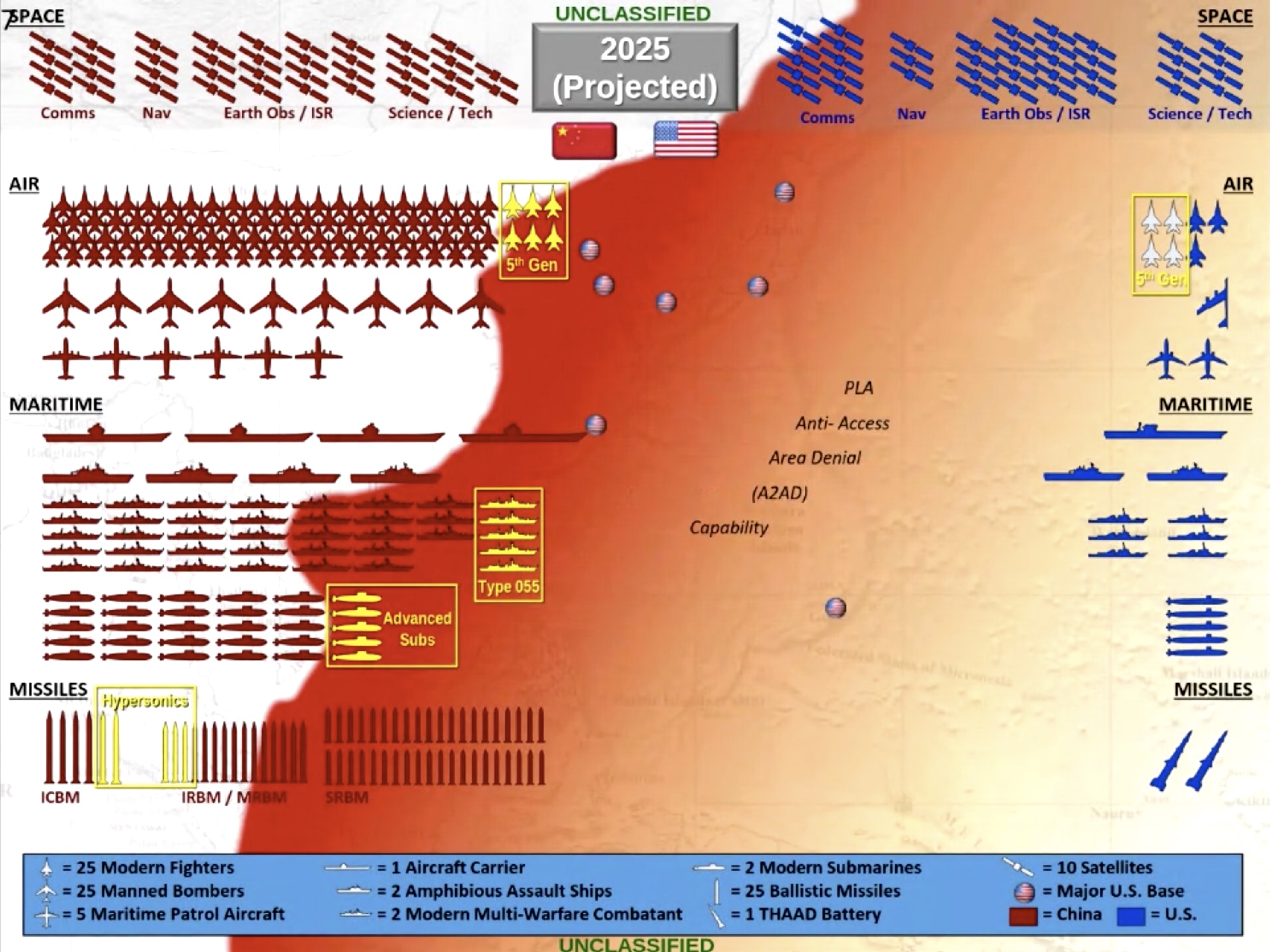
Click on image to download PDF-version of full briefing
Some Missile Numbers Do Not Match Recent DOD China Report
U.S. Indo-Pacific Command recently gave a briefing about the challenges the command sees in the region. The briefing says China is the “Greatest Threat to Global Order and Stability” and presents a set of maps that portray a massive Chinese military buildup and very little U.S. capability (and no Allied capability at all) to counter it. With its weapons icons and a red haze spreading across much of the Pacific, the maps resemble a new version of the Cold War classic Red Storm Rising.
Unfortunately, the maps are highly misleading. They show all of China’s forces but only a fraction of U.S. forces operating or assigned missions in the Pacific.
There is no denying China is in the middle of a very significant military modernization that is increasing its forces and their capabilities. This is and will continue to challenge the military and political climate in the region. For decades, the United States enjoyed an almost unopposed – certainly unmatched – military superiority in the region and was able to project that capability against China as it saw fit. The Chinese leadership appears to have concluded that that is no longer acceptable and that the country needs to be able to defend itself.
In describing this development, however, the INDO-PACOM briefing slides make the usual mistake of overselling the threat and under-characterizing the defenses. Moreover, some of the Chinese missile forces listed in the briefing differ significantly from those listed in the recent DOD report on Chinese military developments. As military competition and defense posturing intensify, expect to see more of these maps in the future.
Apples, Oranges, and Cherry-Picking
The INDO-PACOM maps suffer from the same lopsided comparison and cherry-picking that handicapped the 2018 Nuclear Posture Review: it overplays the Chinese capabilities and downplays the U.S. capabilities (see image below). While he briefing maps includes all of China’s military forces, whether they are postured toward India or Russia, it only shows a small portion of U.S. forces. INDO-PACOM mapmakers may argue that it’s only intended to show the force level in the Western Pacific theater, but INDO-PACOM spans all of the Pacific and the maps ignore other significant U.S. forces that are operating in the region to oppose China.
The INDO-PACOM map gives the impression that the United States only has 175 fighter-jets, 12 bombers, 50 maritime patrol aircraft, 1 aircraft carrier, four amphibious assault ships, 12 modern multi-warfare warships, 10 submarines, and 2 THAAD missile defense batteries in the region to deter China. In reality, the U.S. military forces based or assigned missions in the INDO-PACOM area of responsibility are significantly greater. The map excludes everything based in Hawaii, in Alaska, on the U.S. west coast, and elsewhere in the continental United States with missions in the Pacific or forces rotating through bases in the Indo-Pacific region. Examples of mischaracterizations of U.S. forces include:
Fighter aircraft: The map lists only lists 175 fighter-jets, but Pacific Air Forces says it has “Approximately 320 fighter and attack aircraft are assigned to the command with approximately 100 additional deployed aircraft rotating on Guam.”
Bombers: The map lists only 12 bombers, but the United States has more than 150 bombers, many of which would be used to counter Chinese forces in a war. Moreover, those bombers are considerably more capable than Chinese bombers and are supported by tankers to provide unconstrained range in the Pacific, something Chinese bombers cannot do.
Submarines: The map lists only 10 U.S. submarines, but according to the U.S. Naval Vessel Register the U.S. Navy has more than three times that many (35) in the Pacific, including 25 attack submarines, 2 guide missile submarines, and 8 ballistic missile submarines (SSBNs) homeported in Pacific ports. The omission of the 8 Pacific-based SSBNs is particularly problematic given their important role of targeting China – and that they are assigned up to eight times more nuclear warheads than China has in its entire nuclear weapons stockpile.
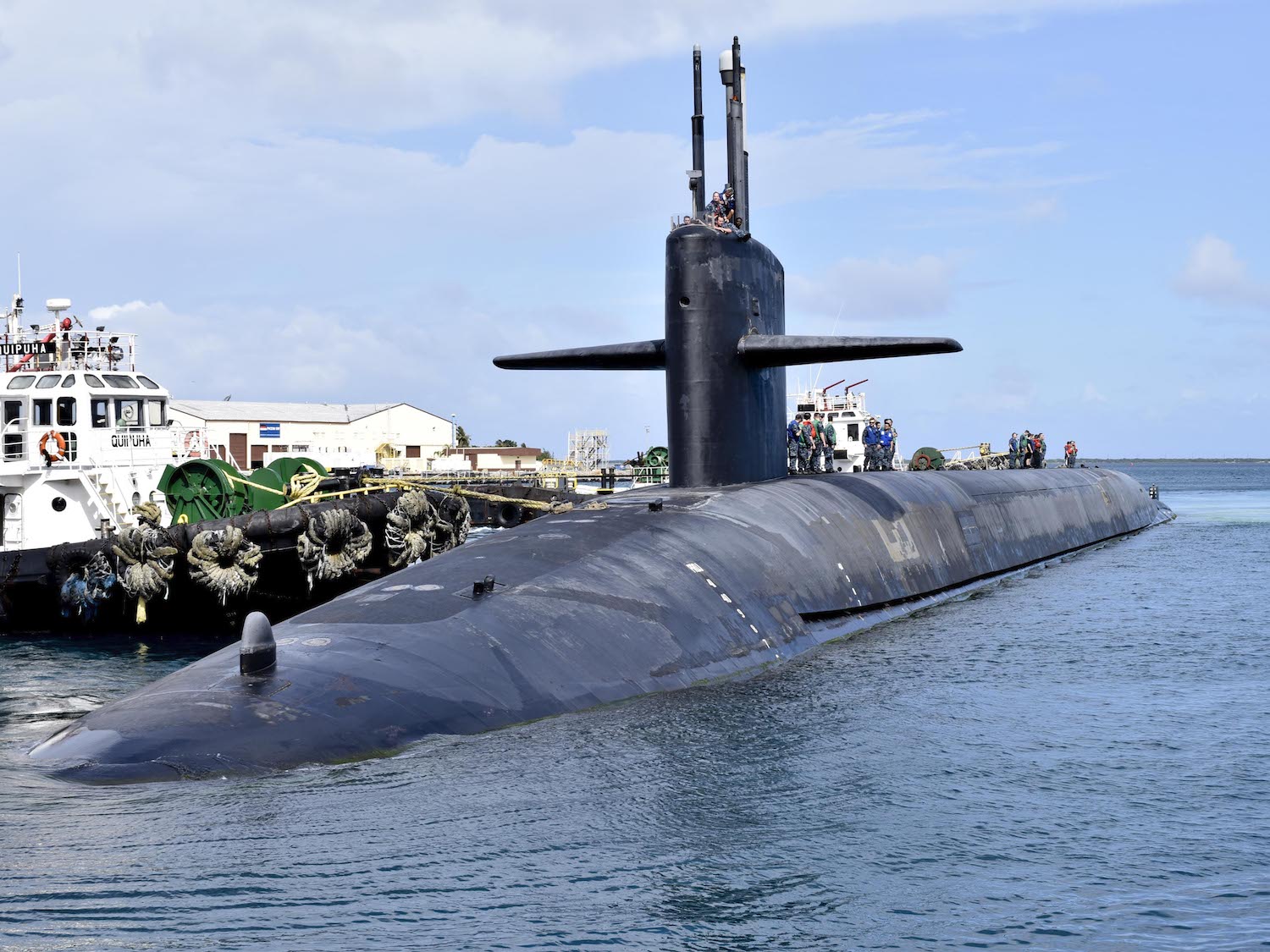
The INDO-PACOM briefing does not show that the United States has any ballistic missile submarines in the Pacific, even though eight U.S. Pacific-based SSBNs play a central role in targeting China. Just two of these Ohio-class SSBNs can carry more warheads than China has in its entire nuclear stockpile. This image shows the USS Pennsylvania (SSBN-735) during a port visit to Guam in 2016.
Aircraft carriers: The map lists only one U.S. aircraft carrier, but according to the U.S. Naval Vessel Register the U.S. Navy has six aircraft carriers based in the Pacific (two of them in shipyard). Moreover, unlike China’s single aircraft carrier (a second is fitting out), U.S. carriers are large flat-tops with more aircraft.
Amphibious assault ships: The map shows four U.S. amphibious assault ships, but the U.S. Pacific Fleet says it operates six (although one was recently damaged by fire). Moreover, the amphibious assault ships are being upgraded to carry the F-35B VSTOL aircraft, significantly improving their strike capability.
Missile defense: The map shows only two THAAD batteries but does not mention the Ground Based Midcourse missile defense system in Alaska. Nor are missile defense interceptors deployed on cruisers and destroyers listed.
ICBMs: One of the most glaring omissions is that the maps do not show the United States has any ICBMs (the map also does not list U.S. SLBMs but nor does it list Chinese SLBMs). Although U.S. ICBMs are thought to be mainly assigned to targeting Russia and would have to overfly Russia to reach targets in China, that does not rule out they could be used to target China (Chinese ICBMs would also have to overfly Russia to target the continental United States). U.S. ICBMs carry more nuclear warheads than China has in its entire nuclear stockpile.
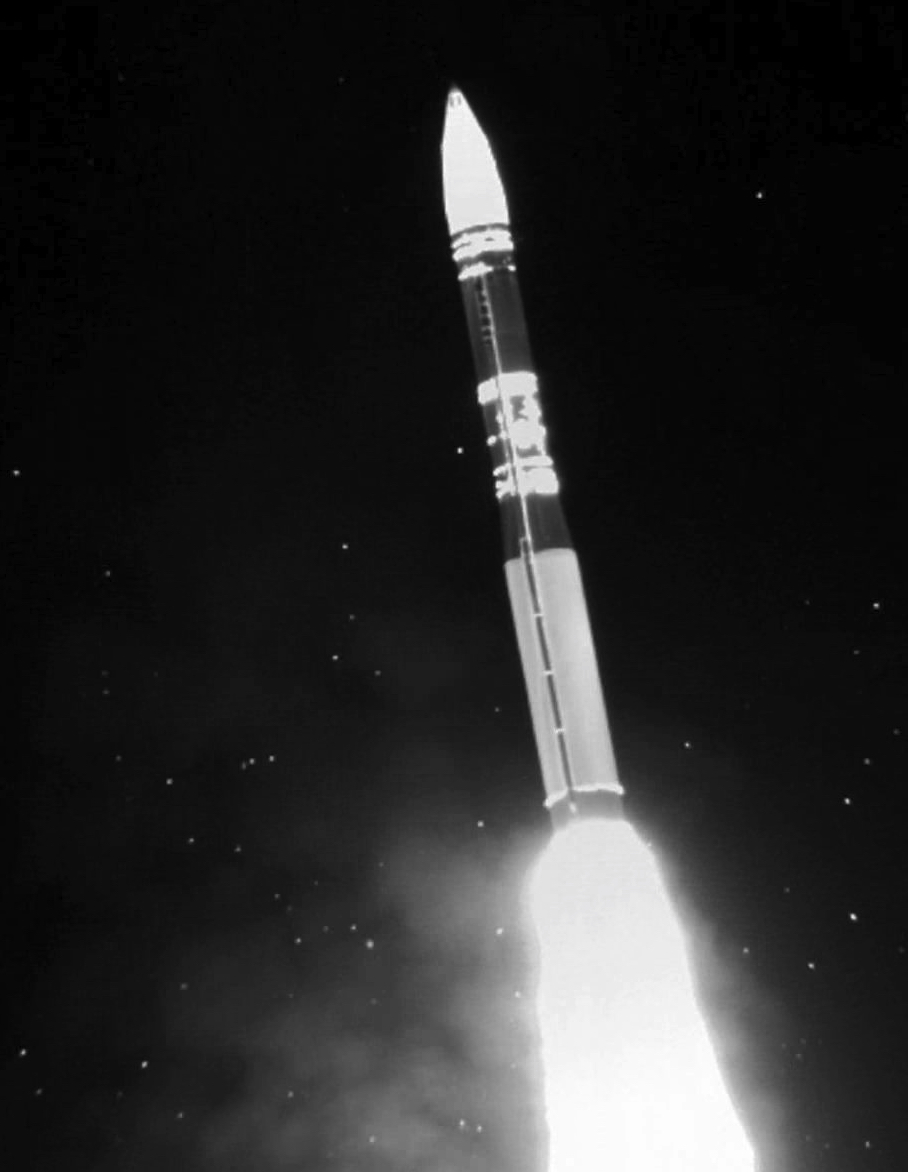
The INDO-PACOM briefing shows China with 100 ICBMs and the United States with none. This infrared image shows a U.S. Minuteman III ICBM test-launched from Vandenberg AFB into the Pacific on September 2, 2020.
A modified map, apparently made available by U.S. Pacific Air Forces, is a little better because it includes Australian, Japanese, and South Korean forces. But it still significantly mischaracterizes the forces the United States has in the Pacific or are assigned missions in the region. Moreover, the new map does not include the yellow highlights showing “hypersonics” missiles and portion of aircraft, ships, and submarines that are modern (see modified map below).
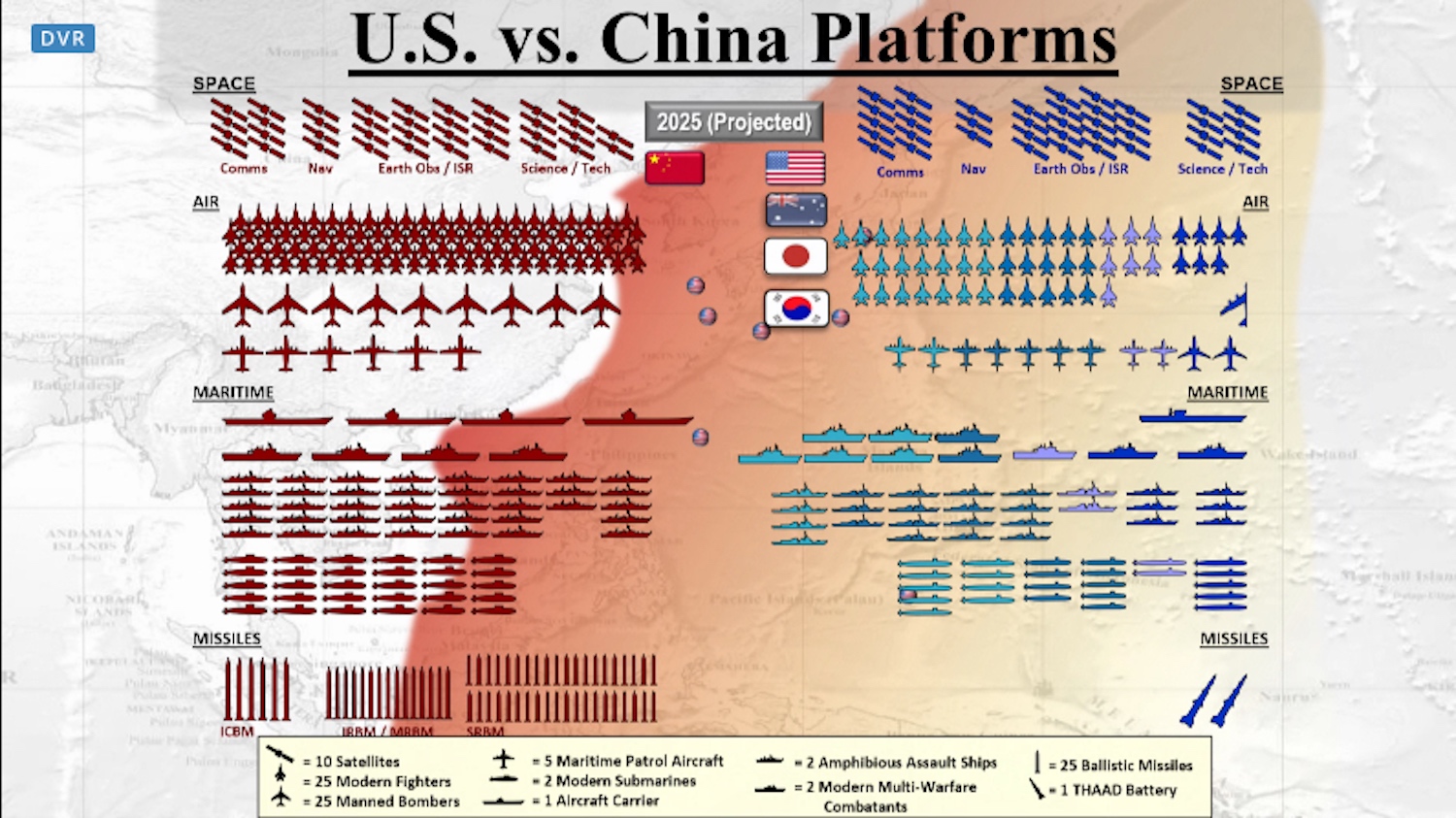
A modified map released after the INDO-PACOM briefing also shows Australian, Japanese, and South Korean forces – but still mischaracterizes U.S. military forces in the Pacific.
Inconsistent Missile Numbers
The INDO-PACOM maps are also interesting because the numbers for Chinese IRBMs and MRBMs are different than those presented in the 2020 DOD report on Chinese military developments. INDO-PACOM lists 250 IRBMs/MRBMs, more than 100 missiles fewer than the DOD estimate. China has fielded one IRBM (DF-26), a dual-capable missile that exists in two versions: one for land-attack (most DF-26s are of this version) and one for anti-ship attack. China operates four versions of the DF-21 MRBM: the nuclear DF-21A and DF-21E, the conventional land-attack DF-21C, and the conventional anti-ship DF-21D.
There is also a difference in the number of SRBMs, which INDO-PACOM sets at 1,000, while the DOD report lists 600+. The 600+ could hypothetically be 1,000, but the INDO-PACOM number shows that the high-end of the 750-1,500 range reported by the 2019 DOD China report probably was too high.
A comparison (see table below) is complicated by the fact that the two reports appear to use slightly different terminology, some of which seems inconsistent. For example, INDO-PACOM lists “missiles” but the low IRBM/MRBM estimate suggests it refers to launchers. However, the high number of SRBMs listed suggest it refers to missiles.
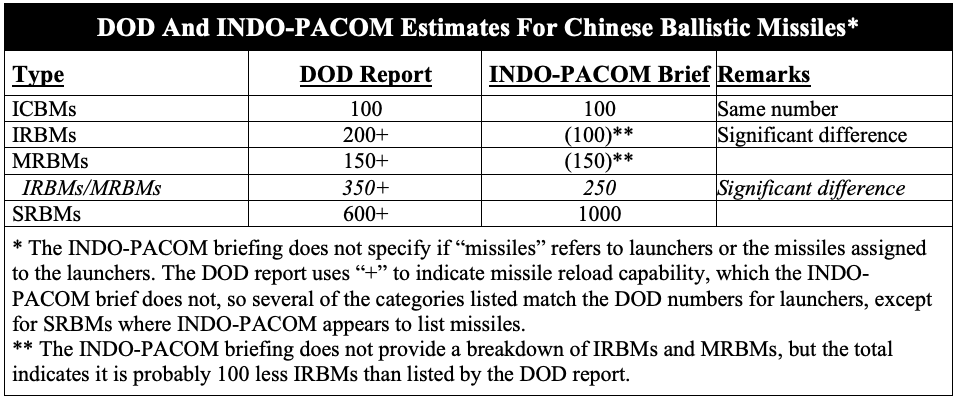
Several of the Chinese missile estimates provided by INDO-PACOM and DOD are inconsistent.
2025 Projection
The projection made by INDO-PACOM for 2025 shows significant additional increases of Chinese forces, except in the number of SRBMs.
The ICBM force is expected to increase to 150 missiles from 100 today. That projection implies China will field an average of 10 new ICBMs each year for the next five years, or about twice the rate China has been fielding new ICBMs over the past two decades. Fifty ICBMs corresponds to about four new brigades. About 20 of the 50 new ICBMs are probably the DF-41s that have already been displayed in PLARF training areas, military parades, and factories. The remaining 30 ICBMs would have to include more DF-41s, DF-31AGs, and/or the rumored DF-5C, but it seems unlikely that China can add enough new ICBM brigade bases and silos in just five years to meet that projection.
The briefing also projects that 50 of the 150 ICBMs by 2025 will be equipped with “hypersonics.” The reference to “hypersonics” as something new is misleading because existing ICBMs already carry warheads that achieve hypersonic speed during reentry. Instead, the term “hypersonics” probably refers to a new hypersonic glide vehicle. It is unclear from the briefing if INDO-PACOM anticipates the new payload will be nuclear or conventional, but a conventional ICBM payload obviously would be a significant development with serious implications for crisis stability. Even if this expansion comes true, the entire Chinese ICBM force would only be one-third of the size of the U.S. ICBM force. Nonetheless, a Chinese ICBM force of 100-150 is still a considerable increase compared with the 40 or so ICBMs it operated two decades ago (see graph below).

The INDO-PACOM briefing appears to show a greater increase in ICBMs projected for the next five years than DOD reported in the past decade.
The IRBM/MRBM force is projected to increase to 375, from 250 today. That projection assumes China will field 125 additional missiles over five years, or 25 missiles each year. That corresponds to a couple of new brigades per year, which seems high. Yet production is significant and IRBM launchers have been seen in several regions in recent years. The IRBM/MRBM force presumably would include the DF-17, DF-21, and the DF-26.
About 75-87 of the IRBM/MRBM force will be equipped with “hypersonics” by 2025, according to INDO-PACOM. That projection probably refers to the expected fielding of the DF-17 with a new glide-vehicle payload, although that would imply a lot of the new launcher (enough for 4-6 brigades). Another possibly is that a portion of other IRBMs/MRBMs (perhaps the DF-26) might also be equipped with the new payload or have their own version. China has presented the DF-17 as conventional but STRATCOM has characterized it as a “new strategic nuclear system.” Adding new hypersonics to IRBMs/MRBMs that are already mixing nuclear and conventional seems extraordinarily risky and likely to further exacerbate the danger of misunderstandings.
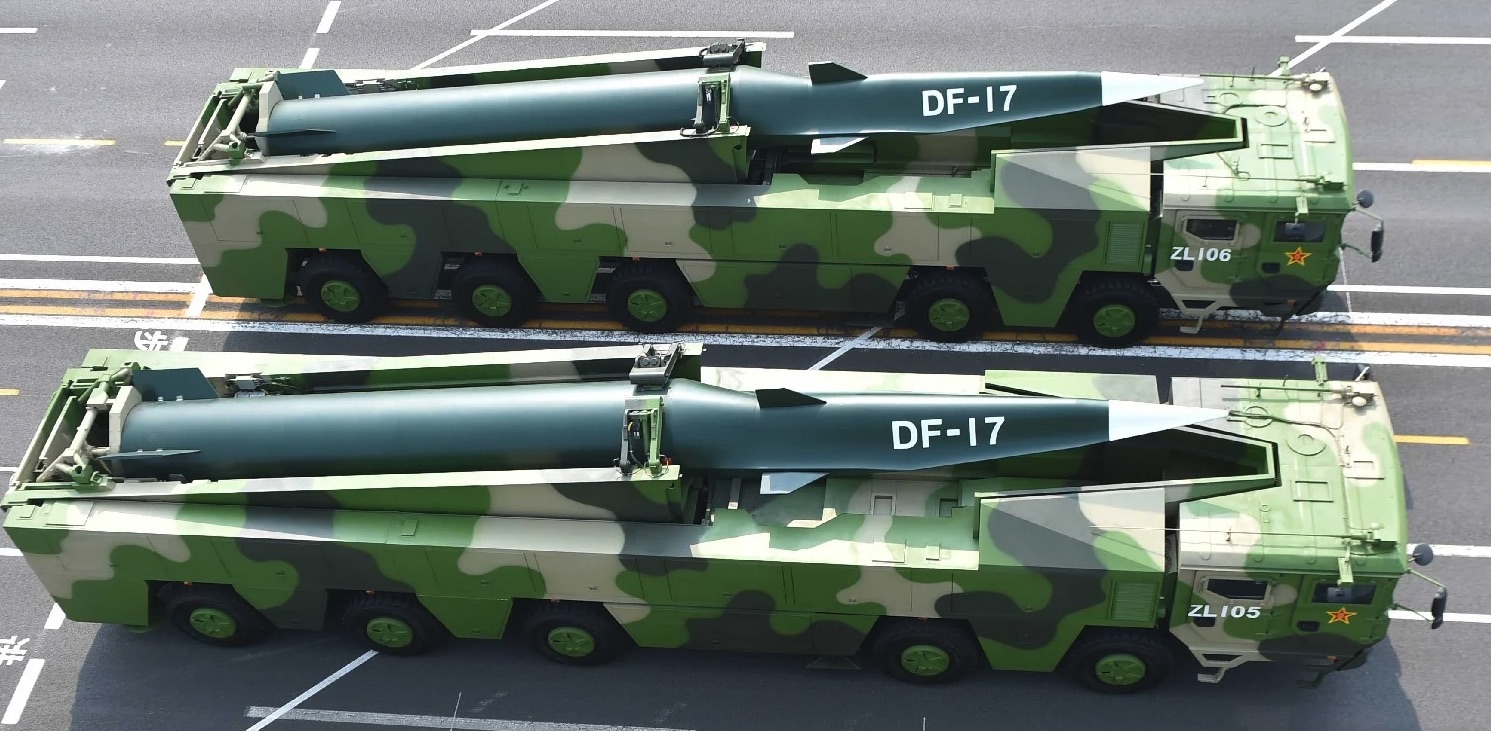
The INDO-PACOM does not list any DF-17s but projects that 75-87 of China’s IRBMs/MRBMs by 2025 will carry some form of hypersonic payload that is different from what they carry today.
The status and projection for the surface fleet are also interesting. The INDO-PACOM briefing lists the total number of aircraft carriers, amphibious assault ships, and modern multi-warfare combatant vessels at 54, of which 46 are modern multi-warfare combatant vessels. The briefing doesn’t specify what is excluded from this count, but it differs significantly from the count in the DOD China report.
One of the puzzling parts of the INDO-PACOM briefing is the projection that China by 2025 will be operating four aircraft carriers for fixed-wing jets. China is currently operating one carrier with a second undergoing sea-trials. How China would be able to add another three carriers in five years is a mystery, not least because the third and fourth hulls are of a new and more complex design. The projection also doesn’t fit with the U.S. Office of Naval Intelligence, which predicts the third carrier won’t be commissioned until 2024.
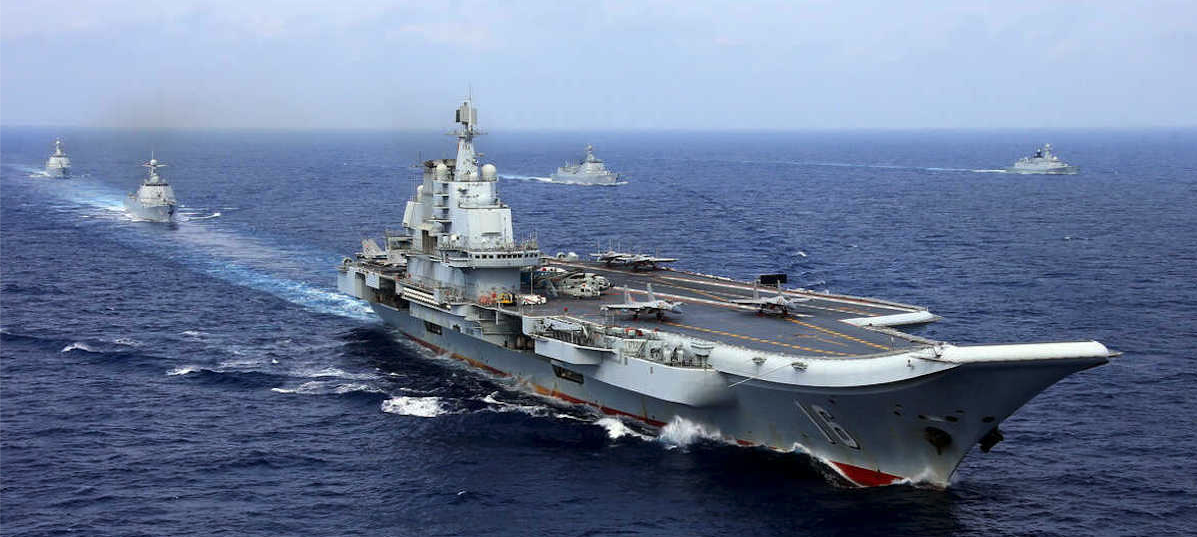
The INDO-PACOM briefing says China will operate four aircraft carriers by 2025 but ONI estimates the third won’t be commissioned until 2024.
Bombers are projected to increase from 175 today to 225 in 2025, an increase of nearly 30 percent. Since 2025 is probably too early for the new H-20 to become operational, the increase appears to only involve modern version of the H-6 bomber. Although the bomber force has recently been reassigned a nuclear mission, the majority of the Chinese bomber force will likely continue to be earmarked for conventional missions.
Submarines and surface vessels will also increase and some of them are being equipped with long-range missiles. Combined with the growing reach of ground-based ballistic missiles and air-delivered cruise missiles, this results in the INDO-PACOM maps showing a Chinese “anti-access area denial” (A2AD) capability bleeding across half of the Pacific well beyond Guam toward Hawaii. But A2AD is not a bubble and weakens significantly in areas further from Chinese shores.
Conclusion and Recommendations
The INDO-PACOM maps project China’s military modernization will continue at a significant pace over the next five years with increases in delivery platforms and capabilities. This will reduce the military advantage the United States has enjoyed over China for decades and further stimulate modernization of U.S. and allied military forces in the region. As forces grow, operations increase, and rhetoric sharpens, insecurity and potential incidents will increase as well and demand new ways of reducing tension and risks.
The Trump administration is correct that China should be included in talks about limiting forces and reducing tension. So far, however, the administration has not presented concrete ideas for what that could look like. Like the United States, China will not accept limits on its forces and operations without something in return that Beijing sees as being in its national interest. Although China is modernizing its nuclear forces and appears intent on increasing it further over the next decade, the force will remain well below the level of the United States and Russia for the foreseeable future. Insisting that China should join U.S.-Russian nuclear talks seems premature and it is still unclear what the United States would trade in return for what. In the near-term, it seems more important to try to reach agreements on limiting the increase of conventional forces and operations.
Unfortunately, the INDO-PACOM briefing does a poor job in comparing Chinese and U.S. forces and suffers from the same flaw as the 2018 Nuclear Posture Review by cherry-picking and mischaracterizing force levels. It is tempting to think that this was done with the intent to play up the Chinese threat while downplaying U.S. capabilities to assist public messaging and defense funding. But the Chinese military modernization is important – as is finding the right response. Neither the public nor the Congress are served by twisted comparisons.
It would also help if the Pentagon and regional commands would coordinate and streamline their public projections for Chinese modernizations. Doing so would help prevent misunderstandings and confusion and increase the credibility of these projections.
Finally, these kinds of projections raise a fundamental question: why does the Pentagon and regional military commands issue public threat projections at all? That should really be the role of the Director of National Intelligence, not least to avoid that U.S. public intelligence assessments suffer from inconsistencies, cherry-picking, and short-term institutional interests.
This publication was made possible by generous contributions from the John D. and Catherine T. MacArthur Foundation, the New Land Foundation, the Ploughshares Fund, and the Prospect Hill Foundation. The statements made and views expressed are solely the responsibility of the authors.
